Physical Address
304 North Cardinal St.
Dorchester Center, MA 02124
Extensor tendon injuries of the foot and ankle are uncommon, but understanding their diagnosis and treatment can prevent morbidity from neglected care. Anzel et al evaluated 1014 cases of tendon injuries at the Mayo Clinic and noted that 21 injuries were to the extensors to the toes, a 2% incidence. They did not differentiate between injuries to the extensor hallucis longus (EHL) and extensor digitorum longus (EDL).
The treatment of disruption of extensor tendons varies depending on whether a laceration, traumatic rupture, or attritional rupture has occurred. The first step in the treatment is an accurate diagnosis based on a careful physical examination. With an isolated rupture, typically only one tendon is involved. On the other hand, with a penetrating wound or laceration, several structures may be damaged. It is important to routinely assess the overall health and activity level of the patient, the function of individual tendons, and the neurovascular status of the anterior ankle and dorsal foot. Knowledge of tendon anatomy, particularly the courses and insertions, is useful in determining the nature and extent of the pathologic process.
Subcutaneous rupture of the anterior tibial tendon has received little attention in the literature, and relatively few ruptures have been reported. Anagnostakos et al reviewed the literature and noted 110 published cases of anterior tibial tendon disruption; in only four series were there more than four cases, the remaining being case reports or very small series. In one of the largest series reported to date, Markarian et al described 16 anterior tibial tendon disruptions, including 10 ruptures and 6 lacerations. At this time, less than 150 cases (case reports or series) of anterior tibial tendon rupture have been reported in the literature.
The anterior tibial tendon functions as the major dorsiflexor of the ankle, primarily during the swing phase, heel strike, and early stance phase of the walking cycle. It originates from the proximal half of the anterior tibia, the lower lateral tibial condyle, lateral tibia, and the interosseous membrane within the anterior compartment of the leg; it inserts on the plantar medial aspect of the first cuneiform and the plantar base of the first metatarsal ( Fig. 28-1 ). At the level of the lower and middle thirds of the tibia, it becomes tendinous and is surrounded by a synovial sheath. Anagnostakos et al reported on the dissection of 53 cadaveric specimens and reported three different patterns of insertion of the anterior tibial tendon into the medial midfoot. In 36 cases (68%), the tendon inserted into the medial cuneiform and base of the first metatarsal, and in 13 cases (25%), it inserted only into the medial aspect of the first cuneiform. In four feet (7%), the tendon inserted into both the cuneiform and the metatarsal, but there was an additional accessory tendon that inserted onto the base of the first metatarsal.
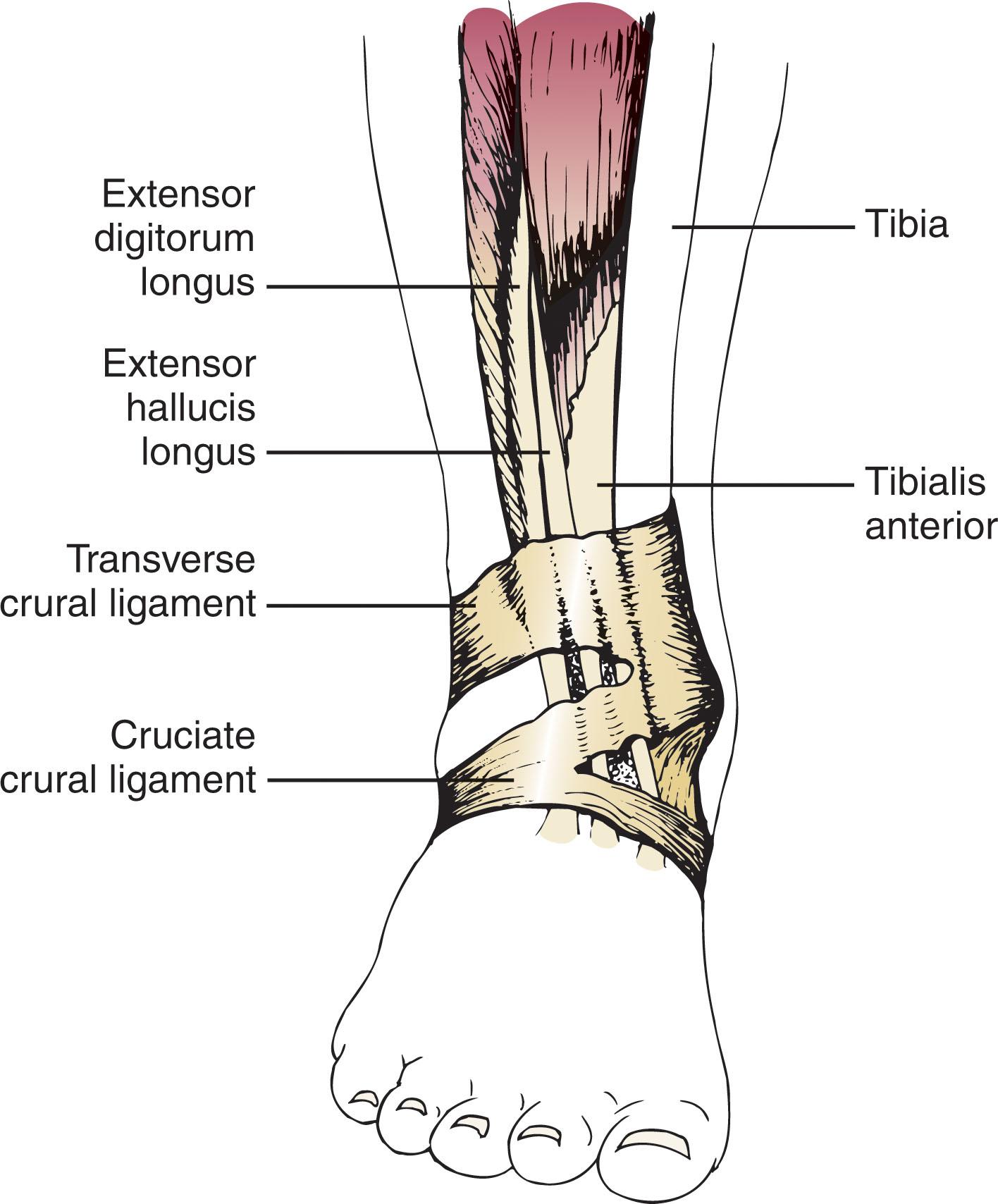
Innervated by the deep peroneal nerve, the anterior tibial tendon functions to dorsiflex and invert the foot and provides controlled plantar flexion at heel strike. The tendon is active in heel-strike phase in an eccentric mode because it allows the ankle to slowly plantar flex until foot flat. It is active again in the swing phase in a concentric mode, dorsiflexing the ankle and keeping the forefoot from dragging. Congenital absence of an anterior tibial muscle and tendon is a rare occurrence and may be associated with clawing of the toes because of recruitment of the EHL and EDL to assist in dorsiflexion of the foot and ankle.
The tendon passes beneath the superior extensor retinaculum and the upper and lower limbs of the inferior extensor retinaculum. Lipscomb and Kelly stated that the tendon had 6 to 7 cm of excursion at this level. Petersen et al investigated the structure and vascular pattern of the tibialis anterior tendon by using injection techniques, light and transmission electron microscopy, and immunohistochemistry. They found a well-vascularized peritenon, with blood vessels penetrating the tendon and anastomosing with a longitudinally oriented intratendinous network. Despite a well-vascularized posterior surface of the tendon, they found an avascular zone where the tendon runs under the superior and inferior retinacula. This results in an area 1 to 2 cm from the insertion that is at risk for rupture. Not only is the tendon vulnerable to spontaneous rupture as it passes beneath these retinacular structures, it is also at risk for injury with fracture of the tibia or a laceration.
An acute disruption of the anterior tibial tendon can occur with trauma at any age from fracture of the tibia or laceration. Three quarters of these disruptions occur in male patients. A spontaneous rupture can occur from an underlying degenerative process. Inflammatory arthritis, gout, rheumatoid arthritis, impingement from an underlying exostosis, a local steroid injection, and diabetes have all been cited as contributing factors in anterior tibial tendon rupture. A ganglion in the region of the anterior ankle can masquerade as a rupture of the anterior tibial tendon, with the formation of an enlarged mass ( Fig. 28-2 ).
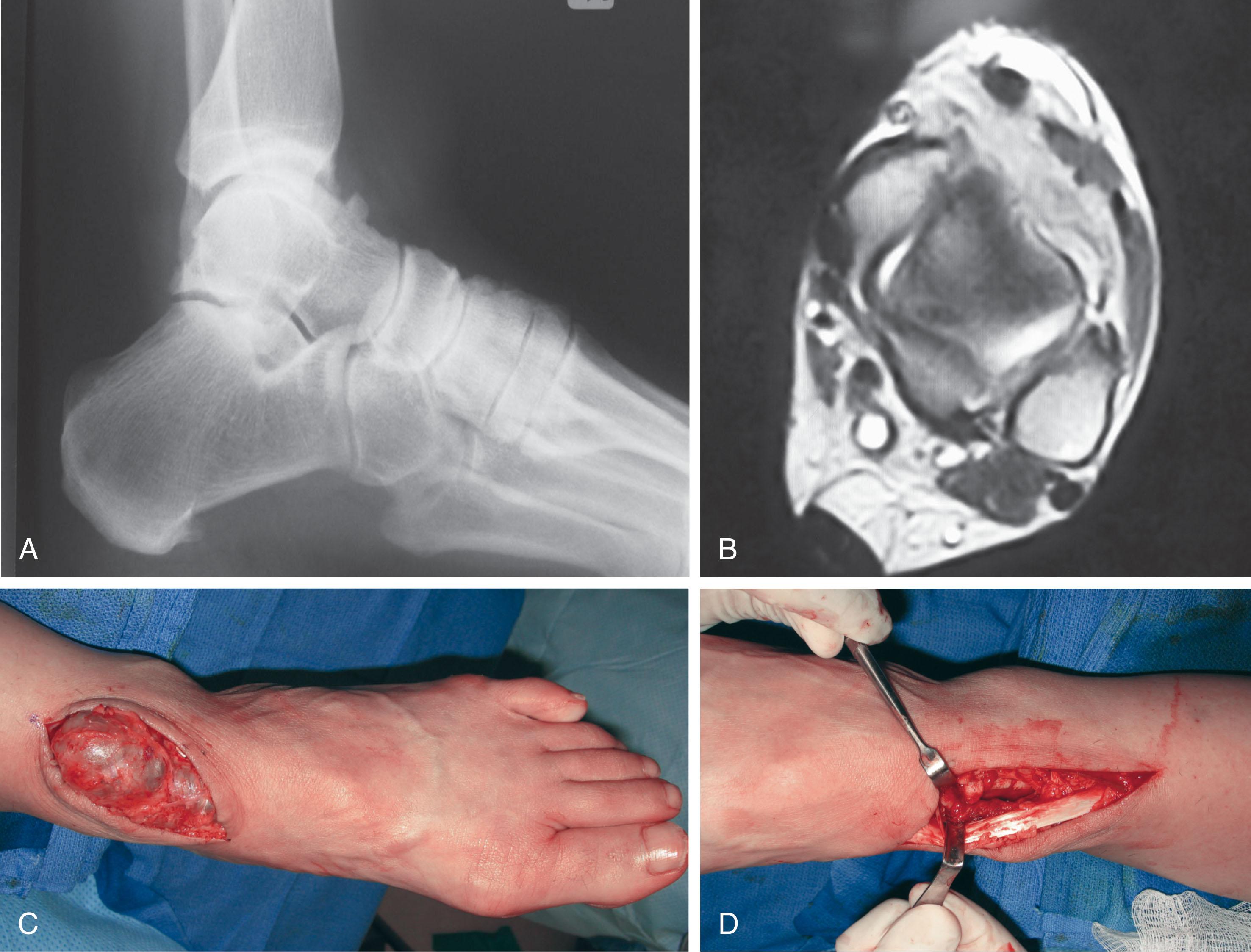
Ruptures occur near the anterior tibial tendon's insertion, most often close to or within 2 to 3 cm of the insertion ( Fig. 28-3 ). They can be caused by chronic wear from an exostosis at the talonavicular, naviculocuneiform, or MTC joints or by attrition from rubbing against the edge of the inferior extensor retinaculum. McMaster noted that ruptures occur in the presence of an abnormal tendon structure, which correlates with the deficiency in the tendon's vascular supply in this portion of the tendon.
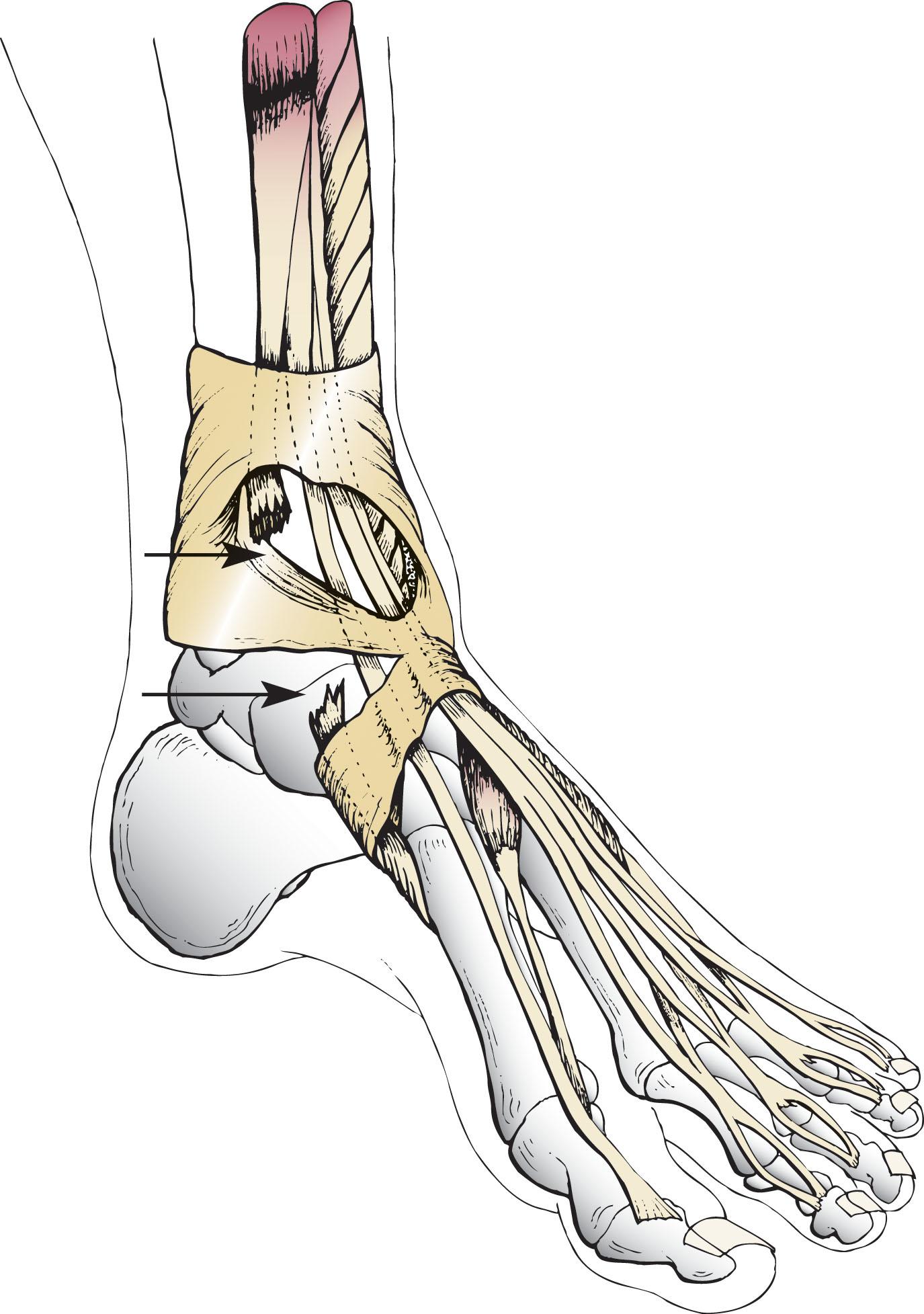
Markarian et al have described “acute on chronic” tears manifesting as a degenerative tear in the anterior tibial tendon. These ruptures usually occur in men between the fifth and seventh decades of life and most often are reported in the seventh decade. A prodromal phase is unusual, and patients do not routinely complain of pain before tendon rupture, though they may notice an enlarged nodule on the degenerative tendon before rupture.
Anterior tibial tendon ruptures occur with forced or excessive plantar flexion against a contracted anterior tibial muscle. An acute rupture usually presents in one of two different ways. With acute trauma in a younger patient who is involved with a higher functional level of activity, the rupture is associated with the acute onset of pain but infrequently with severe trauma. Walking down a ramp or slope can trigger eccentric contracture of the anterior tibial muscle, which may precipitate a tendon rupture. Decreased dorsiflexion strength is noted at the time of injury, which usually prompts the patient to seek medical evaluation and treatment soon after injury. The patient often experiences a snapping sensation that is associated with a brief episode of sharp pain over the anterior aspect of the ankle and is accompanied by swelling. Ambulation may be difficult in the initial few hours after rupture, but the pain subsides rapidly.
On the other hand, an older patient typically has no history of antecedent trauma and often presents several months after the incident with a complaint of a painless footdrop. Frequently, a patient does not remember a precipitating event, and the older patient often is unaware of the condition. Markarian et al reported an average 10-week delay in diagnosis in their series of 16 anterior tibial tendon disruptions. Late diagnosis is common, and permanent disability is rare. A patient might note lack of coordination, a slapping gait, or an inability to clear the toes with ambulation. In time, the anterior tibial muscle atrophies. Both Frigg et al and George et al have reported cases of simultaneous degeneration of the anterior tibial and posterior tibial tendons that required hindfoot arthrodeses and anterior tibial tendon reconstructions.
The anterior tibial tendon, on occasion, may be involved with tendinopathy (tendinitis or tendinosis), as described by Burman, Goldman, and Hamilton. Beischer et al has described a series of 29 cases of tendinosis that were characterized by swelling over the insertion, nocturnal pain, and, on examination, point tenderness over the insertion of the anterior tibial tendon. This may be associated with shoe wear that puts pressure on the tendon at the level of the extensor retinaculum. Beischer et al observed longitudinal split tears in the distal tendon in 19 of 29 cases and typical tendinosis on those that were explored. They found a much higher incidence of involvement in females in this series and speculated that this may be a different clinical entity than the typical patient (typically elderly males) who sustains a spontaneous rupture of the tendon. Beischer et al suggested a provocative “stretch” test to assess tendinosis, which included forced ankle plantar flexion, midfoot eversion, and abduction with a pronation force applied to the foot in an attempt to acutely passively stretch the anterior tibial tendon. A positive test was characterized by aggravation of the typical pain the patient had previously experienced. In a follow-up study on the operated patients in this series, Grundy et al reviewed the results of 12 cases, mostly women, who were explored for tendinosis and longitudinal tears of the distal anterior tibial tendon. Although there was evidence of macroscopic tendinosis in all cases, those with less than 50% degeneration were treated with a debridement while those with greater than 50% degeneration were treated with debridement and an EHL tendon augmentation. Later rupture in those who only had a debridement led the authors to recommend more aggressive reconstruction and use of the EHL augmentation on a routine basis.
Insertional tendinopathy can occur after prolonged walking or running. Besides the localized pain, patients may complain of pain in the anterior ankle and lower leg. At times, it will manifest as anterior “shin splints” or even chronic exertional compartment syndrome. The repetitive eccentric load at the bone tendon interface of the contracted anterior tibial tendon musculotendinous unit during impact on heel strike induces microtears that generate a localized inflammatory response. The condition can be exacerbated while descending slopes or inclines, when the sudden jarring at the insertion of the anterior tibial tendon at the cuneiform is maximized. Avoiding these stresses and wearing cushioned heeled shoes can help the tendon to recover. For more intractable cases, patients will benefit from an ankle–foot orthosis (AFO) or a CAM-boot. Platelet-rich plasma derived from peripheral blood or bone marrow injected at the tendon insertion has been proposed in conjunction with immobilization when bracing alone is unsuccessful. Steroid injections at this location should be avoided to minimize the risk of tendon rupture.
A patient with anterior tibial tendon rupture often complains of swelling of the anterior ankle and foot, has weak dorsiflexion, and reports catching the foot on irregular or uneven ground. These footdrop symptoms may be significant or minimal. The mild pain associated with a tendon rupture usually subsides quickly. Swelling of the anterior ankle can disguise the rupture, although with time a palpable defect becomes apparent. A fixed lump or mass on the anterior ankle can develop from the bulbous end of the proximal tendon segment ( Fig. 28-4 ). The proximal tendon often retracts to the level of the ankle joint, and the mass is found deep to the extensor retinaculum and is often adherent to the synovial sheath. Typically, the area of the anterior tibial tendon lacks normal contour as it crosses the ankle.
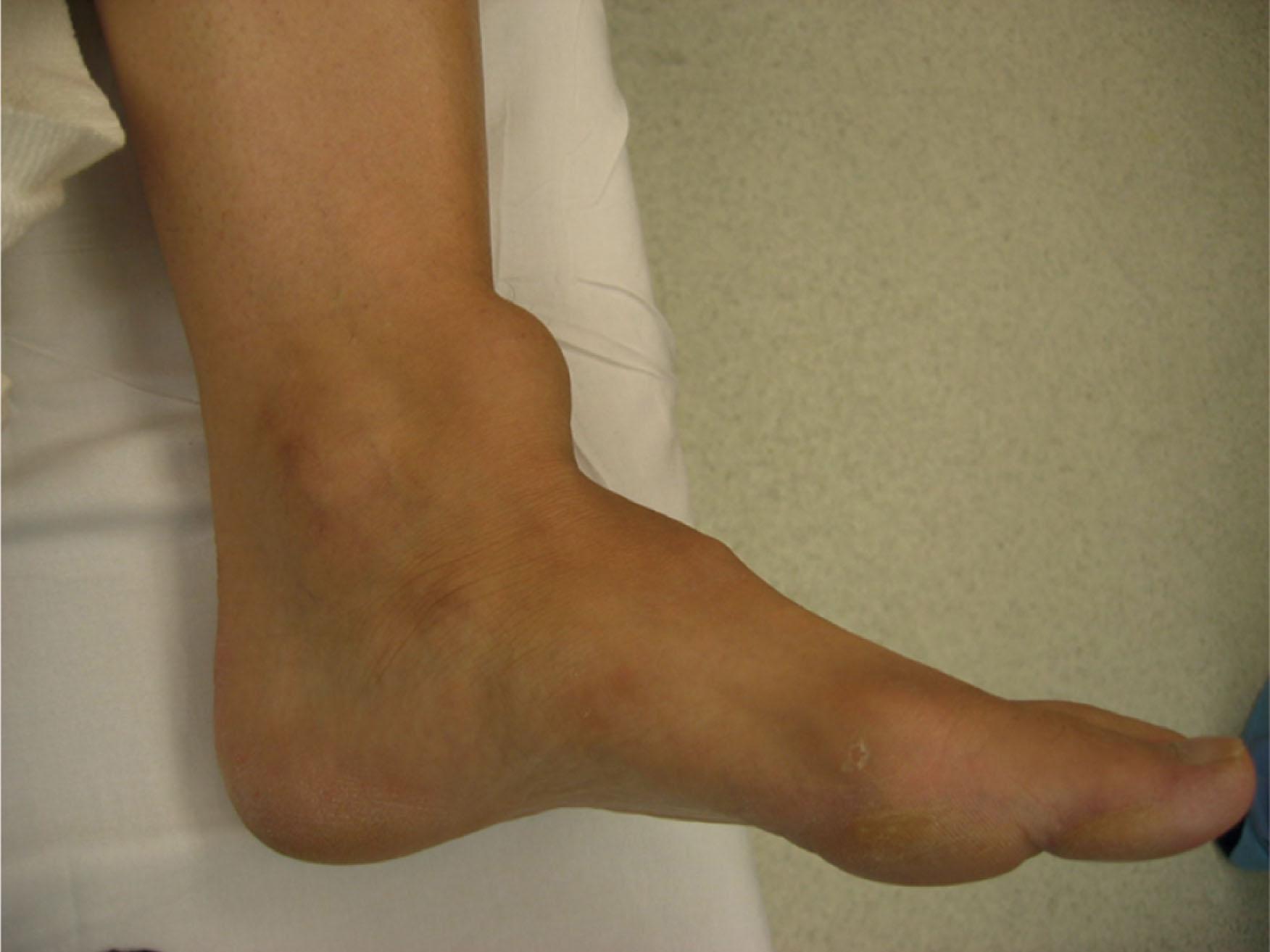
A lack of dorsiflexion power might not be appreciated by the examiner unless muscle strength is compared with the contralateral side ( Fig. 28-5 ). However, weakness in dorsiflexion against resistance can make the diagnosis more apparent. The patient is typically unable to walk on their heels. Many patients are able to dorsiflex the ankle using the remaining dorsiflexors (EHL, EDL), and Moberg has reported that anterior tibial tendon function can be replaced to a large extent by the toe extensors. Patients often do not recognize anterior tibial dysfunction because of the remaining dorsiflexion power of the EHL and EDL and do not seek treatment until many months after injury ( Fig. 28-6 ). The compensation by the toe extensors may lead to clawing of the lesser toes and hallux. Typically, with an attritional rupture, the anterior tibial tendon becomes attenuated. There is a subtle loss of power initially. When examining the patient's dorsiflexion strength, the ankle and foot dorsiflex, but the first metatarsal remains relatively plantar flexed because of an imbalanced peroneus longus. The ankle may achieve a neutral position, but often there is valgus of the forefoot and eversion at the midfoot, with relative weakness of dorsiflexion and inversion ( Fig. 28-7 ).
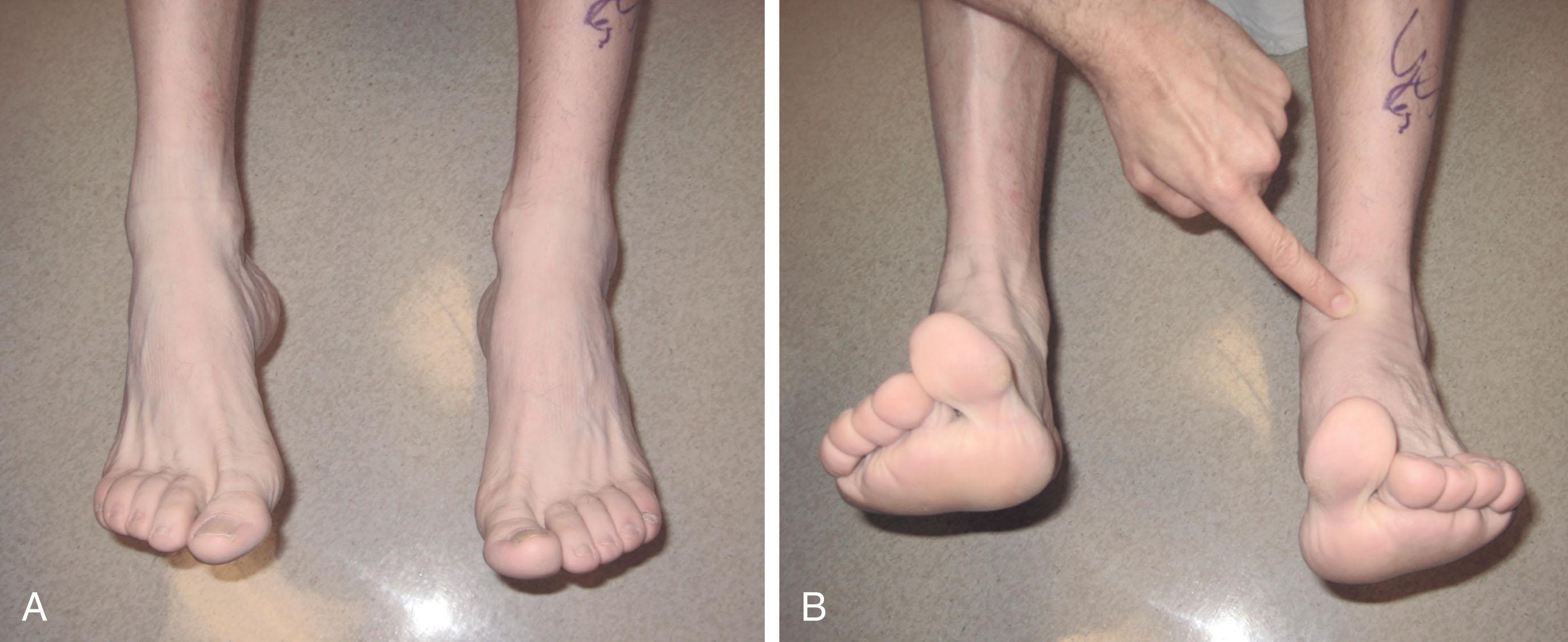
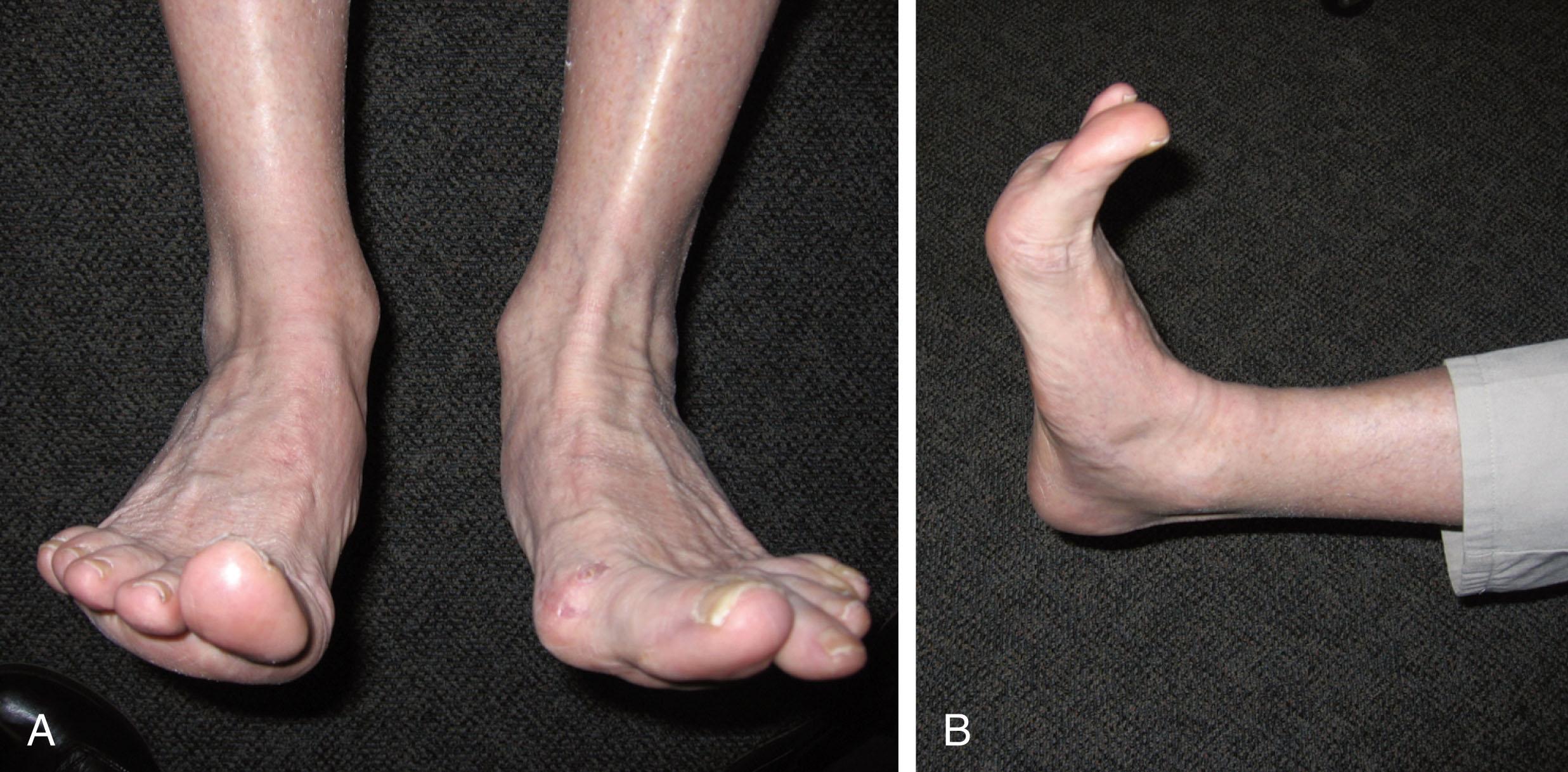
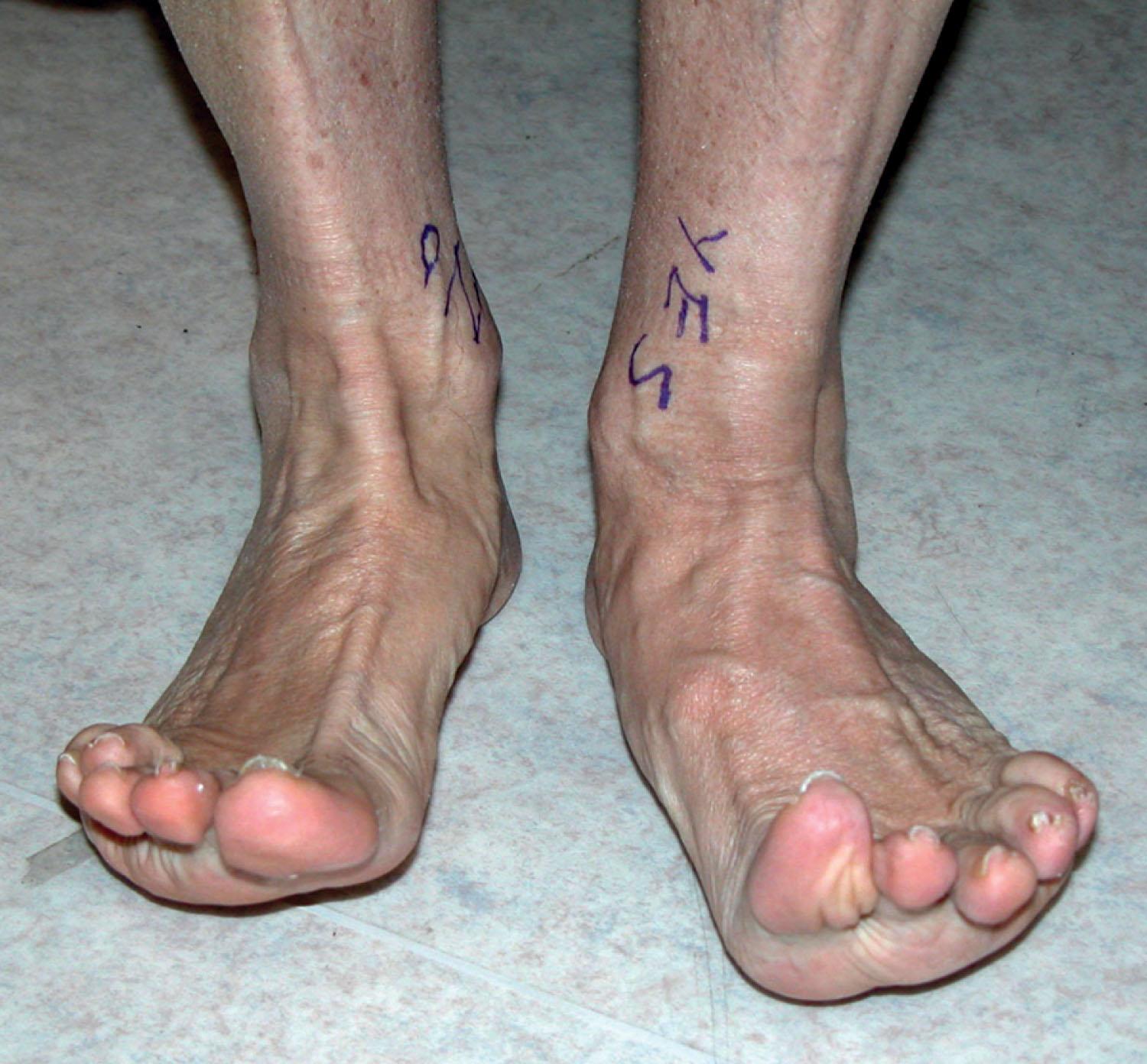
Without anterior tibial tendon function, a gait disturbance typically occurs. With a footdrop, footslap, or steppage gait, typically after heel strike, the patient is unable to plantar flex the foot slowly in a controlled manner. The abnormal gait occurs with ambulation as the patient attempts to clear the toes from catching on the ground.
Mensor and Ordway reported a slight loss (10–15 degrees) of dorsiflexion after anterior tibial tendon rupture. Burman and Moberg reported development of a spontaneous flatfoot deformity after anterior tibial tendon rupture.
This condition can be misdiagnosed as a peroneal palsy or confused with an L4-5 radiculopathy. Peroneal nerve palsy and lumbar disk syndrome can easily be ruled out on neurologic examination with normal sensation on the dorsum of the foot, normal sensation in the first web space, and normal function of the other extensor tendons with active dorsiflexion of the toes. Heel varus and eversion weakness in conjunction with the loss of dorsiflexion suggests a common peroneal nerve palsy or radiculopathy and makes the diagnosis of tibialis anterior rupture unlikely. In patients with acute anterior tibial disruption, the injury is often associated with laceration or a distal tibial fracture. Open injuries after a fracture or laceration can occur but require assessment of motion and strength of the anterior tibial tendon so that a tendon disruption is not overlooked. Surgical exploration of traumatic wounds should be considered if there is any notion of weakness, a gap, or deformation of the anterior ankle. Mechrefe et al have reported a case of a distal tibial fracture and a simultaneous avulsion of the anterior tibial tendon insertion, with entrapment of the tendon within the fracture site ( Fig. 28-8 ).
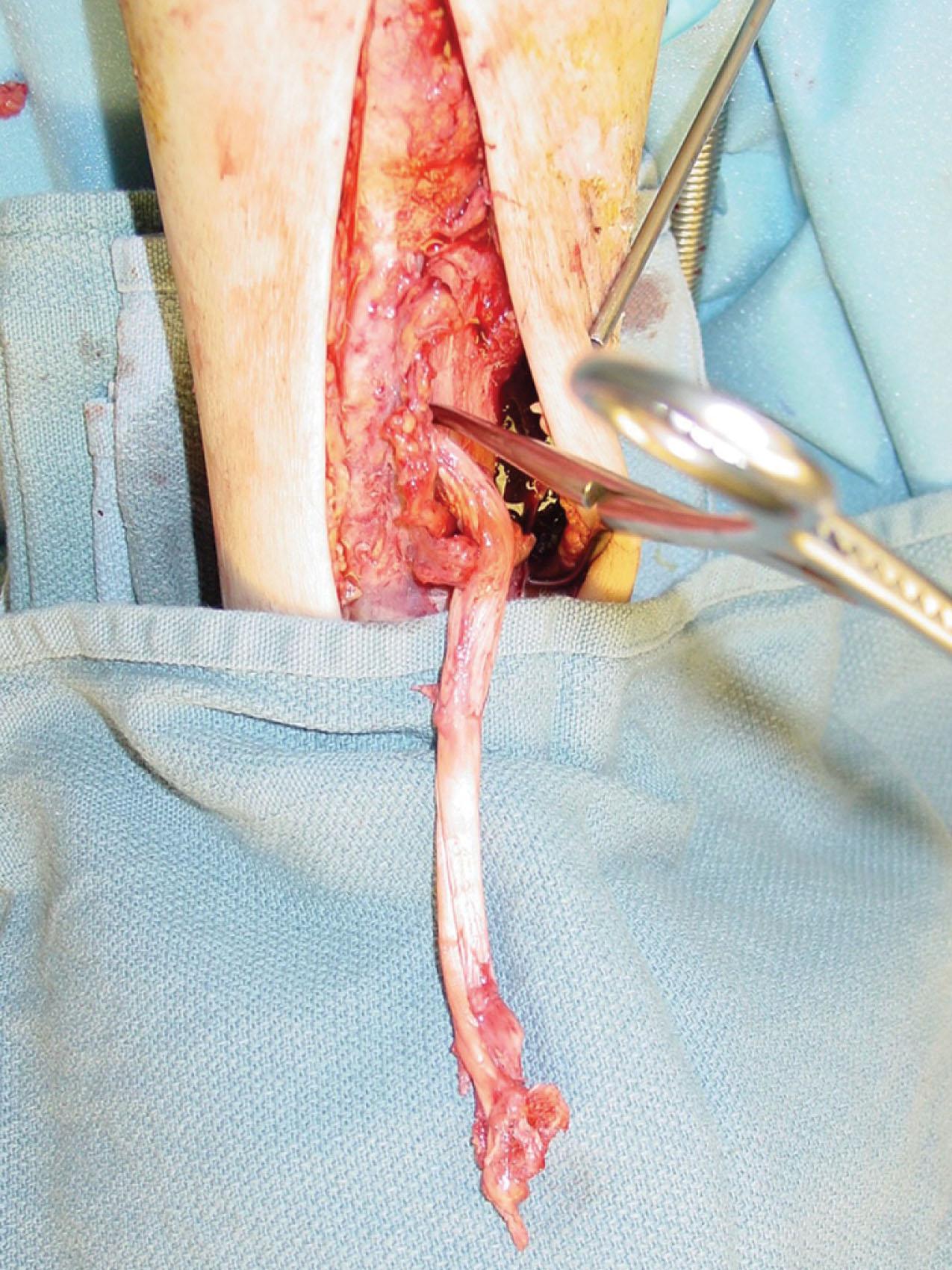
Magnetic resonance imaging (MRI) can be helpful in defining an anterior tibial tendon rupture. Normal tendons have a low signal intensity and contrast well with surrounding fat, which has a high signal intensity. Both sagittal and axial images are helpful. In patients presenting late, who do not recall a precipitating accident or event, MRI can be helpful in making a diagnosis of rupture or tendon degeneration ( Fig. 28-9 ).
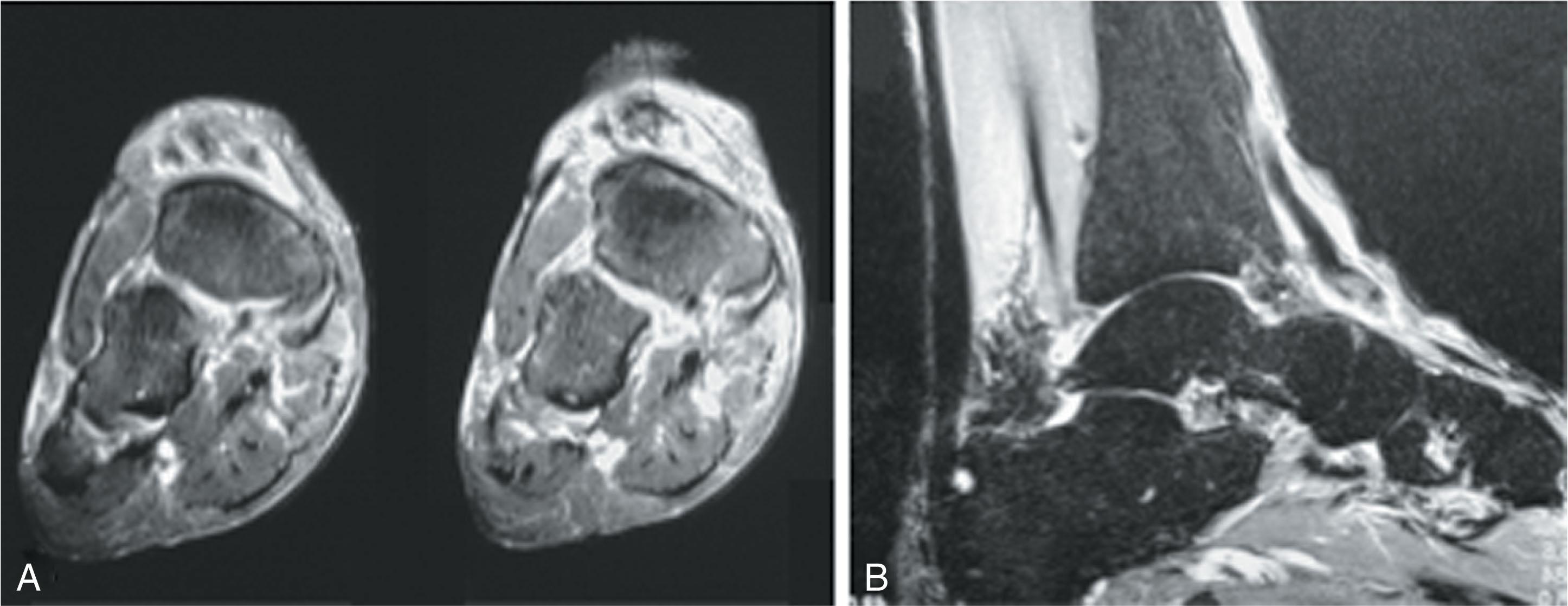
Ruptures of the anterior tibial tendon are uncommon. No consensus in the literature appears to exist regarding recommendations of surgical versus nonsurgical treatment; however, foot and ankle experts generally agree that surgical repair is reasonable to achieve the ultimate goal of improved function without a brace. When an anterior tibial tendon rupture is diagnosed early in a younger active patient, surgical repair is likely to improve ambulation and decrease morbidity. Treatment of a chronic rupture is more controversial and appears to lead to unpredictable results. Unfortunately, ruptures in older patients are often initially unnoticed.
For the older patient, a polypropylene AFO or a double upright brace may be prescribed to minimize the chances of tripping and causes further injury. Over the counter low profile “foot-drop” braces and elastic devices that attach to the shoe are routinely available as well. Compliance in the older patient can be difficult. Ouzounian and Anderson noted that of five patients treated conservatively, three refused a brace or found it too restrictive. Two patients who used a brace found it improved their level of activity. In elderly, sedentary patients with a low level of activity, a normal gait pattern actually may be achieved, justifying conservative treatment. Markarian et al found no significant difference in the conservative and surgical treatment in elderly patients and suggested that nonsurgical treatment was a viable option and “should not adversely affect overall foot and ankle function.”
However, with nonsurgical treatment, the proximal tendon segment usually becomes adherent in the area of the anterior ankle, leading to loss of ankle dorsiflexion strength and motion. Decreased dorsiflexion strength, lack of coordination or a slapping gait, and progressive flatfoot deformity may be associated with nonsurgical treatment. Although full functional recovery might not be obtained, function and gait in the older, less active patient may be acceptable, particularly with an AFO brace that allows clearance of the toe in swing phase and prevents foot slapping at heel strike.
For patients who want a higher level of function or do not tolerate AFO bracing, surgical repair is indicated. Surgical intervention can entail direct repair for the acute rupture or reconstruction of the anterior tibial tendon with either a sliding graft, tendon transfer, or an interposition tendon graft for delayed treatment.
In summary, both surgical and conservative treatments have been advocated for anterior tibial tendon ruptures, and treatment should be tailored to the individual patient depending on age, level of activity, time elapsed since the rupture occurred, current level of disability, and local and systemic contraindications to surgery. Nonsurgical treatment is preferred in the older patient with fewer demands, and surgical repair is typically indicated in the younger and middle-aged active athlete. Markarian et al concluded that although primary repair is the optimal treatment for a ruptured anterior tibial tendon, when diagnosis is delayed longer than 4 weeks, the treating physician should “ consider the physical demands and goals of the patient” before automatically recommending surgery.
With a laceration of the anterior tibial tendon, the proximal segment may be found anywhere along the course of the tendon. Often it retracts to the level of the ankle joint. With a rupture, the proximal stump is often found deep to the extensor retinaculum and is often adherent to the synovial sheath. The site of the rupture is typically just proximal to the site of the tendon insertion and just distal to the inferior border of the superior extensor retinaculum. In these cases, direct surgical repair is recommended. Other authors have recommended a direct repair of the anterior tibial tendon.
For attritional tears, the technique of repair and reconstruction depends on the pathologic process present and the time delay in diagnosis. Reinsertion into the navicular with a suture anchor or into a bony tunnel are alternatives with an avulsion fracture or distal rupture. Ouzounian and Anderson recommended a direct repair with reinsertion of the anterior tibial tendon into bone.
With delay in diagnosis and retraction of the proximal tendon stump or with injury to a large segment of tendon, direct repair may be impossible. Tendon reconstruction is then an option. A sliding graft with partial tendon advancement, free tendon graft, or tendon transfer are surgical options for reconstruction. Tendon transfers include EHL or split posterior tibial tendon. Although the tendon may be advanced through a drill hole, it may be reinforced with an interference screw, suture button, bone anchors or a pull-out wire as well. If the Achilles is determined to be too contracted, with a 10- to 15-degree difference compared with the contralateral side, an Achilles lengthening or Strayer procedure may be beneficial.
The technique is as follows.
The patient is placed in a supine position with a thigh tourniquet for hemostasis as warranted. An anterior curvilinear incision is made on the inferomedial aspect of the anterior tibial tendon and extended from the level of the first cuneiform proximally to the level of the superior extensor retinaculum.
The anteroinferior extensor retinaculum is divided, and the anterior tibial tendon is identified and traced to its insertion in the first cuneiform. A square wave cutting of the more proximal retinaculum may be indicated to facilitate repair of the retinaculum to prevent bowstringing of the tendon ( Fig. 28-10 ).
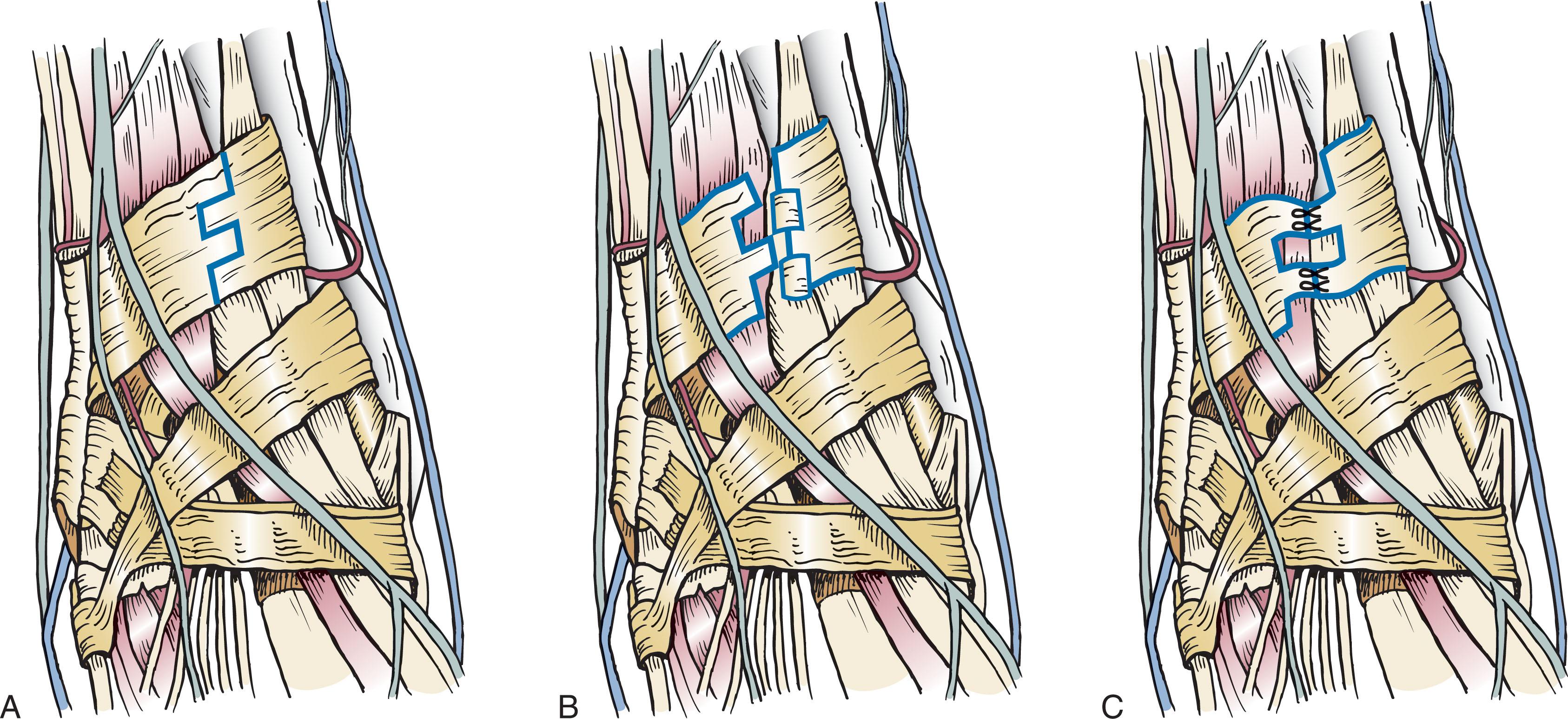
The dorsalis pedis artery and deep peroneal nerve lie on the lateral aspect of the EHL, and the dissection is deepened on the medial aspect of the EHL to protect the neurovascular bundle.
Because the proximal stump of the tendon often retracts to the level of the ankle joint after rupture, exploration should proceed proximally to identify the end of the tendon. With a rupture, the proximal stump is often found deep to the extensor retinaculum and is often adherent to the synovial sheath. The site of rupture is typically just proximal to the site of the tendon insertion and just distal to the inferior border of the superior extensor retinaculum. The tendon sheath is incised longitudinally and the hematoma debrided ( Figs. 28-11A and 28-12A and B ).
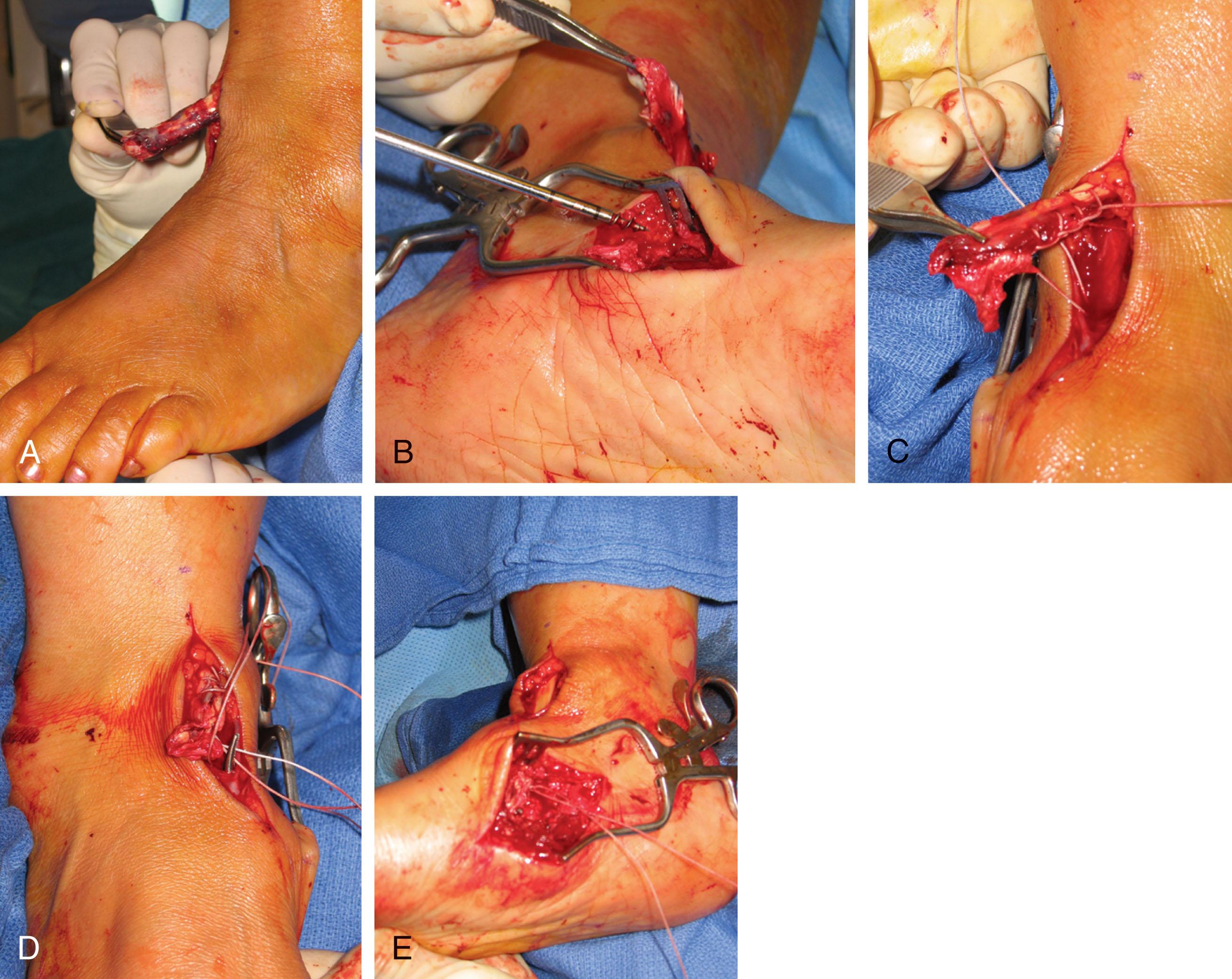
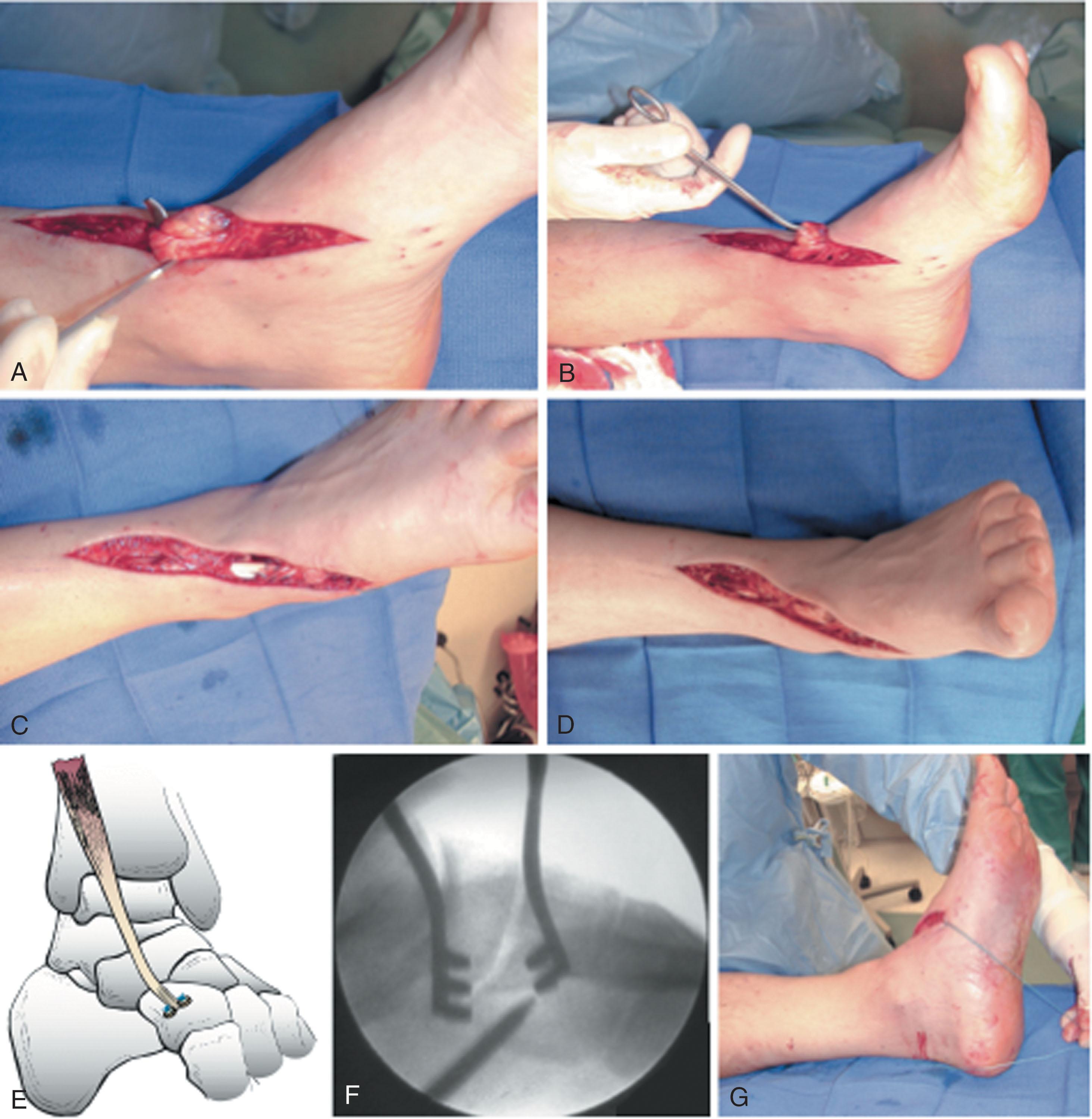
The proximal tendon end is grasped and pulled. If there is no springiness to the musculotendinous complex, then a tendon transfer may be necessary (see Alternate Techniques).
(Primary repair) After debridement of the tendon ends, a No. 1 nonabsorbable suture is used to approximate the tendon ends with a Bunnell, Krackow ( Figs. 28-11B and 28-13 ), or modified Kessler technique ( Fig. 28-12C ). The tendon edges are then oversewn with an interrupted absorbable suture.
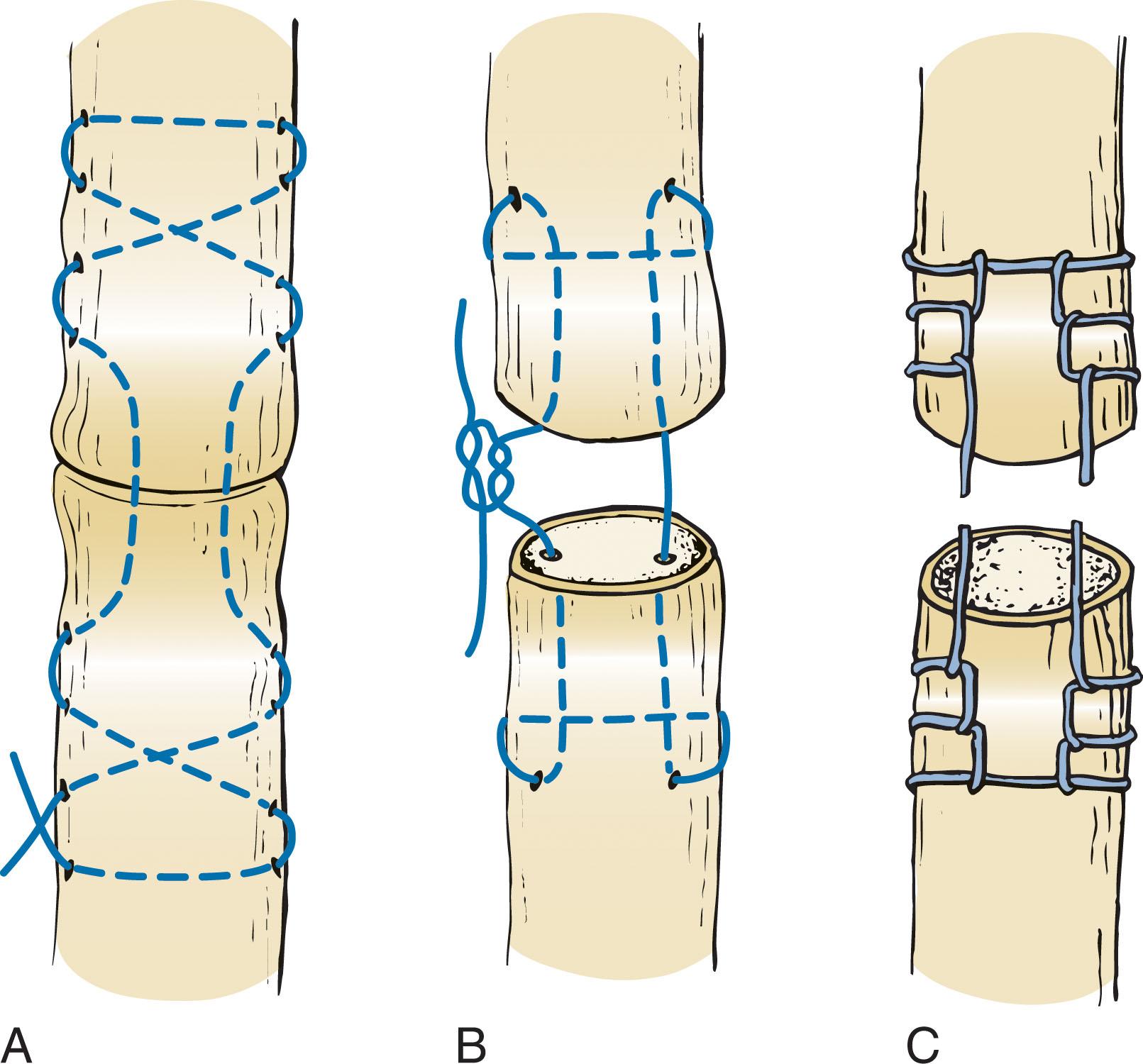
If the tendon has avulsed or is lacerated from its distal attachment, a suture anchor can be inserted into the cuneiform and the tendon secured to the periosteum. The periosteum should be elevated locally and the bone drilled or chiseled to activate a more robust healing response ( Figs. 28-11C and 28-12D–F ). If adequate length is available, it can be passed through an osseous tunnel and secured with the suture anchor ( Fig. 28-11D and E ). Alternatively, a suture button technique or interference screw can be used to secure the tendon in a bony tunnel. This is particularly helpful if there is limited length of tendon and the repair is under tension.
If there is a gap of 2 to 4 cm between the tendon ends, the anterior tibial tendon may be lengthened using a sliding anterior tibial tendon graft that spans the rupture site, anastomosing the proximal and distal segments of the tendon ( Fig. 28-14 ). The length of the anterior tibial tendon typically is adequate such that a sliding graft using half of the proximal tendon is adequate to bridge the graft. With the ankle held in dorsiflexion and the tendon ends pulled toward each other, the gap is measured. The length of the graft harvested should permit an overlap of 1.5 cm for each anastomosis. Thus, for a gap of 4 cm, a 7-cm section of proximal tendon is harvested that includes 3 cm for the overlap (1.5 cm at each anastomosis). When the proximal stump of the anterior tibial tendon is of insufficient length for repair, the adjacent EHL or EDL tendon or an allograft can be used as a graft to span the defect. Next, half the width of the tendon is harvested from the proximal tendon over the predetermined length and transferred distally as a free graft. A modified Bunnell, Krackow, or Kessler suture is used to anastomose the tendon graft at the proximal and distal ends (see Fig. 28-13A–C ). The ankle is held in a neutral position during the repair and until the splint is applied in a neutral position at the conclusion of the reconstruction. The sliding graft can leave a scar beneath the more proximal extensor retinaculum.
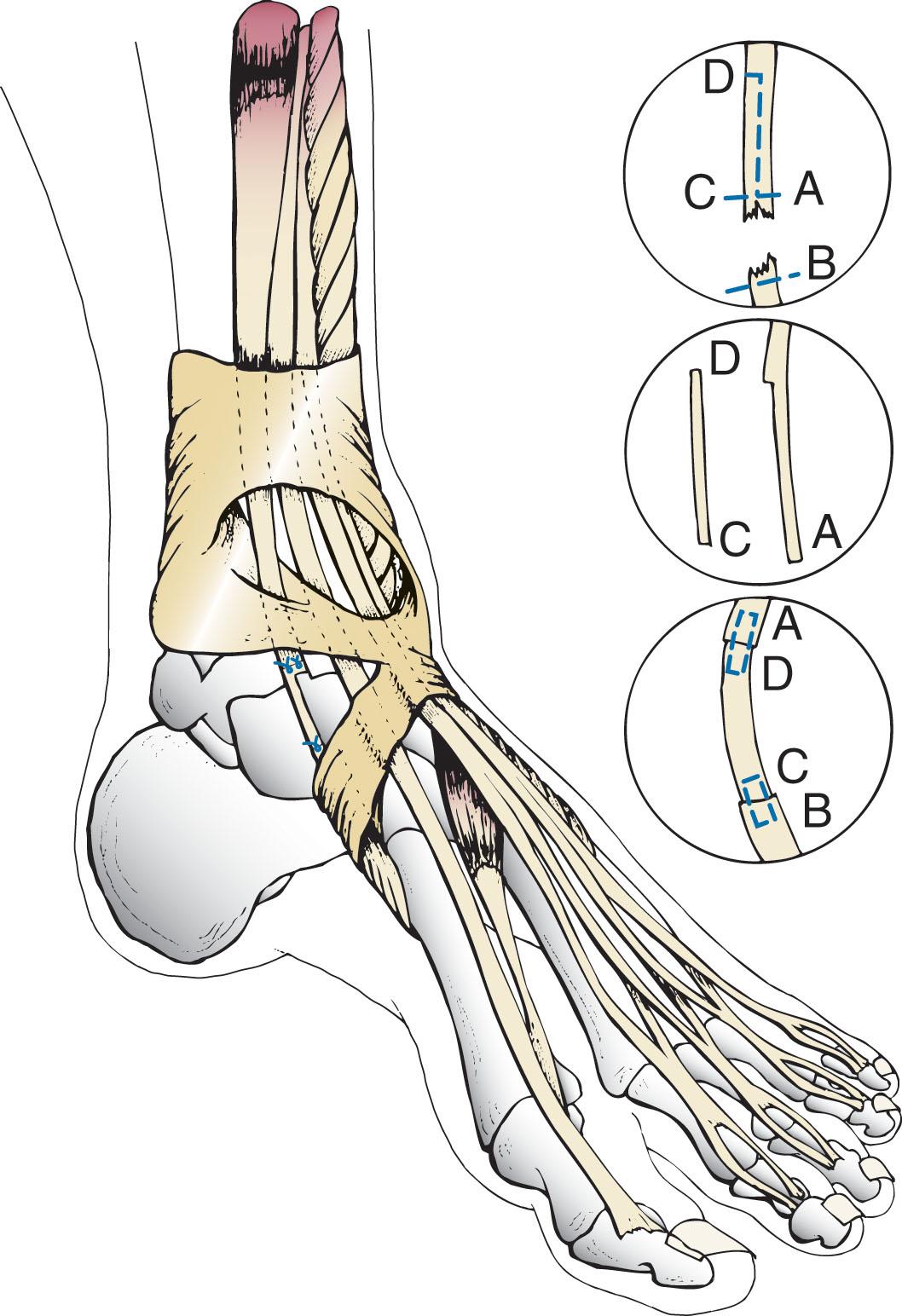
(Turn-down anterior tibial tendon graft) Turn-down tendon grafts have been advocated, as well, to bridge or span deficient areas. The technique is similar to the sliding graft (see 6C) but instead of completely releasing the graft from the proximal tibialis anterior tendon, it is realeased only proximally and flipped over on itself distally to achieve the desired length.
The synovial sheath is repaired, but the inferior extensor retinaculum is not repaired to prevent formation of adhesions ( Fig. 28-12G ).
The skin is approximated in a routine manner.
The technique is as follows.
The patient is placed in a supine position with a thigh tourniquet for hemostasis as warranted. An anterior curvilinear incision is made on the inferomedial aspect of the anterior tibial tendon and extended from the level of the first cuneiform proximally to the level just distal to the extensor retinaculum at the ankle.
The distal aspect of the tendon is debrided. If the proximal aspect of the tendon is not accessible for primary repair, the decision is made to proceed with a tendon transfer.
An incision is made over the anterior distal leg over the tibialis anterior tendon extending proximally from the superior aspect of the superior extensor retinaculum. The sheath is open and the underlying tibialis anterior tendon is identified, taking care to protect the EHL and neurovascular bundle. The proximal end of the tear is pulled into the proximal incision and debrided. This may require some debridement of the bulbous end of the tendon in the distal incision.
A graft is chosen and whip-stitched at both ends. Options include a peroneus brevis graft, hamstring autograft or allograft, palmaris longus autograft, or other suitably sized grafts.
Distally, the graft is either secured to the tibialis anterior tendon stump using a Pulvertaft weave, secured to the medial cuneiform through a bone tunnel using an interference screw, or both ( Figs. 28-15 and 28-16 ).
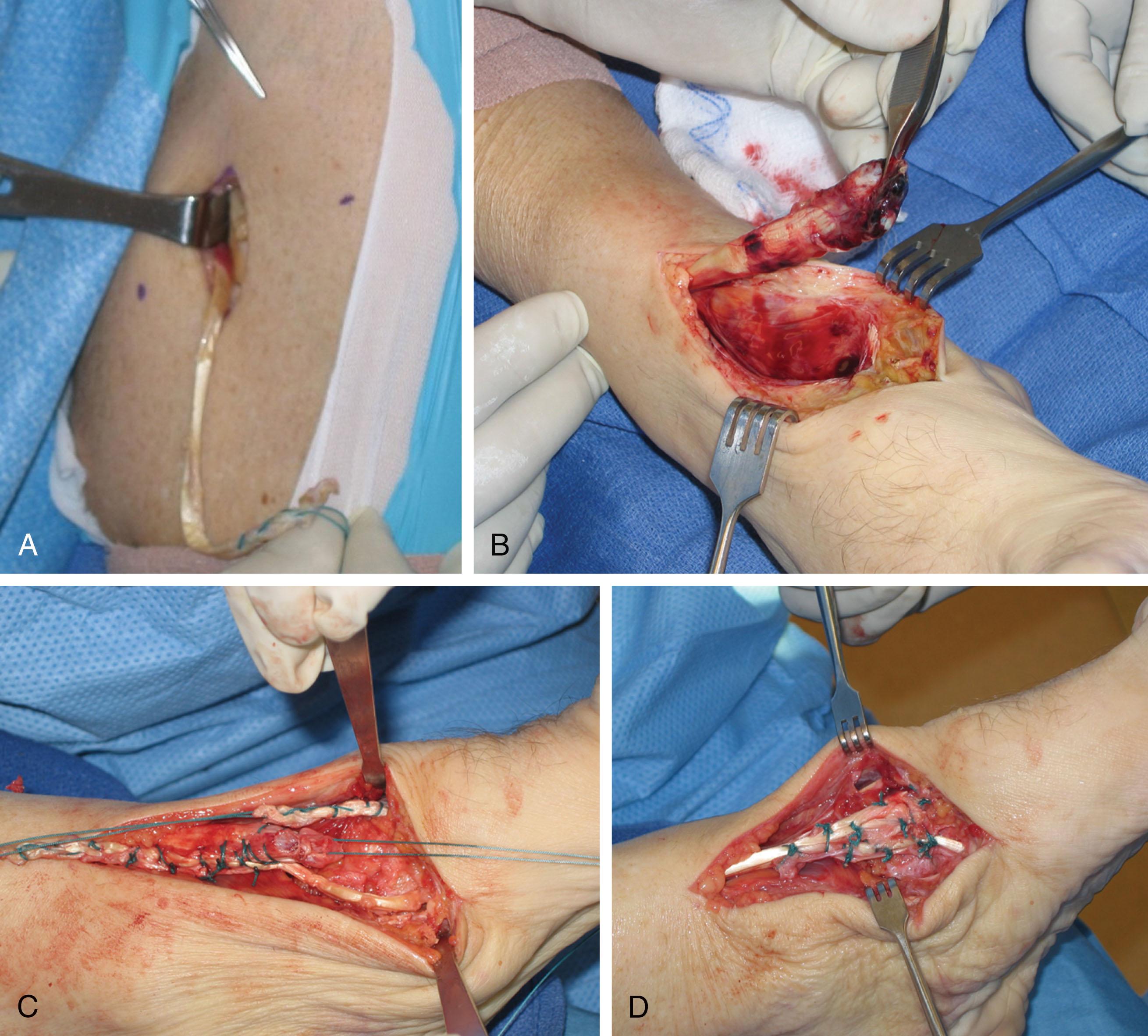
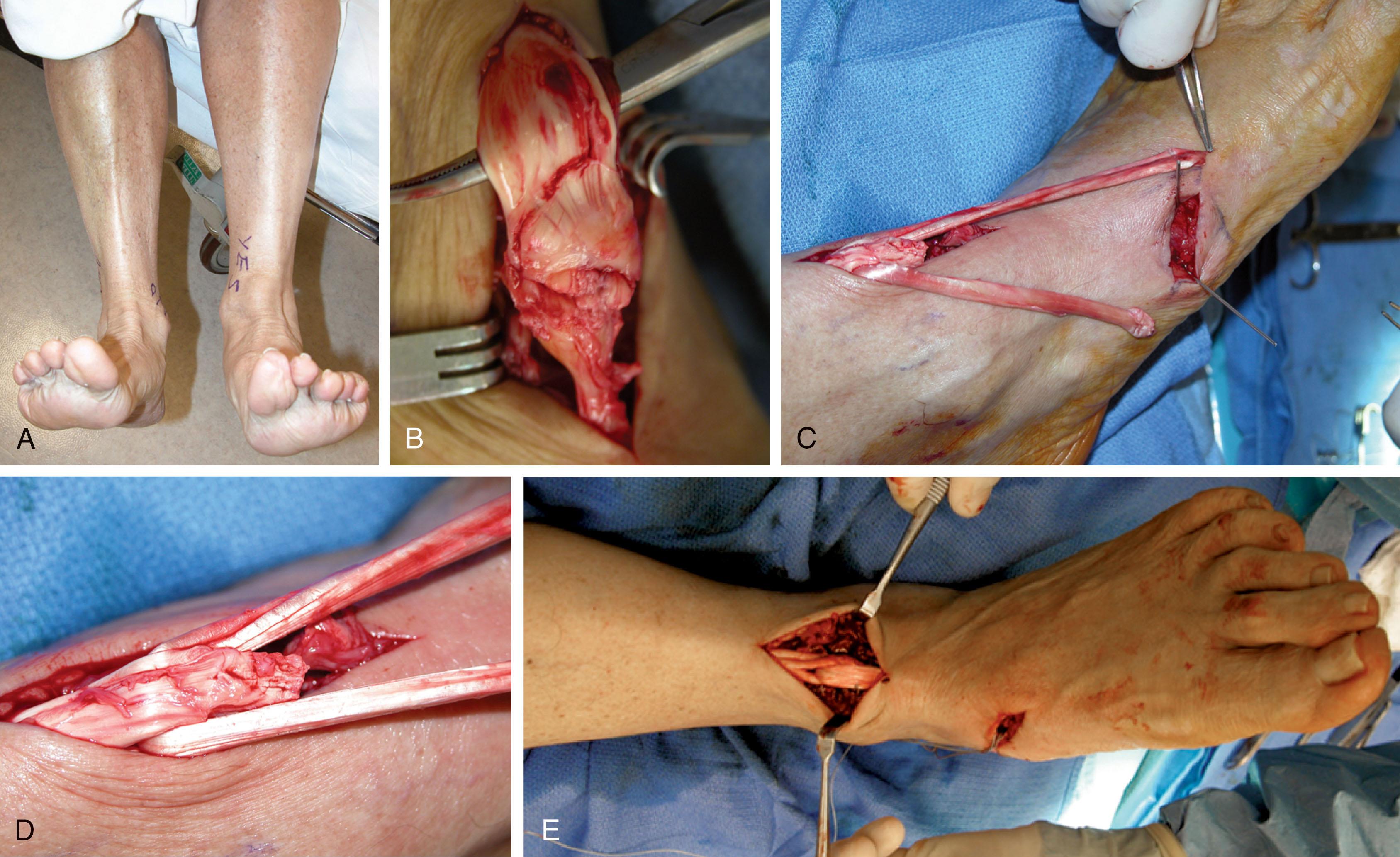
The tendon graft is passed from the distal to the proximal incision under the extensor retinaculum using a long clamp, making sure scar tissue within the soft tissue tunnel has been debrided. An arthroscopy grasper works well for passing the tendon.
In the proximal incision, the foot is held in a dorsiflexion while the graft is passed through the native tibialis anterior tendon using a Pulvertaft weave technique. With the appropriate tension the tendons are tenodesed using nonabsorbable #1 or #2 suture. Place the weave proximal enough so that it does not pass under the extensor retinaculum with the ankle plantarflexed. Remove any extra tendon graft.
The synovial sheath is repaired and the skin is approximated in a routine manner.
The technique is as follows.
A similar exposure is used as described for the technique of a primary repair.
After the fibrous tissue and hematoma are debrided at the rupture site, the EHL tendon is dissected distally at the level of the first MTP joint and is anastomosed to the extensor hallucis brevis tendon before transection ( Fig. 28-17A and see Fig. 28-18D ).
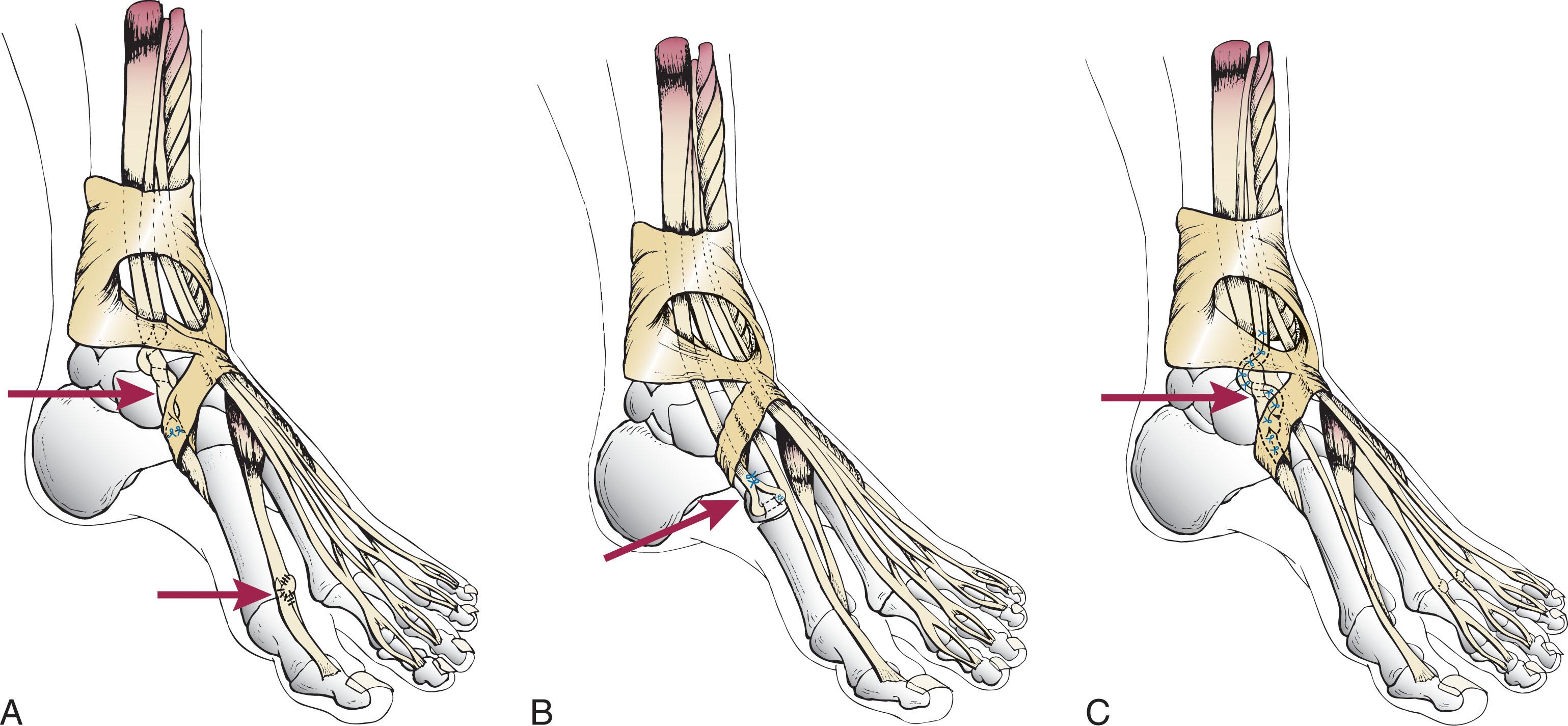
The proximal stump of the anterior tibial tendon is sutured to the adjacent EHL tendon, providing that the musculotendinous unit is not fibrotic.
The EHL tendon is divided distally and tenodesed to the EHB tendon ( Fig. 28-18 ).

The EHL tendon is tunneled into the cuneiform and tensioned with the ankle in dorsiflexion. A horizontal or vertical drill hole is made in the first cuneiform, and the tendon is passed through the bony tunnel and fixed with either a pull-out wire or a bone anchor ( Fig. 28-17B and C ). Because the EHL graft is long, it is possible to drill from the first cuneiform to the third, exiting just dorsal to the cuboid laterally. This tunnel can be drilled using the guidewire for the cannulated 6.5-, 7.0-, or 7.3-mm screw systems and then overdrilled once a proper position is established with the set's cannulated drill bit. Using a suction tip or suture passer from the lateral side, the sutures in the EHL tendon can be passed from medial to lateral.
The EHL tendon is sewn to itself and/or secured with a tenodesis screw while tension is applied to the graft with the ankle held in dorsiflexion. A soft tissue interference screw can be inserted medially and, if necessary, an additional one can be inserted laterally.
The sutures that had been placed in the EHL tendon should be passed through the bone and tied, if the tendon is not secured to itself.
In the presence of a tendon avulsion from the medial cuneiform insertion or with minimal tendon retraction, the tendon can be advanced and reinserted through a drill hole or with a suture anchor in the first cuneiform. Another option is an extensor tendon transfer to augment the anterior tibial tendon reconstruction, performed with direct repair or turn-down/slide reconstruction ( Figs. 28-18 and 28-19 ).
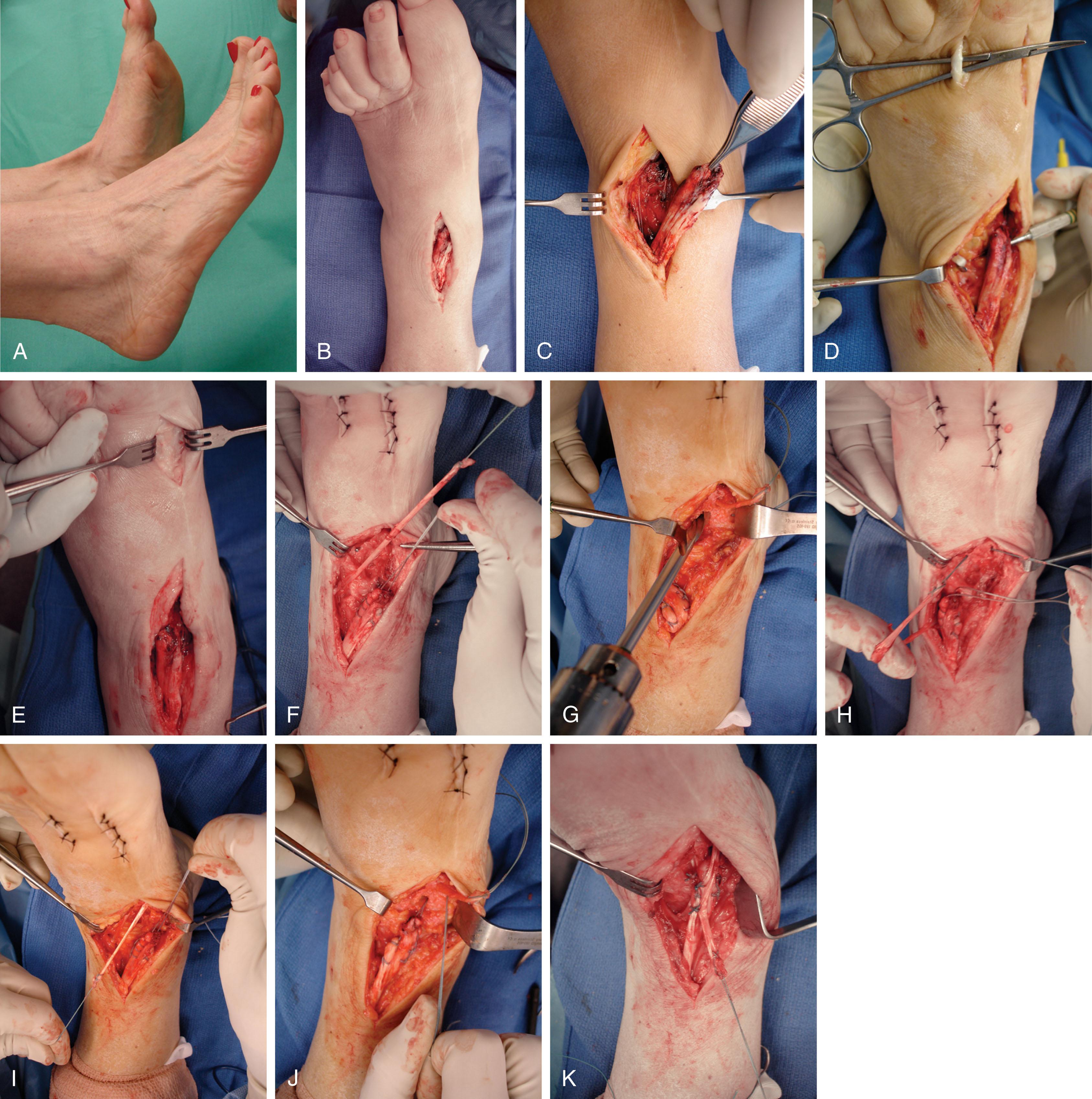
Kelikian and Kelikian suggested transferring the EDL tendon of the second and third toes to the distal stump of the anterior tibial tendon. A tenodesis of the EDB to the distal stumps of the EDL of the second and third toes is then performed ( Fig. 28-17C ). A technique using a split posterior tibial tendon transfer has also been described. Forst et al used a peroneus brevis tendon transfer, tenodesing the peroneus longus and brevis proximally. Then they resected a 9-cm segment of peroneus brevis, using this as a free graft to bridge the defect at the site of the anterior tibial tendon rupture. If the anterior tibial muscle is no longer viable because of fibrosis, the peroneus longus can be used. It is harvested distally by the cuboid and passed from posterior behind the fibula into the anterior compartment and then inserted into the lateral cuneiform. Larger traumatic defects may be spanned using autogenous hamstring graft ( Fig. 28-20 ).

A below-knee cast or splint is applied with the foot in maximum dorsiflexion. Weight bearing and walking is permitted in a cast, boot brace, or an AFO 2 to 3 weeks after surgery. Immobilization is continued for 12 weeks during the day and at night as well. For those who object to wearing their boot at night because of bulkiness or for hygiene reasons, a more open “breathable” lightweight padded or air-cushioned night splint can be worn. Dorsiflexion exercises with deep knee bends, performed five times a day for 20 minutes for each episode, can maintain muscle tone and prevent development of an Achilles contracture. Full range-of-motion exercises are initiated 6 to 8 weeks after surgery. Progressive resumption of walking without the brace is initiated 8 to 12 weeks after surgery. The patient is cautioned to avoid jumping, running, or aggressive athletic activity for at least 12 to 16 weeks after surgery, after which jogging, jumping, running, or aggressive athletic activities are initiated as tolerated.
Comparisons between different repair techniques are unable to show a difference in outcome. A prospective multicenter cohort study conducted at four Foot and Ankle clinics reported on 48 patients treated surgically with either direct repair (27 patients) or grafting with the EHL (11 patients) or semitendinosis (10 patients). This mixed group of patient with acute and chronic injuries demonstrated improved activity levels without a significant difference seen between repair types. Younger patients had a higher probability of reporting fair outcomes, perhaps related to the decreased physical demands in the older age groups. Ellington et al reported on 15 anterior tibial tendon ruptures after primary repair or tendon transfers (EHL or EDL), noting the clinical results were favorable despite residual weakness of 21.8 lbs/in 2 on the operative side compared to 28.8 lbs/in 2 on the nonoperative side. There were no significant differences in ROM or plantar flexion strength in patients between those undergoing primary repair versus tendon transfer at an average followup of 27.2 months.
Other results of tibialis anterior tendon repair or reconstruction are primarily small mixed case series and case reports. Most studies recommend surgical reconstruction for a symptomatic patient with moderate or greater levels of physical activity. Other than failure of reconstruction, no significant complications have been reported in the literature. The patient should be alerted to potential complications, including adhesions, rerupture, neuroma formation, and decreased function not only at the rupture site but also at the donor site, where a tendon is harvested to aid in the anterior tibial tendon reconstruction.
Karnovsky reported on the outcomes of eight patients undergoing anterior tibial tendon reconstruction with hamstring autograft at an average follow-up of 17.3 months, finding persistent deficits in dorsiflexion strength, improved functional scored, and all patients able to ambulate without a brace. Morris et al reported that patients with repaired anterior tibial tendons had weakness in dorsiflexion relative to the contralateral side. Despite finding a 75% average peak torque strength and 62% of work capacity compared with the contralateral side, there was no functional impairment. Kopp et al reported on the treatment of 10 anterior tibial tendon ruptures with primary repair or augmentation with either an EHL or EDL tendon transfer, noting that even with a repair of the ruptured tendon, there remained a decrease in strength on the operative side when the average peak torque in dorsiflexion was measured. Sammarco also reported favorable results following surgical treatment of 19 anterior tibial tendon ruptures in 18 patients across a wide age range of 21 to 78 years of age, noting 5/5 strength in 15 patients, 4/5 strength in three patients, and 3/5 strength in one patient. No statistically significant difference was found related to age, sex, or medical comorbidity in the outcomes at an average of 53.3 months after surgery.
There are no long-term prospective studies that assess the value of operative treatment, and thus clinicians are left to examine the results of relatively small series in which often operative and nonoperative treatment has been provided. Although ruptures of the anterior tibial tendon occur infrequently, accurate early diagnosis enables a patient and physician to choose between conservative and surgical treatment. For the older patient with a lower level of activity, bracing or nonsurgical treatment may be sufficient. In those desiring a higher level of function or who tolerate AFO bracing poorly, either acute repair or delayed reconstruction with a tendon transfer may be indicated. Although a direct primary repair is preferable, a sliding tendon advancement, tendon autograft or allograft, or tendon transfer may be necessary to span a significant gap. The ultimate goal is improved function, and treatment should be adapted to the patient's needs. Nonsurgical treatment is probably sufficient in the older, less active patient, and surgical repair is indicated in the more active, younger patient.
The EHL originates on the midportion of the anterior fibula and the interosseous membrane in the anterior compartment of the leg and inserts onto the base of the distal phalanx of the hallux. Innervated by the deep peroneal nerve, it extends the hallux and everts the foot. The EHL receives its motor supply much farther distally than the anterior tibial muscle and the EDL. The motor branch to the EHL travels in close proximity to the fibula for about 10 cm before penetrating the muscle belly.
At the level of the ankle joint, the EHL becomes tendinous as it enters three successive soft tissue tunnels beneath the superior extensor retinaculum and inferior extensor retinaculum and within the extensor hood of the hallux ( Fig. 28-21 ). Lipscomb and Kelly noted that as the EHL passes beneath the extensor retinacular ligaments, it is enveloped in a separate sheath, providing a gliding mechanism on the anterior aspect of the tibia and ankle. These three areas play a role in a tendon entrapment or in preventing proximal retraction of the EHL tendon after injury. The EHL is connected to the base of the proximal phalanx by the extensor aponeurosis, which receives contributions from the abductor and adductor hallucis.
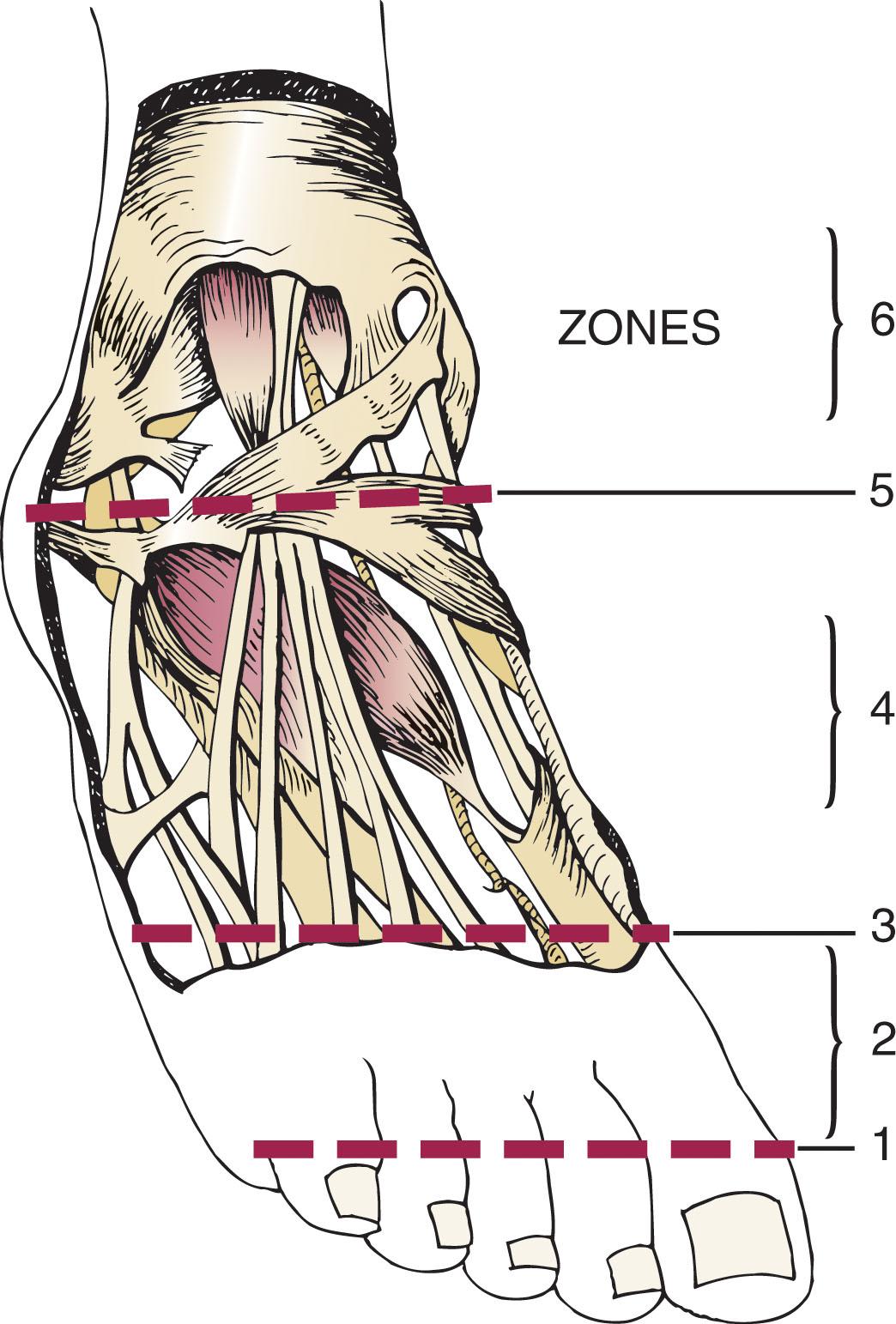
Isolated rupture of the EHL occurs infrequently. Successful surgical treatment centers on early diagnosis and prompt surgical intervention. Spontaneous ruptures of the EHL tendon occur infrequently, while lacerations are more common. Lacerations over the dorsum of the foot and the anterior ankle may be accompanied by injury to the anterior tibial or dorsalis pedis artery, deep and superficial peroneal nerves, and the anterior tibial tendon ( Fig. 28-22 ). At the time of an EHL injury, the foot often is in a dorsiflexed position, with the EHL under tension. Significant retraction can develop depending on the level of the laceration. Laceration of the digit distal to the extensor expansion may be evidenced by no significant tendon retraction because the extensor expansion prevents proximal migration.
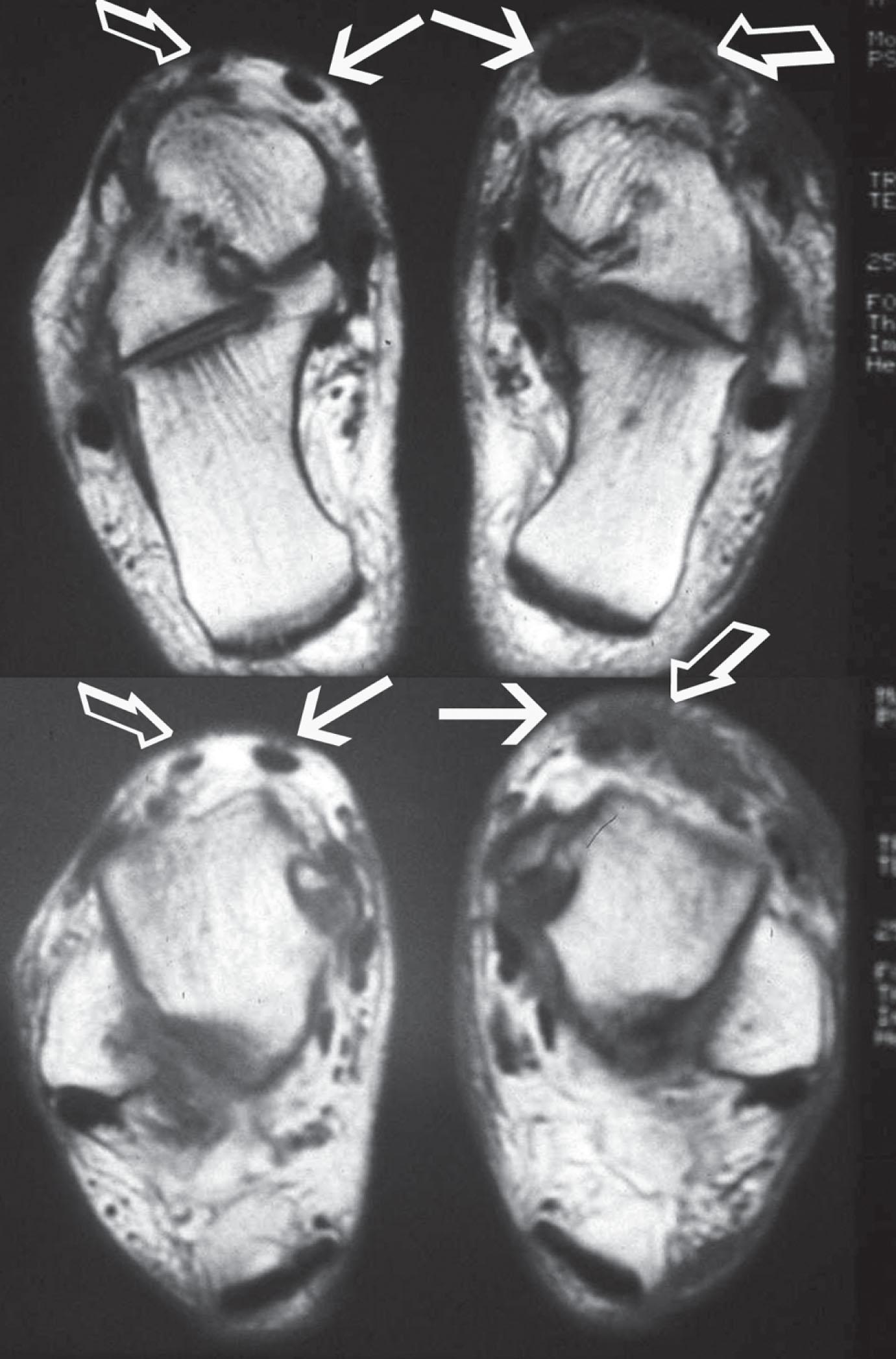
Iatrogenic surgical transection of the EHL can occur during any exposure adjacent to its course, but more commonly, it can be traumatized during osteotomies when not completely protected. During cheilectomy of the first metatarsal head through a dorsal approach, the saw blade can inadvertently lacerate the EHL. Similarly, during a metatarsal osteotomy from the medial approach, the EHL can be cut. A partial laceration can occur that may make the tendon vulnerable to late “spontaneous” rupture.
An EHL rupture at the interphalangeal (IP) joint can occur in association with a violent passive plantar flexion of the IP joint with a concurrent eccentric contraction of the EHL. Tearing of the skin over the hallux IP joint may occur in association with the EHL ruptures that occur after severe IP plantar-flexion injuries. One example is that of a ruptured EHL tendon at the IP joint of the hallux seen in a professional soccer player with a history of a trauma during a game consisting of a hyperdorsiflexion injury of the MTP joint in conjunction with severe plantar flexion of the IP joint. The patient reported significant pain, an inability to play, and difficulty walking for several months. On exam, he was noted to have a 1-cm healed scar from the superficial tearing of the skin and weakness of dorsiflexion of the IP joint. A bone contusion was seen on MRI of the proximal phalangeal base and dorsal metatarsal head and a medial plantar plate injury of the MTP joint. At the time of surgery, a defect was noted in the EHL tendon and dorsal capsule at the IP joint, with discontinuity of the tendon. The EHL was repaired, the MTP joint debrided, and the plantar plate repaired medially. The athlete returned to full function for several succeeding seasons.
When attritional ruptures occur, they tend to be at or around the level of the ankle joint. On occasion, calcification can occur with associated tendinopathy. The patient might experience a sudden pop with a subcutaneous rupture of the EHL. Development of ecchymosis in the area of the tendon and tenderness to palpation are coupled with an inability to dorsiflex the great toe ( Fig. 28-23 ). The tendon typically is not painful after rupture. An obvious defect may be present in the region of the anterior ankle with disruption of the EHL, and a gap may be noted. The tendon might not be palpable. EHB substitution can allow weak extension of the IP joint of the hallux. Menz and Nettle described a case with rupture at the musculotendinous junction (MTJ). Poggi and Hall reported on a closed rupture of the EHL at the level of the MTP joint that occurred several years after a cheilectomy. Sim and Deweerd reported on a spontaneous rupture of the EHL on the anterior aspect of the ankle in a skier. Spontaneous ruptures have also been reported after a hyper–plantar-flexion injury in a taekwondo athlete and from chronic impingement because of a dorsal talar osteophyte. One case of delayed rupture after injury from radiofrequency ablation during arthroscopic surgery has also been reported.
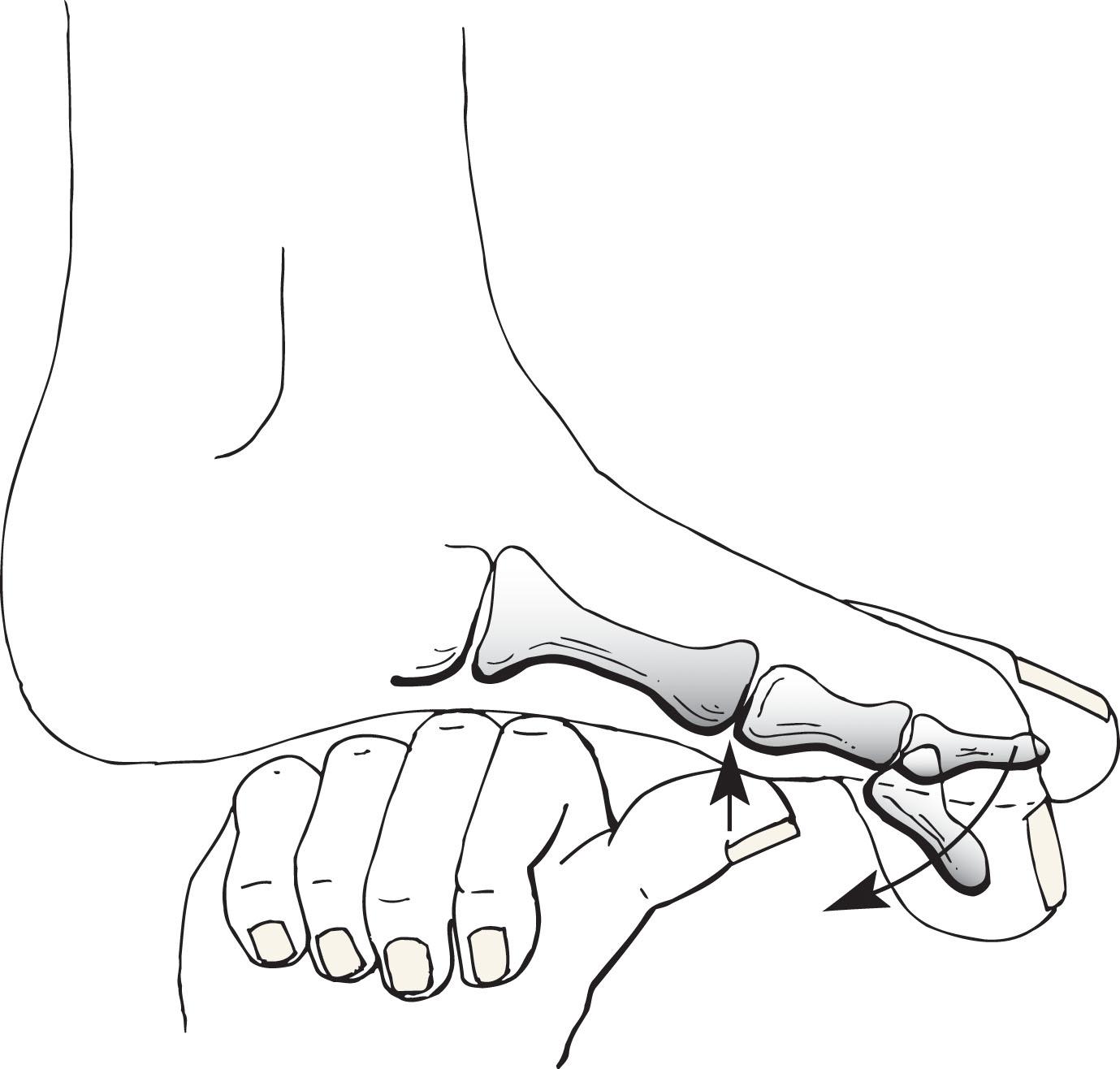
Functional limitations may occur due to weakness of hallux extension after EHL rupture or laceration. Patients having difficulty pulling on socks and shoes because of the weakened extension of the hallux readily experience the toe getting caught in the toe box or sock. Walking barefoot can be problematic because the patient can stub the hallux on the floor. In this situation, the toe tip has friction against the ground that, because of the forward motion and the lack of a full lift-off, results in a disruption of normal gait, making the patient vulnerable to tripping and/or falling. Depending on the location of the tendon disruption, some function might remain.
Al-Qattan classified the zones of injury of the extensor hallucis tendon lacerations into six areas ( Box 28-1 ).
Zone 1: At the insertion site on the distal phalanx
Zone 2: The area between zones 1 and 3
Zone 3: Over the first metatarsophalangeal joint
Zone 4: On the dorsum of the foot between zones 3 and 5
Zone 5: Laceration of the tendon beneath the extensor retinaculum
Zone 6: In the lower leg proximal to the extensor retinaculum (see Fig. 28-21 ).
![]() Extension of any laceration should be performed in a longitudinal direction to assess an injury to the EHL. Transverse lacerations may be extended in a Z-fashion. Evaluation of the anterior tibial tendon, deep peroneal nerve, and other elements of the neurovascular bundle is important. The tendon is approximated and repaired with a 2-0 nonabsorbable suture with a modified Kessler or Krackow technique ( Fig. 28-24 ; see Fig. 28-13 ).
Extension of any laceration should be performed in a longitudinal direction to assess an injury to the EHL. Transverse lacerations may be extended in a Z-fashion. Evaluation of the anterior tibial tendon, deep peroneal nerve, and other elements of the neurovascular bundle is important. The tendon is approximated and repaired with a 2-0 nonabsorbable suture with a modified Kessler or Krackow technique ( Fig. 28-24 ; see Fig. 28-13 ).

If the tendon is retracted, a more proximal incision or an extension of the exposure may be necessary in the area of the anterior ankle ( Fig. 28-25 ), and a tendon graft may be necessary to bridge a substantial defect in the case of a delayed repair ( Fig. 28-26 ). The tendon may become caught beneath the more proximal extensor retinaculum. It is also very helpful to dorsiflex the ankle and the toes to passively deliver the tendon ends into the wound. Once the ends are found, the surgeon can insert a long 25-gauge needle perpendicularly to skewer the tendon, and this keeps it from retracting. This is a relatively atraumatic way to hold the tendon during repair. When a graft is used, it is best to avoid a tenodesis directly under the extensor retinaculum due to its bulk, which limits excursion; in these cases, tenodese the graft proximal and distal to the extensor retinaculum and run the graft under the retinaculum.
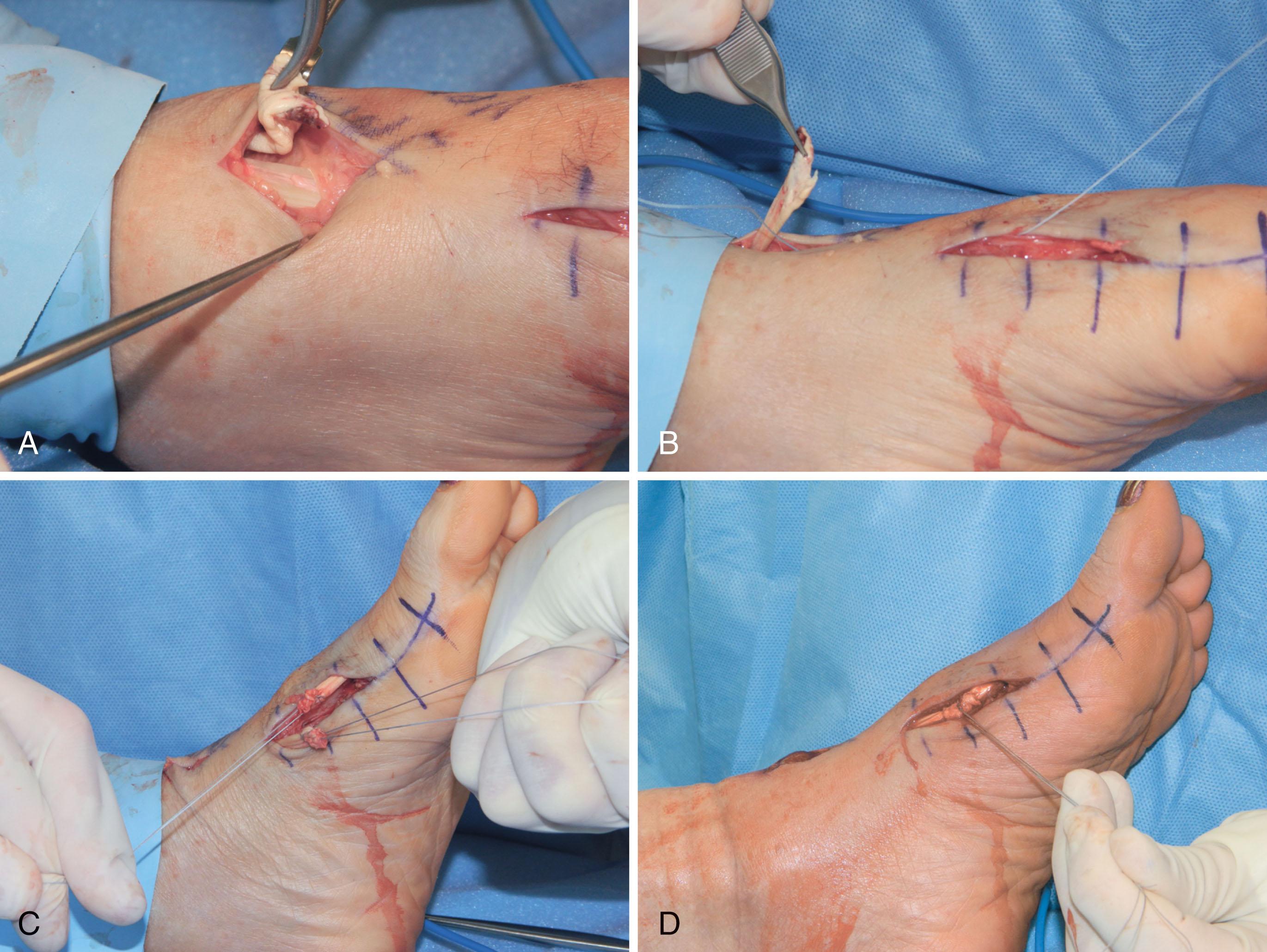
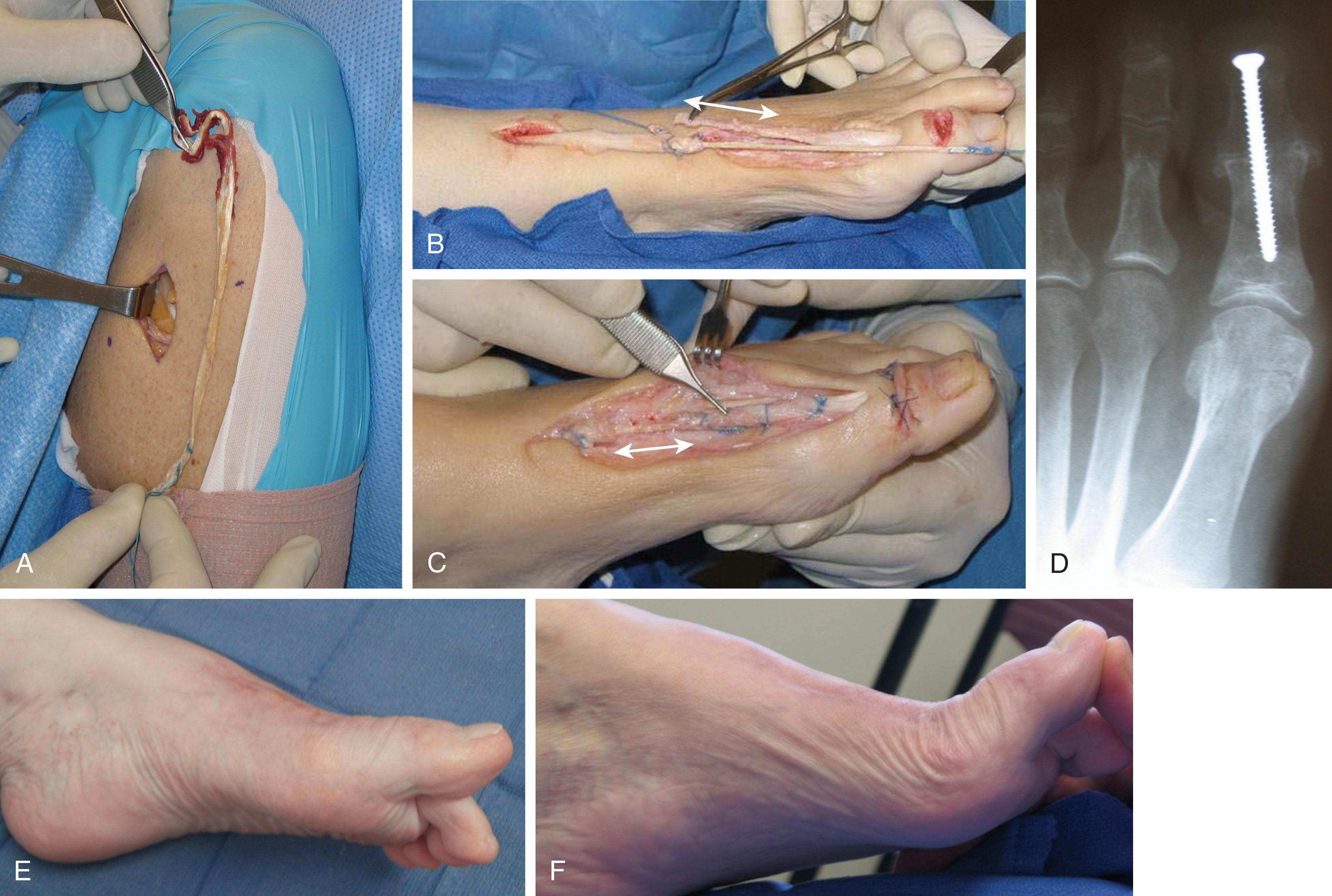
Tensioning the graft, when used, is important to obtaining functional results. Passively, the first MTP should dorsiflex when the ankle is plantarflexed and should regain neutral position with the ankle dorsiflexed. Awake surgery may be considered so the surgeon can visualize active motion and tendon glide.
After a primary repair, a posterior splint, brace, or cast is used for 4 weeks. Once the wound is stable, early passive and active assistive dorsiflexion of the MTP joint exercises can be initiated. Poggi and Hall recommend a below-knee cast with the ankle positioned at a 90-degree angle and further plantar flexion blocked. A removable boot brace is best used in compliant patients because it permits controlled passive and active assistive dorsiflexion but not active dorsiflexion of the toe and ankle, to minimize adhesions. One should avoid passive or active plantar flexion or active dorsiflexion until 4 to 8 weeks after the repair.
Reports of EHL repair are rare. Case reports of EHL rupture and repair have been published. Scaduto and Cracchiolo reviewed the world literature and noted only 43 reported cases of EHL tendon lacerations. Undoubtedly, there are many more cases, but experience may be diluted by the small number of cases repaired at any one institution.
EHL injuries proximal to the extensor hood have been reported by a number of authors. Wong et al reported 23 EHL tears that underwent repair or reconstruction based on level of retraction. At 1 year, 19 or 20 (95%) had active dorsiflexion of the hallux, and patient-reported outcome scores were excellent (FAAM sport 94%, FAAM ADL 94%). Floyd et al reported on 13 EHL lacerations, of which 11 underwent a primary repair using a modified Kessler suture technique or a modified Bunnell technique resulting in seven good and six fair results. Wicks et al reported on 11 lacerations of the EHL, with seven of nine showing good results. Simonet and Sim reported on five lacerations of the anterior ankle treated with a primary repair with satisfactory results.
Distal injuries may be treated successfully with or without surgery depending on the location of the tear. Al-Qattan reported a large series of 15 patients treated with surgical repair of the EHL over a 12-year period including distal injuries as well as lacerations in zone 4 (over the dorsum of the foot). The author advocated temporary Kirschner wire fixation of both the IP and metatarsophalangeal (MTP) joints for 6 weeks during the acute healing phase after the primary tendon repair, finding a high level of satisfactory results. Duke and Greenberg recommend nonsurgical treatment after a distal injury. Noonan et al reported on three patients who sustained lacerations of the base of the nail with Salter fractures and concluded that these could be treated conservatively.
While some authors advocate for nonoperative care of EHL laceration based on the perceived good clinical outcomes after EHL tenotomy, EHL weakness can lead to functional deficits, suggesting repair is indicated when possible. Jaffe reported a case of EHL laceration left untreated by patient preference who regained extension strength of the hallux by 1 year and had no gait abnormality. Duke and Greenberg reported on 75 distal tenotomies of the EHL and found no evidence of weakness of the great toe in 16 patients seen in follow-up. Griffiths, reporting on one patient who did not have a surgical repair, concluded that “formal repair of the EHL seems unnecessary. Its natural tendency for spontaneous repair after tenotomy is well known.” Although this suggests that the EHL does not need to be repaired, Floyd et al noted that the sole justification for not repairing this tendon appears to be Griffiths's one patient, who recovered spontaneously, and whose level of injury is unknown. Kass et al and Floyd et al argue that tenotomies are quite different from lacerations of the EHL. Kass et al observed that after an isolated tenotomy with the foot in a plantar-flexed position, minimal retraction occurs. On the other hand, with the EHL under tension, significant retraction can occur, and a significant gap can develop that precludes later tendon healing. Floyd et al noted significant proximal retraction of the EHL in two rupture cases. The primary problems observed after unrepaired EHL tears are clumsiness donning shoes or boots, catching the toe when walking barefoot, and plantar-flexion deformity of the hallux. In general, based on the author’s clinical observations, efforts to repair the tendon should be undertaken when possible.
McMaster stated that spontaneous rupture of a tendon rarely occurs without predisposing factors such as chronic disease. If the tendon ends appear healthy, end to end repair may be possible. Alternatively free tendon grafting or tendon transfer may be necessary. Endoscopic repair has also been advocated to minimize scarring. All had excellent results.
With delayed treatment of an old EHL rupture, tendon transfer or tendon grafting may be necessary, as the tendon ends may not be adequate for repair or grafting. Berens noted that on initial exploration the proximal portion of the tendon could not be identified. Therefore the extensor hallucis brevis tendon was transferred into the distal stump of the EHL. Menz and Nettle noted that a primary repair was not possible and used the tendon of the peroneus brevis that was mobilized and sutured it directly to the EHL. Hoelzer and Kalish also reported an EHL tendon disruption and noted at exploration 4 months after injury that the proximal end had retracted. The tendon of the EDL to the second toe was split and anastomosed to the distal stump of the EHL. Allografts and autografts have also been reported as a means to bridge significant defects with delayed treatment of EHL injuries with satisfactory results.
Postoperative scarring and adhesion formation can lead to diminished postoperative motion and may be a source of pain, but this is uncommon. Floyd et al reported that 38% of those injured had a painful scar.
With only one reported exception, the results of surgical repair of acute disruption of the EHL tendons have been good.
The site of injury is an important factor in developing a plan for treatment of a disruption of the EHL. If the injury is distal to the extensor expansion, nonsurgical treatment is considered, as long as the hallux can be maintained in a neutral position with tendon apposition. An injury proximal to the extensor expansion may be treated with a primary repair.
The timing of the injury also affects the techniques available for repair. Treatment of EHL injuries 6 weeks or later after injury is often associated with an inability to reapproximate the tendon ends. A tendon transfer or tendon graft may be necessary to bridge the interval gap ( Fig. 28-27 and ![]() ). In these cases, one should assess the amount of tendon loss by placing moderate tension on the tendon ends and placing the ankle and hallux in neutral position. When the tendon ends cannot be opposed without excessive tension, a tendon slide, using healthy proximal EHL tendon for defects up to 4 to 5 cm, may be attempted. For anything greater than a 5-cm gap, a tendon transfer may be performed. Although in the past a common reported transfer was the peroneus tertius, a split of the extensor to the second toe for use in lacerations distal to the ankle joint is a good alternative ( Fig. 28-28 ). Allograft and autograph tendon transfers have become more popular to bridge obvious tendon gaps.
). In these cases, one should assess the amount of tendon loss by placing moderate tension on the tendon ends and placing the ankle and hallux in neutral position. When the tendon ends cannot be opposed without excessive tension, a tendon slide, using healthy proximal EHL tendon for defects up to 4 to 5 cm, may be attempted. For anything greater than a 5-cm gap, a tendon transfer may be performed. Although in the past a common reported transfer was the peroneus tertius, a split of the extensor to the second toe for use in lacerations distal to the ankle joint is a good alternative ( Fig. 28-28 ). Allograft and autograph tendon transfers have become more popular to bridge obvious tendon gaps.

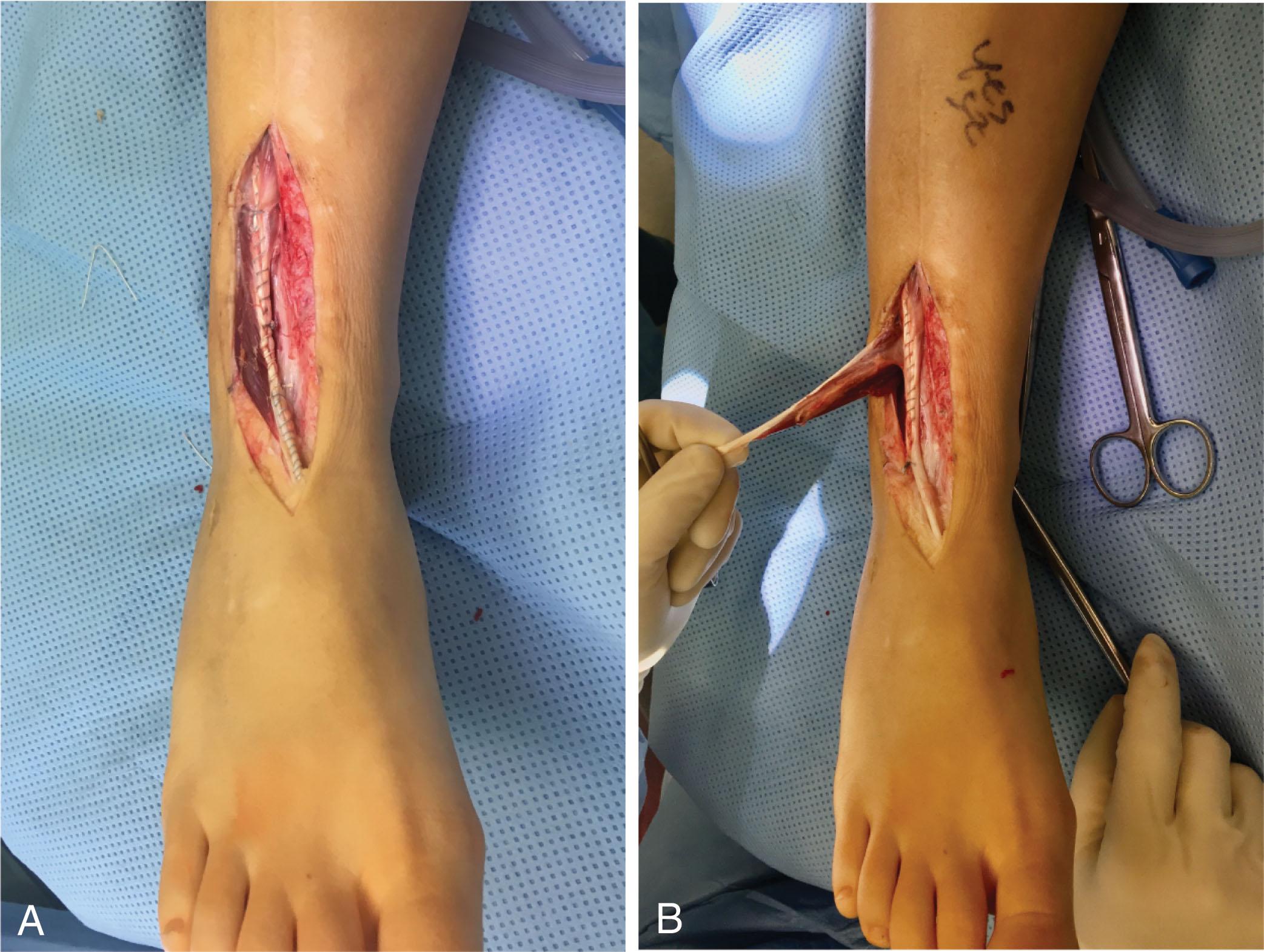
Aggressive surgical treatment of open lacerations about the foot is most important. Adequate exploration and debridement and anatomic restoration of tendons are usually appropriate, though contaminated or infected wounds may force a delay in repair. In these cases, retraction or significant soft tissue loss may necessitate a sliding transfer using half of the intact proximal EHL, or secondary tendon grafting, if there is a distal stump, pliable tissues without extensive fibrosis along the tendon path, and no evidence of infection. In the case of primary repair or grafting, care should be taken to obtain normal resting tension. The authors have a low threshold for grafting as excessive tightness of the repair can lead to dorsiflexion posture of the toe that is poorly tolerated.
The EDL is relatively superficial and easily lacerated with trauma, most frequently from the falling of a sharp object against the leg, ankle, or foot ( Fig. 28-29 ), though attritional rupture is possible from internal frication against bone spurs. Above the ankle, the EDL tendons are in a more centralized location, but their slips are separate, making multiple EDL lacerations possible ( Fig. 28-30 ). Bell and Schon have noted that the EDL proper can only be lacerated between the ankle and the midfoot because individual tendons are found below this level. One may be deceived when looking at these injuries because the superficial laceration may reveal intact tendon below, only to have the deeper tendon laceration occur more distally below intact skin. For this reason, they are frequently misdiagnosed in the urgent car or emergency department.
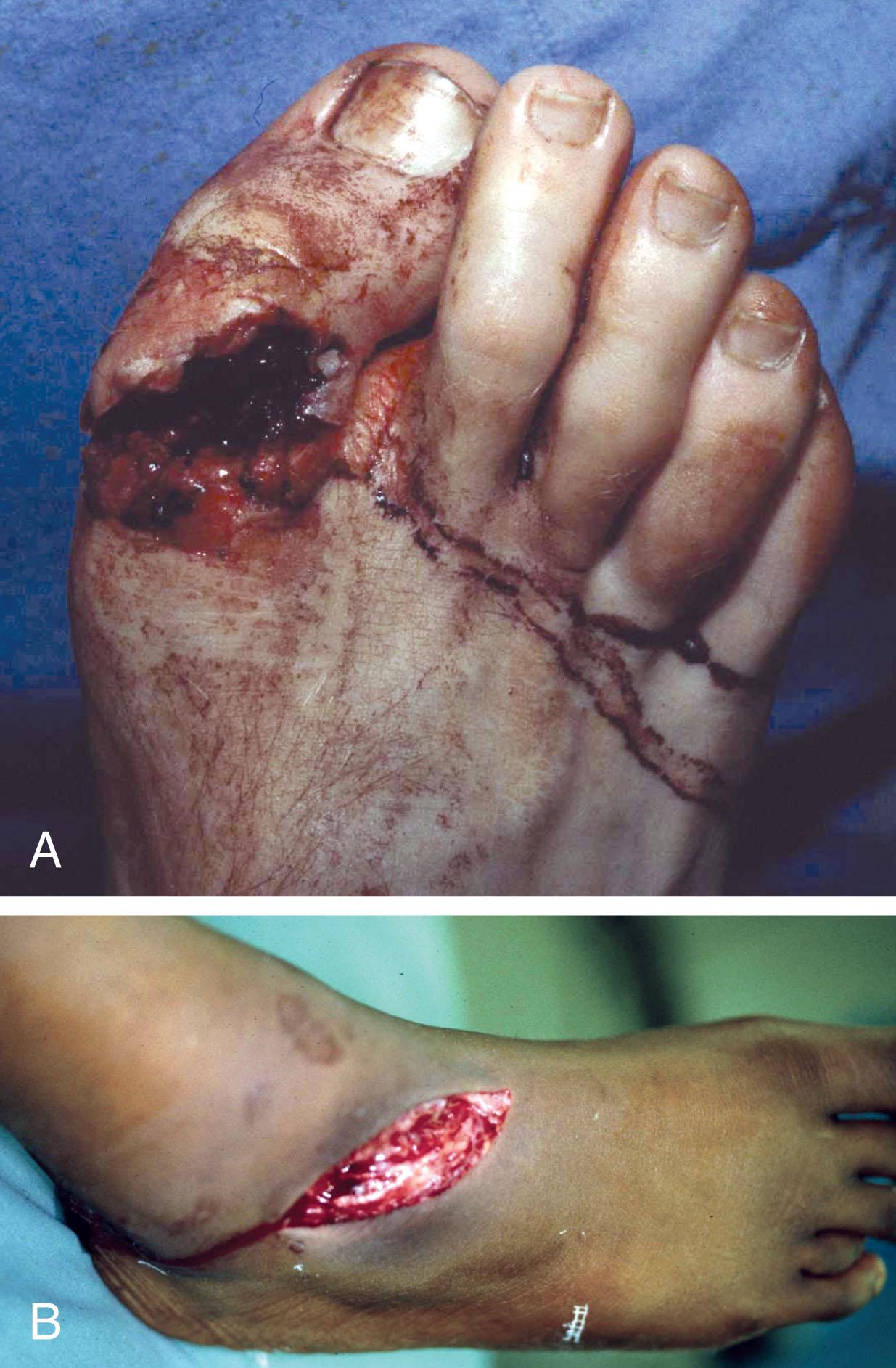
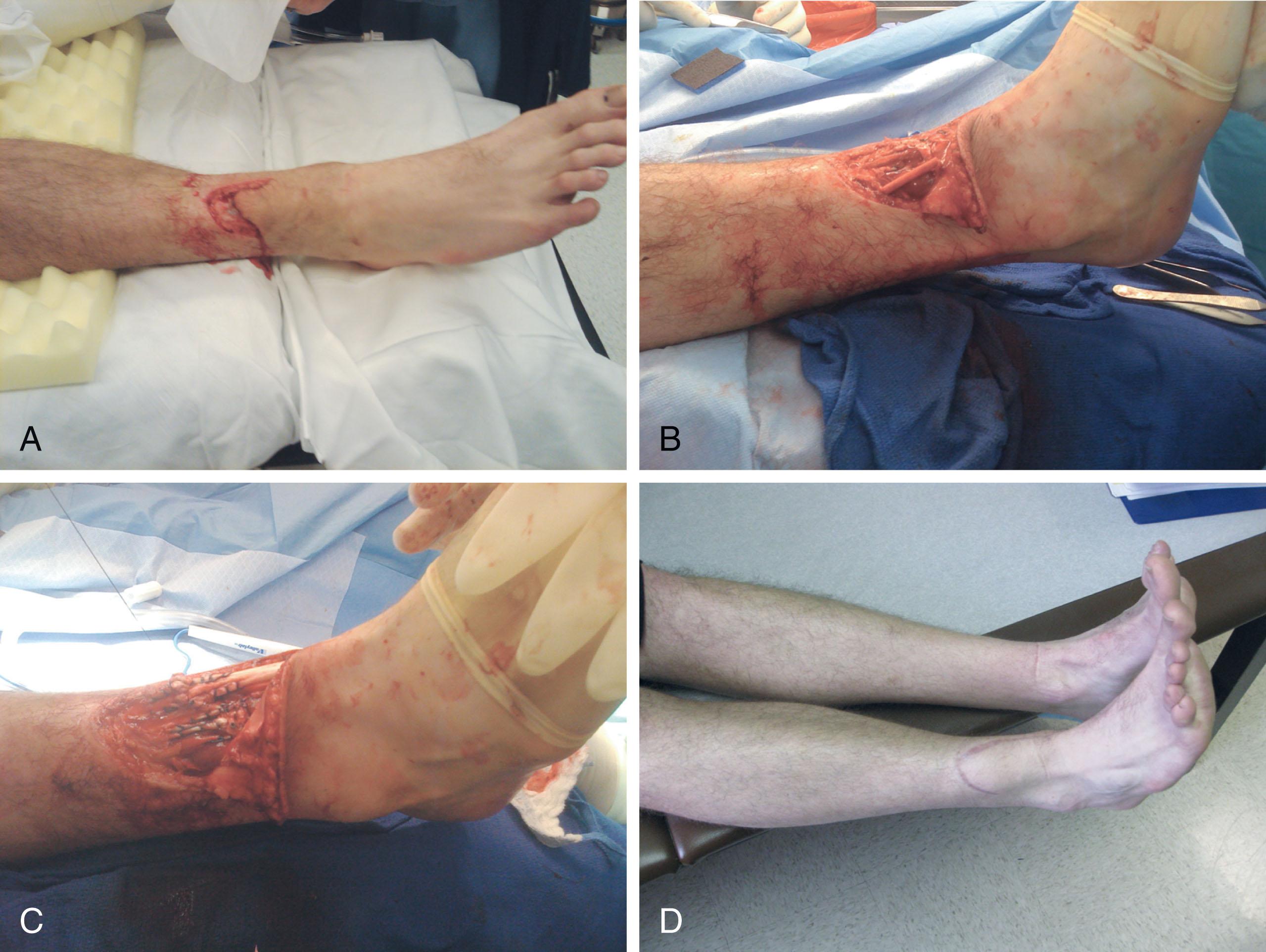
Because the main function of the EDL is extension of the MTP joint and the proximal and distal interphalangeal (PIP and DIP) joints of the lesser toes, when it is transected and not repaired, a claw toe deformity can develop. Patients with chronic extensor tendon lacerations report difficulty controlling the toes when attempting to put on socks or slide into shoes. During these activities, the toe tends to catch on the fabric or insole and passively flex underneath the foot. Often, because of the proximity of the anterior tibial tendon to the EHL and the neurovascular bundle, injury to these structures can occur simultaneously.
The EDL originates on the lateral tibial condyle, the anterior crest of the fibula, and the interosseous membrane in the anterior compartment of the leg, and it inserts on the base of the terminal phalanges of the four lesser toes. Innervated by the deep peroneal nerve, the EDL functions to extend the toes at the DIP joint and to dorsiflex and evert the foot.
The EDL divides into two separate tendons beneath the superior retinaculum and then further divides into two lateral tendons to the fourth and fifth toes and two medial tendons to the second and third toes ( Fig. 28-31 ). The individual tendon of the EDL to each toe is joined on the lateral aspect by the tendon of the extensor digitorum brevis (EDB). These individual tendons are anchored at the level of the MTP joint by a fibroaponeurotic dorsal digital expansion.
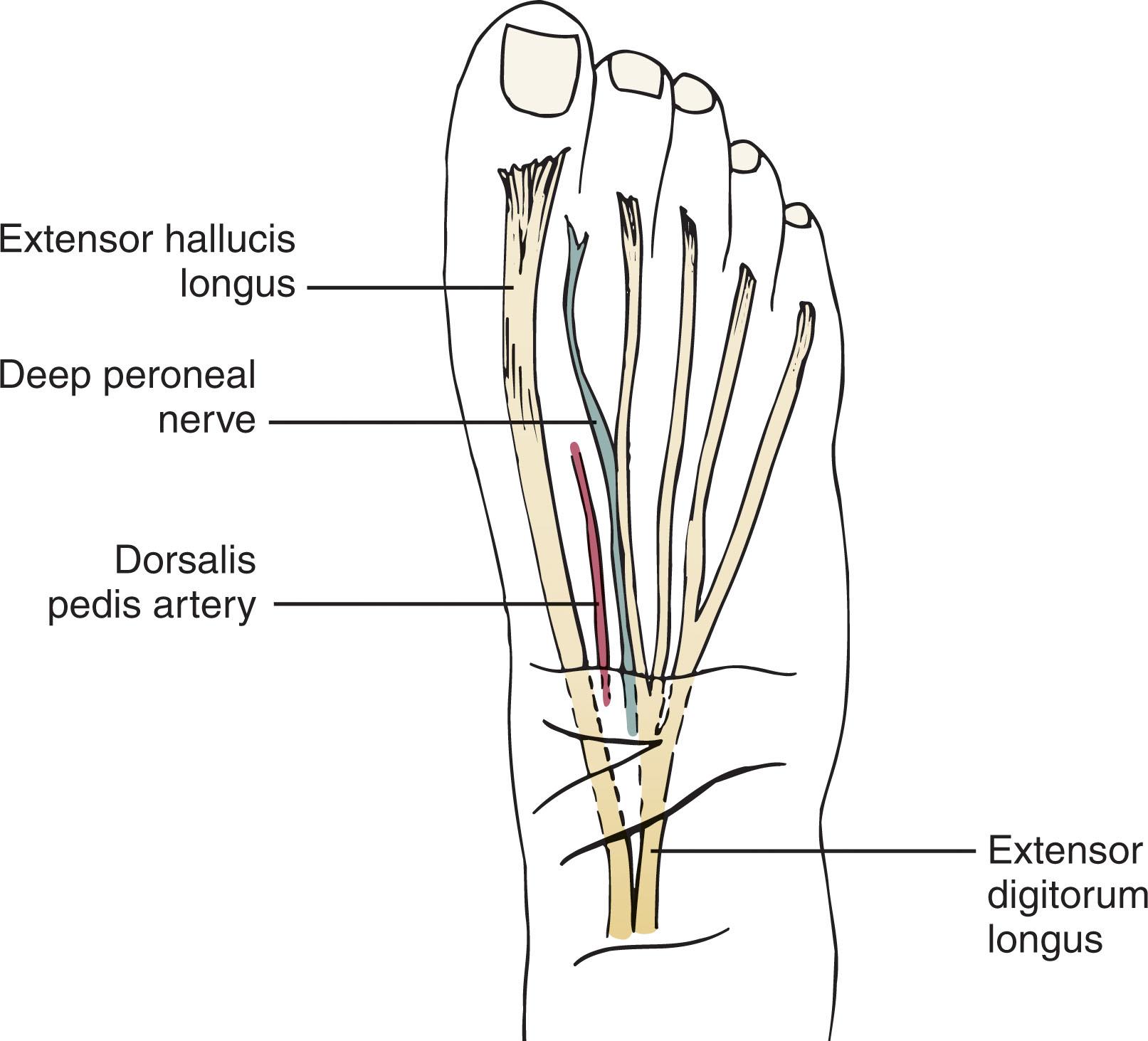
On physical examination, an absence of extension of the lesser toes at the MTP joint is demonstrated after disruption of the EDL. Weakness of extension of the toes can also be appreciated at the PIP and DIP joints. Furthermore, because the EDL affects eversion and dorsiflexion of the foot, significant weakness of this function can be noted after tendon disruption. On palpation, a gap may be noted at the area of tendon injury. An interruption of the EDL may be diagnosed by an inability to palpate this tendon in the forefoot or ankle region as well as by weakness of lesser toe extension. The status of the superficial peroneal and deep peroneal nerves should be evaluated as well as the function of the EDB.
On physical examination, difficulty can surround the diagnosis because of the ability of one tendon to substitute function for another. For example, the EDB can substitute for the EDL. On the plantar aspect of the foot, the flexor digitorum longus (FDL) can substitute for the flexor hallucis longus (FHL) because of a crossover connection between the two flexor tendons. Comparison with unaffected contralateral toes can be useful. It is also useful to passively hold the ankle in both maximum dorsiflexion and plantar flexion and observe the positioning of the toes. In plantar flexion, the resting tension on the toes should permit them to lie in a neutral position or dorsiflexion when the tendons are intact. There should be a springiness to the toes with intact tendons that is appreciated when pushing them into plantar flexion while holding the ankle in plantar flexion. In dorsiflexion of the ankle, the toes should drop into a plantar-flexed position versus the ankle plantar-flexion position, when they should dorsiflex. Careful assessment is important to delineate a specific tendon injury.
Imaging including MRI scans may be useful but can miss the disruption, so exploration is indicated in the setting of penetrating trauma and weakness on exam.
At surgical exploration after a laceration, careful and comprehensive management is important with an open wound. Parenteral antibiotics, tetanus prophylaxis, and immobilization should be used depending on the specific tissue injury. All wounds should be thoroughly explored, debrided, and copiously irrigated. Any foreign bodies or materials should be removed. Inspection of adjacent neurovascular structures is important, and they should be repaired or ligated as appropriate. A second-look operation 24 to 72 hours later should be considered for wounds with greater contamination.
When an EDL rupture is found during wound exploration, Bell and Schon recommend primarily repairing using a modified Kessler suture technique. Alternatives include a modified Bunnell or Krackow technique (see Fig. 28-13 ). Postoperatively, the foot is protected for 3 to 4 weeks with the foot and ankle in neutral position. The patient should be instructed in passive dorsiflexion of the ankle and toes, to maintain tendon gliding without straining the repair. After the wound is healed, active assistive dorsiflexion can be instituted. Resistive exercises should be avoided for 6 to 8 weeks depending upon the repair. The patient should sleep in a protective night splint to maintain neutral position. Full weight bearing in a CAM boot can be started after the incision has healed because the boot, when standing and walking, helps maintain the tendons in a position with minimal tension.
Results after EDL repair are reported in small case series and generally demonstrate improved function. Rooks reviewed reports of EDL injuries and noted 26 cases of EDL disruption, finding a preponderance of satisfactory results occurred after surgical repair. Lipscomb and Kelly reported on six lacerations of the EDL in combination with other tendon injuries and reported 50% good results. Floyd et al reported on eight EDL disruptions, seven of which were primarily repaired. The one tendon that was not repaired had a poor result. Other reports note generally good results with surgical intervention. Wicks et al reported on four lacerations of the EDL and concluded that those not repaired did not have a significant problem. Floyd et al reported a high incidence of painful dorsal scars after laceration of the dorsum of the foot. Rooks advised surgical repair of a disrupted EDL if it could be accomplished with minimal extension of the wound. He advised careful attention to associated nerve injuries as well.
Akhtar and Levine reported a case of spontaneous dislocation of the EDL after a rupture of the inferior extensor retinaculum. They repaired the retinaculum and relocated the tendon successfully.
In general, injuries to the EDL tendon occur with lacerations to the dorsum of the foot or anterior ankle. During surgical exploration, appropriate treatment of nerve and vessel injuries should be carried out, and repair of the disrupted EDL tendons should be done when feasible.
The EDB tendon originates on the distal lateral and superior surface of the calcaneus and inserts on the lateral aspect of the EDL tendon and on the base of the proximal phalanx of the second through fourth toes. It is innervated by the deep peroneal nerve and provides extension at the MTP joint. The muscle is the only intrinsic muscle on the dorsum of the foot. There is no EDB tendon to the fifth toe.
The EDB is located on the lateral aspect of the forefoot and covers the lateral aspect of the subtalar joint. The tendons are quite small and are often injured after a laceration on the dorsolateral aspect of the foot. Bell and Schon suggest that if the tendons are easily identified at the time of an EDL repair, an EDB repair should be performed as well. If the EDB is not repairable, EDL repair alone is adequate. The EDB is frequently elevated during surgical approach to the sinus tarsi and calcaneocuboid joint with no long-term consequences to toe function. No series have been reported on repairs of the EDB.
Kriza and Mushlin reported an avulsion fracture of the EDB from its origin on the calcaneus. It was treated nonsurgically with a successful result. An avulsion fracture of the EDB should be distinguished from an os peroneum, a fracture of the anterior process of the calcaneus, the peroneal trochlea, a fracture of the cuboid, or a rupture of the calcaneofibular ligament.
The FDL is the primary plantar flexor of the lateral four toes. Innervated by the tibial nerve, the FDL originates on the posterior tibia below the soleal line in the deep posterior compartment and functions to plantar flex the toes and to plantar flex and invert the foot. Lying just posterior to the posterior tibial tendon at the ankle, it courses on the plantar aspect of the tarsus in the deep midfoot before inserting on the distal phalanx of the lateral four toes. It is at risk for laceration in the toes as well as more proximally in the ball of the foot or arch with penetrating injuries.
Although no cases of spontaneous FDL tendon rupture have been reported, flexor tendon ruptures after cortisone injections for interdigital neuromas have been appreciated ( Fig. 28-32 ). FDL tenosynovitis can occur in patients with a posterior tibial tendon disruption caused by the patient overcompensating for the inversion weakness by flexing their toes. Infectious FDL tenosynovitis can occur when a toe or metatarsal ulcer tracks into the FDL sheath. In these cases, a mid-arch or ankle abscess can develop. There are also reports of tuberculous tenosynovitis requiring multiple surgical procedures. A report of proximal rupture of the FDL was associated with a medial malleolus fracture.
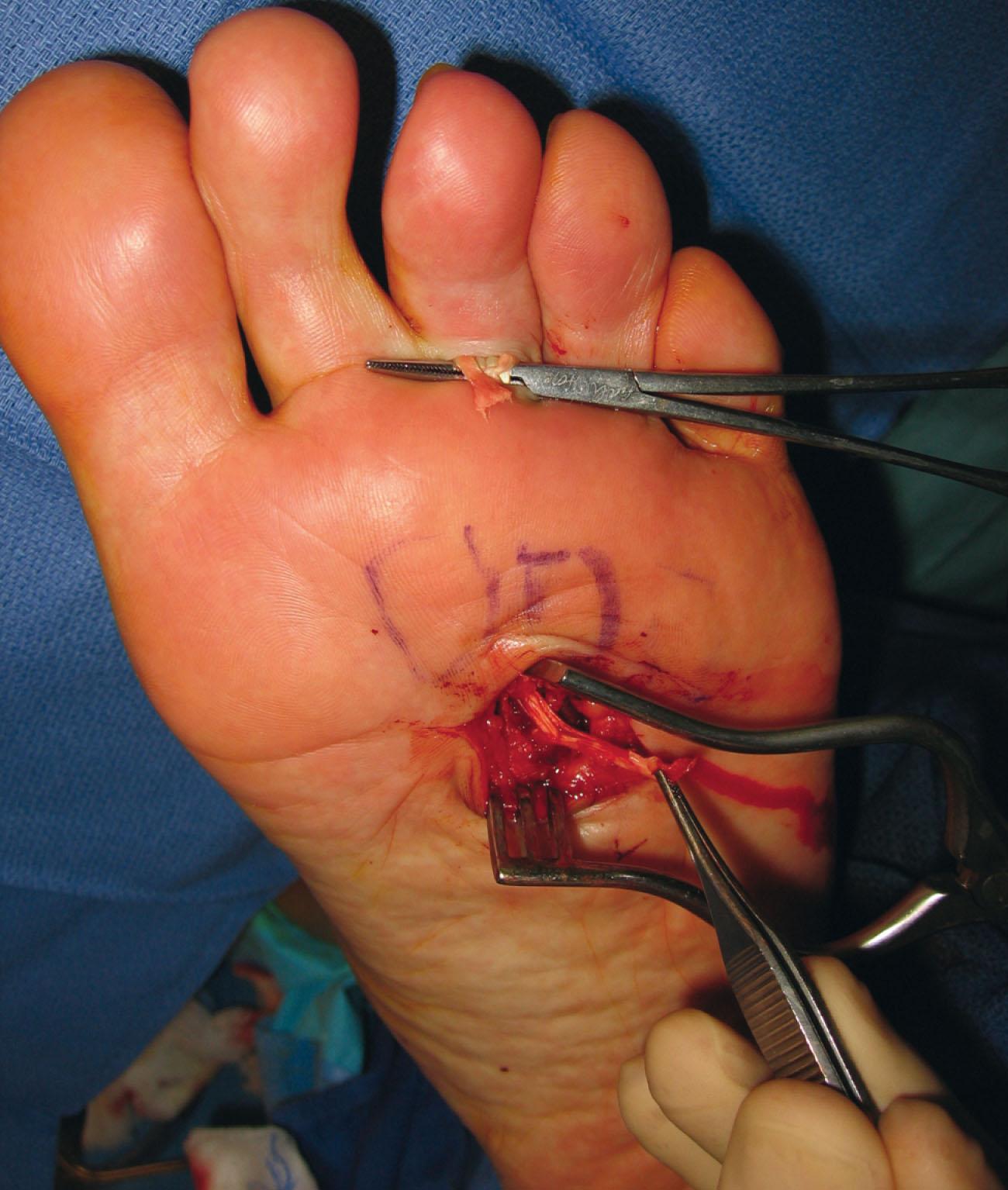
Besides injection-induced ruptures and overuse, an FDL tendon rupture is almost always associated with a penetrating laceration. A patient often describes a history of stepping on a piece of glass or sharp object, with resultant loss of plantar flexion power to one or more of the lesser toes. Concomitant sensory loss may be noted as well. The penetrating injury may result in wound issues and infection. It is important to note that an FDL tendon deficit is often seen because the FDL tendon is frequently harvested for posterior tibial tendon reconstructions and occasionally for Achilles or peroneal tendon reconstructions. Patients who have had this surgery will report minor dysfunction, such as weakness of lesser toe curling, particularly in the third, fourth, and fifth toes. Occasionally, they will note a lack of stability when rising on their toes or balancing on the forefoot. Patients might complain that the toe gets caught on the inside of a shoe or sock as they dress.
Because specific function of the FDL is at the DIP joint, lack of flexion power indicates a rupture ( Figs. 28-33 and 28-34 ). On physical examination, a laceration distal to the knot of Henry is often associated with weakness or absence of plantar flexion of the lesser toes. Diagnosis of FDL tendon disruption can be demonstrated by stabilizing the MTP joint and asking the patient to plantar flex the tip of the toe. Weakness or absence of plantar flexion strength to one or more of the lesser toes can demonstrate an isolated disruption of the FDL to an individual toe or a complete disruption of the FDL.
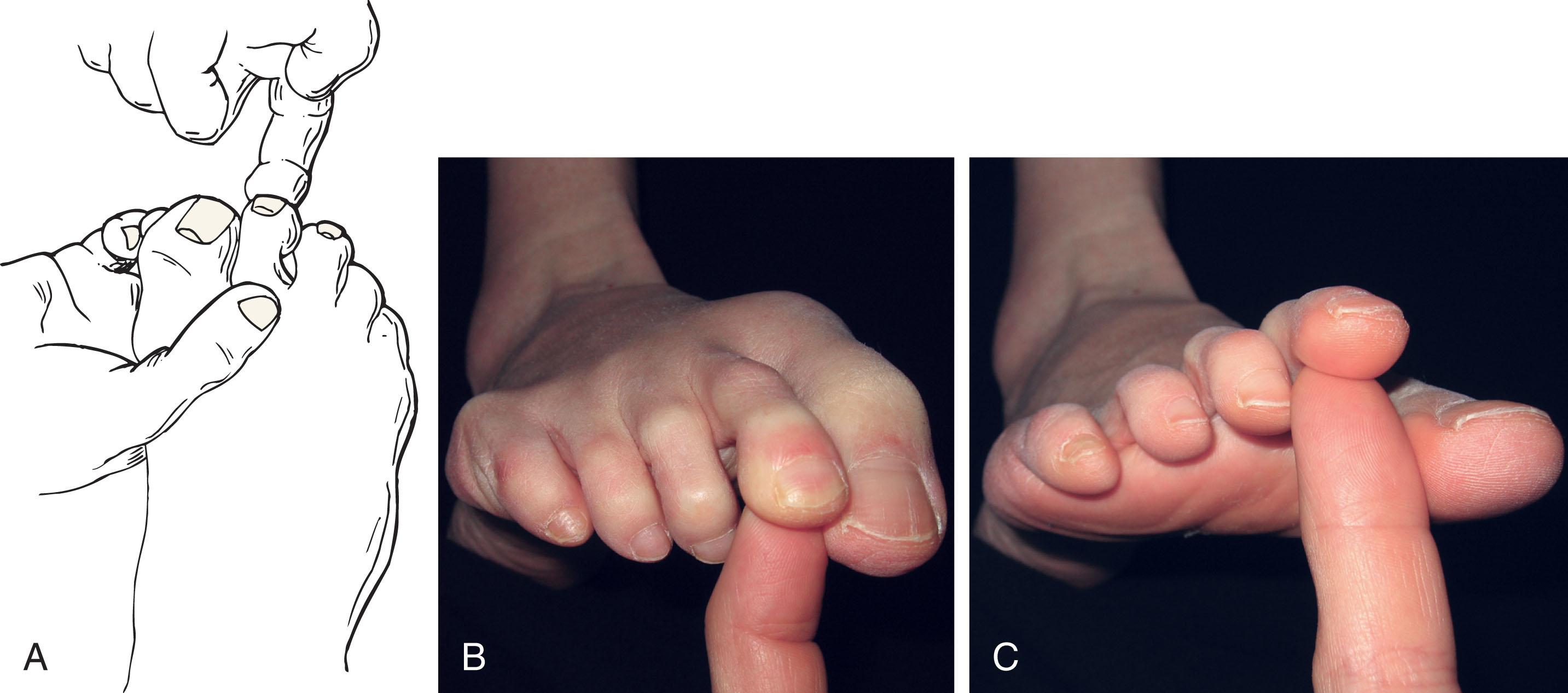
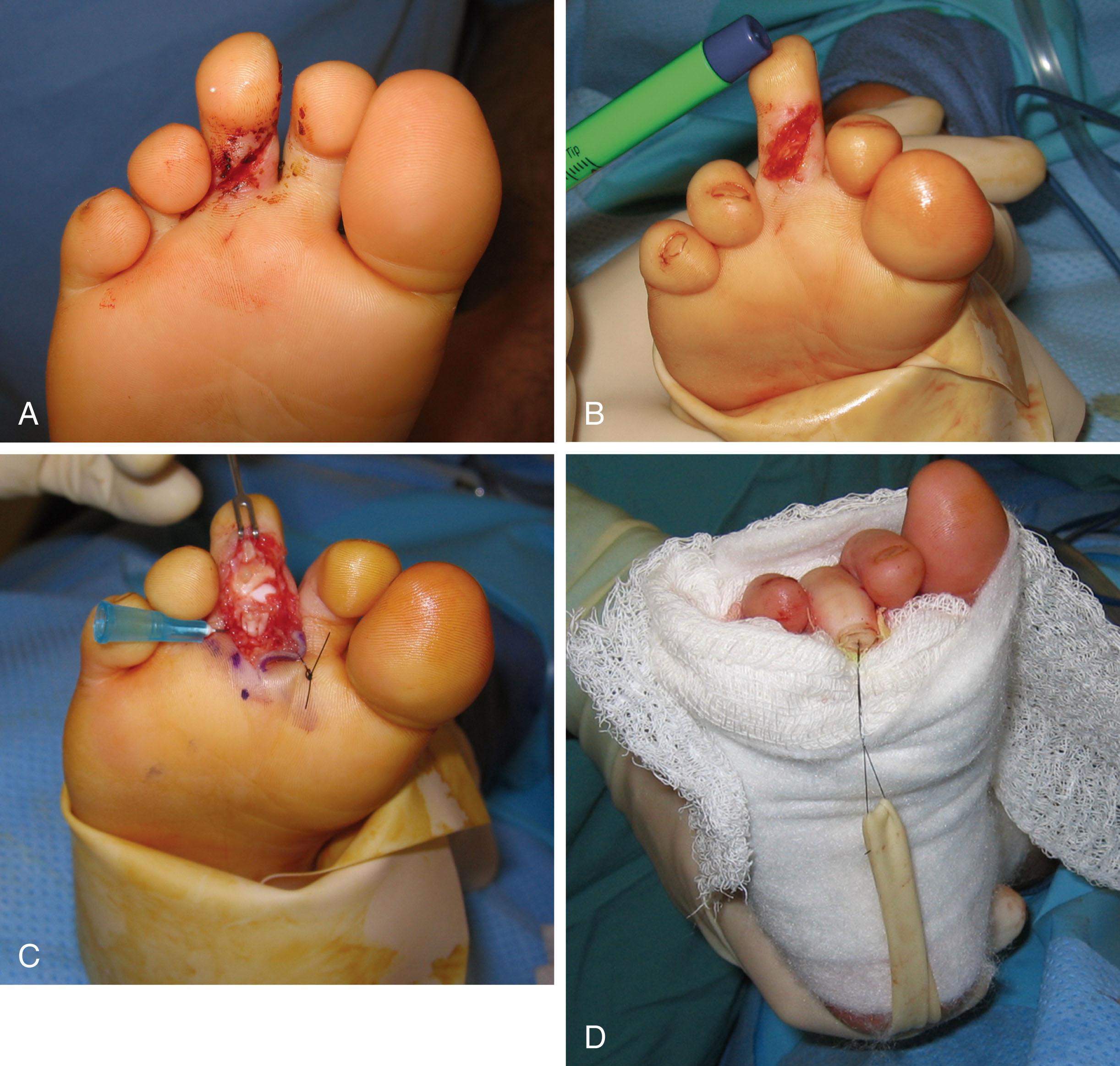
Proximal to the master knot of Henry, because of a connecting slip from the flexor hallucis longus (FHL), flexion of the DIP joint can remain despite a proximal disruption of the FDL tendon. It is typical that the second toe will maintain flexion based on the FHL tendon attachment, but the third toe can also be connected by a slip. At the ankle level, an FDL injury is often associated with tibial nerve symptoms. In the midtarsus, an FDL tendon laceration is often associated with medial plantar nerve symptoms. Often, at the distal metatarsal level or toe level, injury to an adjacent digital sensory nerve is associated with injuries of the FHL or FDL tendons. Chronic FDL tendon rupture can lead to a hammer toe or swan neck deformity.
While exploring a laceration, the surgeon should keep in mind the principles of trauma care, including adequate irrigation and debridement of the wound. The wound should be explored in a way that does not complicate or exacerbate the injury. Extension of the laceration longitudinally allows an extensile exposure. When possible, a primary repair of the injured tendons is appropriate by using a Bunnell repair, modified Kessler technique, or Krackow tendon repair (see Fig. 28-13 ).
Postoperative care necessitates immobilization in a below-knee cast for 4 to 6 weeks if the disruption is at or proximal to the master knot. Extension of the cast over the dorsal aspect of the toes prevents excessive dorsiflexion and protects the repair. If the laceration is distal to the master knot, the toe can be held flexed after repair by gluing a metal hook to the toenail and attaching it to a rubber band that is connected proximally and plantarly to a splint or dressing ( Fig. 28-35 ).
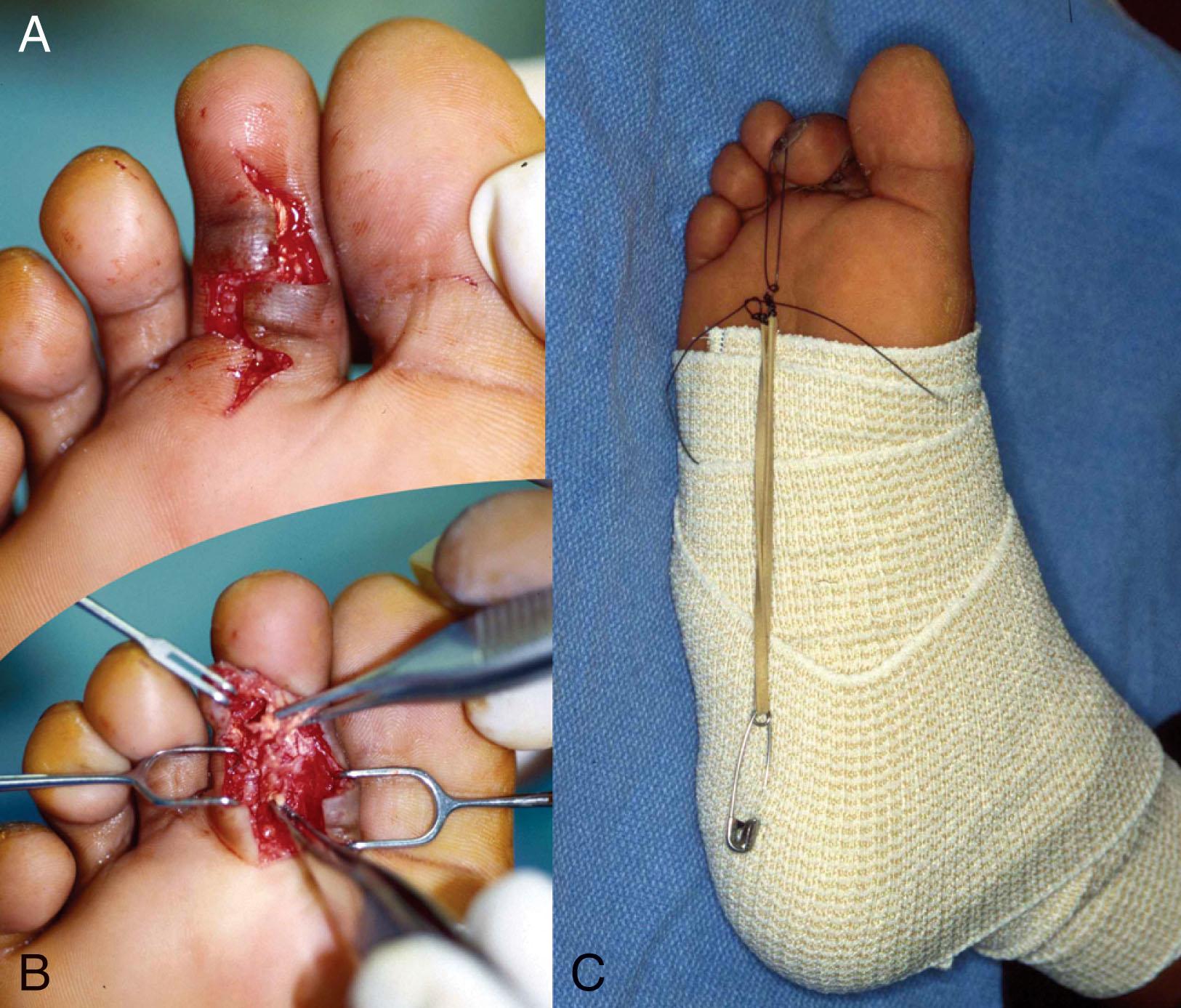
The actual site of injury is an important factor in developing a treatment plan for FDL tendon disruption. An injury distal to the knot of Henry leaves the patient without plantar flexion power, whereas an injury proximal to the knot of Henry might leave plantar-flexion power because of the crossover attachment of the FHL tendon. Remaining function can obviate the need for a surgical repair. Treatment of an FDL tendon injury 4 to 6 weeks or longer after injury is likely to be associated with difficulty in reapproximating the tendon.
In a review of preferences of many orthopaedic surgeons, Yancey found that 80% to 93% thought repair of the FHL was important, but only 53% to 73% thought surgical repair of a lacerated FDL tendon was indicated. Floyd et al reported on lacerated FDL tendon in seven patients: Five underwent a primary repair, one underwent a secondary repair, and one was left unrepaired. The six patients undergoing surgical repair did well. The patient who did not have a repair developed a claw toe deformity. Griffiths reported on one patient who underwent a primary repair with an acceptable result. Wicks et al reported on eight patients who underwent primary repair of a lacerated FDL tendon with six satisfactory results. A hyperextension deformity of the lesser MTP joint developed in the two patients with poor results. Korovessis et al reported on disruption of the FDL and posterior tibial tendons more proximally at the site of a fractured tibia that was repaired primarily with good result.
Aggressive evaluation and repair of open lacerations around the foot are most important. The wound must be explored and debrided, and when possible, an anatomic restoration of the tendons of the FDL tendon is warranted. With significant soft tissue loss, repair of these structures might not be possible. The overall priority is to achieve adequate wound healing and maintain a good plantar weight-bearing surface for ambulation. If a hyperextension deformity occurs postoperatively, the surgeon should consider an extensor tenotomy, extensor tendon lengthening, or MTP joint capsulotomy to rebalance clawed toes.
The FHL tendon is the major plantar flexor of the great toe. It assists with maintaining balance and generating power during walking, running, jumping, climbing, lunging, and squatting. It permits rising up onto the ball of the foot and descending downward in a controlled fashion, as seen in relevé and grand plié in ballet. It is useful during gripping with the toes, particularly with rock climbing, various dance forms, and certain types of kicking sports. Shoes such as sandals or flip flops may not be secure on the foot without the power of the FHL tendon. It works in conjunction with the intricately structured plantar plate and the multiple short flexors to stabilize the MTP joint. Although its action occurs at the MTP, IP, and ankle joints, it assists in stabilizing the subtalar and midfoot joints as well. It is more powerful than the FDL tendon but weaker than the posterior tibial tendons. Its role is important when considering that during normal gait, twice the load of the lesser toes is supported by the great toe, which during jogging and running can approach two to three times body weight. Furthermore, when a running jump is performed, these forces increase to eight times body weight.
The FHL tendon originates from the inferior two thirds of the fibula and the interosseous membrane and courses along the posterior aspect of the tibia and talus in the deep posterior compartment of the leg. Along the posterior aspect of the talus, there are two tubercles (medial and lateral). The flexor hallucis longus tendon courses between these two tubercles. The os trigonum is the ununited lateral tubercle of the talus ( Fig. 28-36 ). It is present in 2% to 7% of individuals and is bilateral in 50% of individuals. The tendinous extension of the FHL courses inferior to the sustentaculum tali in a fibroosseous tunnel. Distally, it crosses the FDL at the master knot of Henry, traverses the sole of the foot, and courses between the two heads of the flexor hallucis brevis (FHB) before inserting on the plantar aspect of the distal phalanx. Innervated by the tibial nerve, the FHL tendon flexes the distal phalanx of the hallux and plantar flexes and inverts the foot. The FHL muscle is a strong muscle because the muscle fibers run obliquely to the pull of the tendon (oblique pennation). In muscles with oblique pennation, the cross-sectional diameter of the muscle that is perpendicular to the fibers is greater than the cross-sectional diameter of muscles whose fibers are collinear with the tendon, which are typically better suited to greater excursion than to strength.
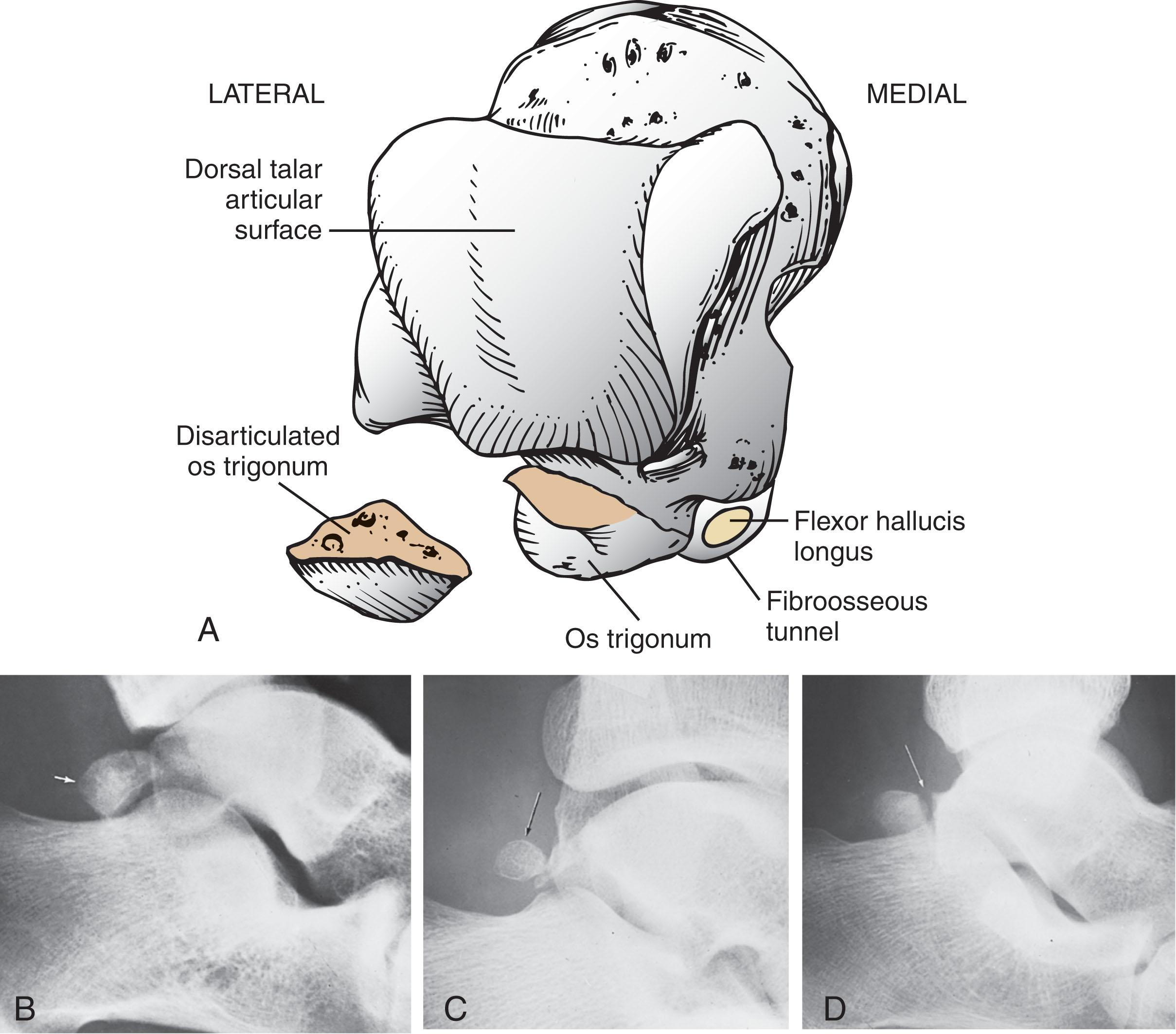
Petersen et al studied the blood supply of the FHL tendon by using injections and immunohistochemical studies of cadaver tendons. They found that peritendinous blood vessels penetrated the tendon and anastomosed with a longitudinally oriented intratendinous network. Two avascular zones were demonstrated: one near the posterior talus and the other at the first metatarsal head. The researchers thought that these explained the most typical areas for tendon degeneration and attritional rupture.
Cases reports of tenosynovitis of the FHL tendon are few. It has been described by Lapidus and Seidenstein and others, and small series have been reported by Hamilton (17 cases) and others.
Most often, tenosynovitis develops proximally at the level of the sustentaculum tali as the tendon enters the fibroosseous tunnel. Often associated with a plantar flexion en pointe position in ballet dancers ( Fig. 28-37 ), various pathologic conditions, including hypertrophy of the tendon, synovial adhesions, a more distal insertion of the FHL muscle, longitudinal degenerative tears, and nodularity in the region of the fibroosseous tunnel, have been associated with this condition. Hamilton reported FHL tenosynovitis associated with a symptomatic os trigonum, although Kolettis et al noted many cases without an os trigonum. Gould and Trevino et al have observed that a distal stenosing tenosynovitis could occur at the level where the FHL courses between the sesamoids.
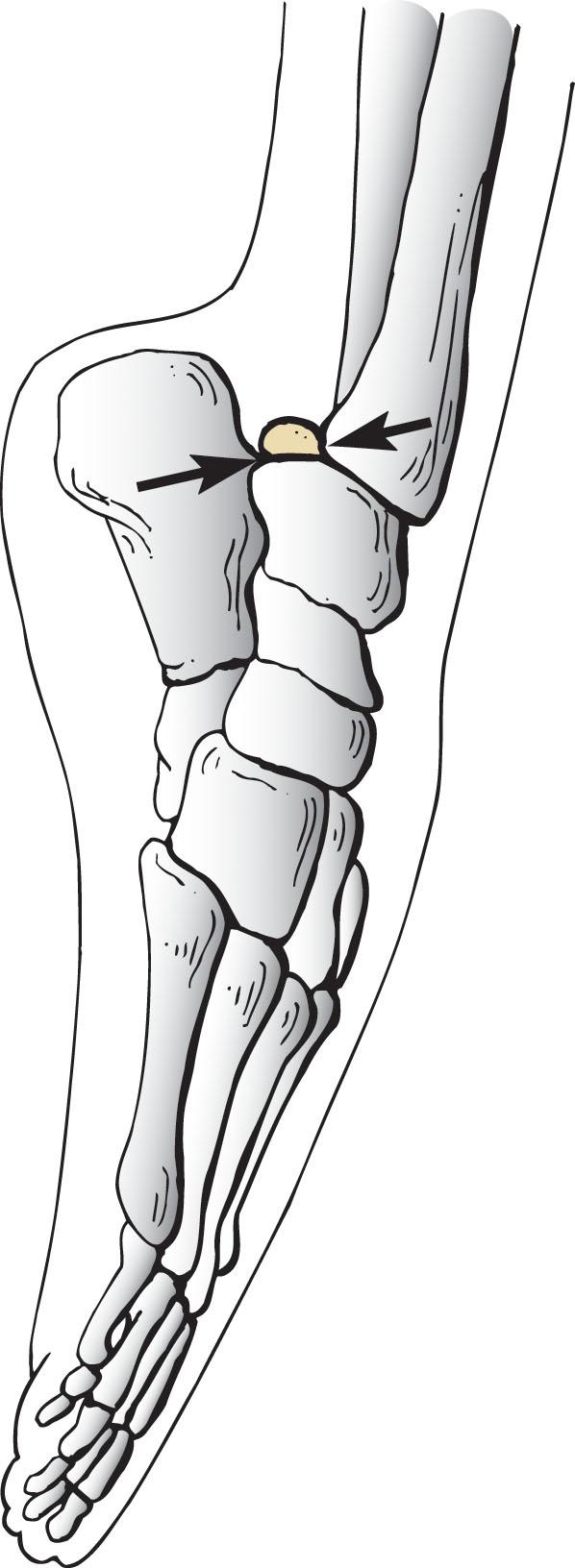
The spectrum of tenosynovitis, FHL triggering, nodularity ( Fig. 28-38 ), and tendon thickening in its natural course can lead to a degenerative tear of the FHL tendon ( Fig. 28-39 ). Frenette and Jackson and others have described stenosing tenosynovitis. Longitudinal tears of the FHL have also been reported in association with tenosynovitis. Trepman et al reported a patient who developed posteromedial ankle pain produced with active plantar flexion and passive dorsiflexion of the hallux. The patient had a tearing sensation in the posteromedial ankle with concomitant swelling and ecchymosis. On exploration, a longitudinal tear of the FHL tendon was identified and treated with a primary repair. Fusiform thickening, erosion of the tendon, and eventual triggering can develop from an overuse syndrome.
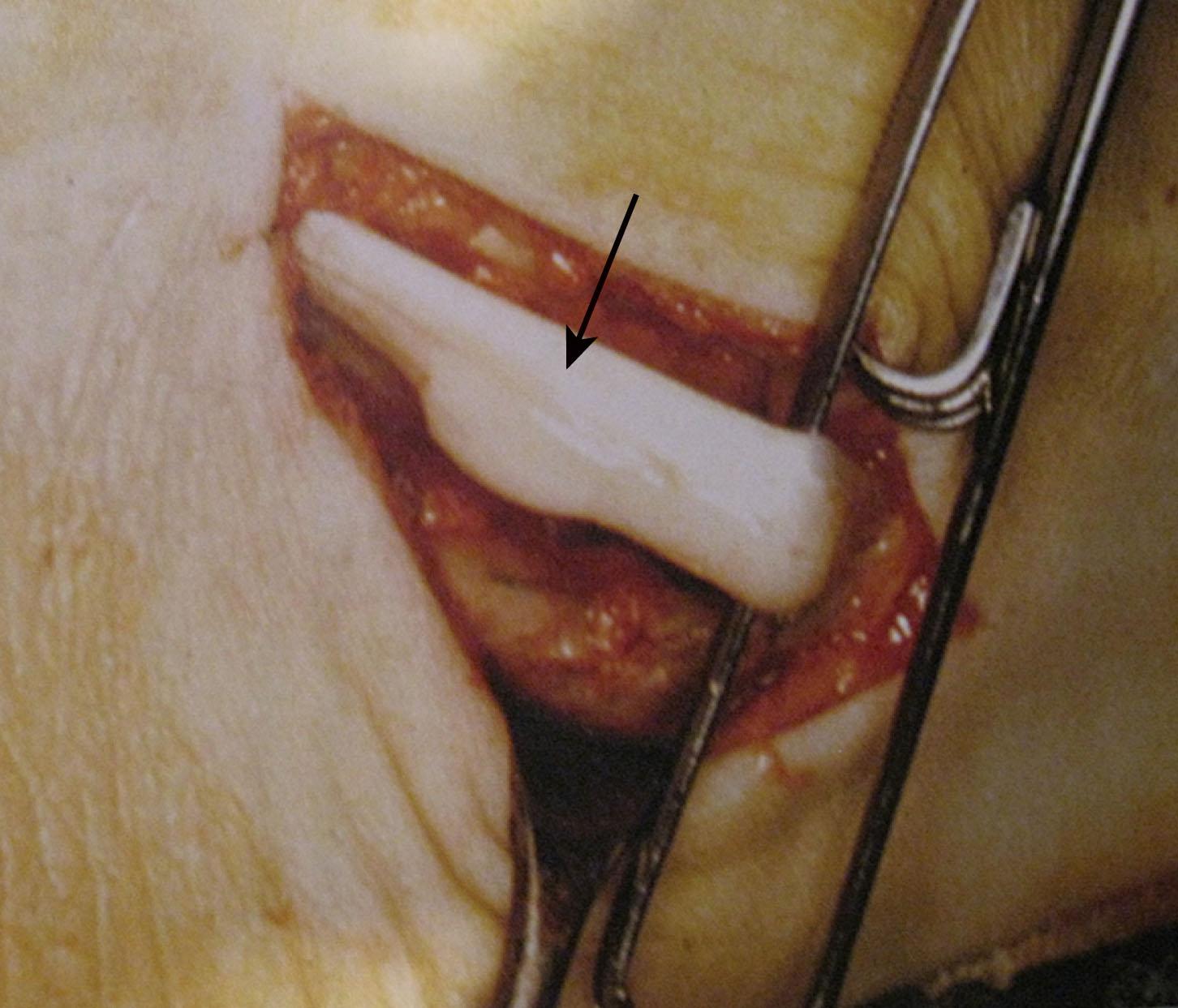
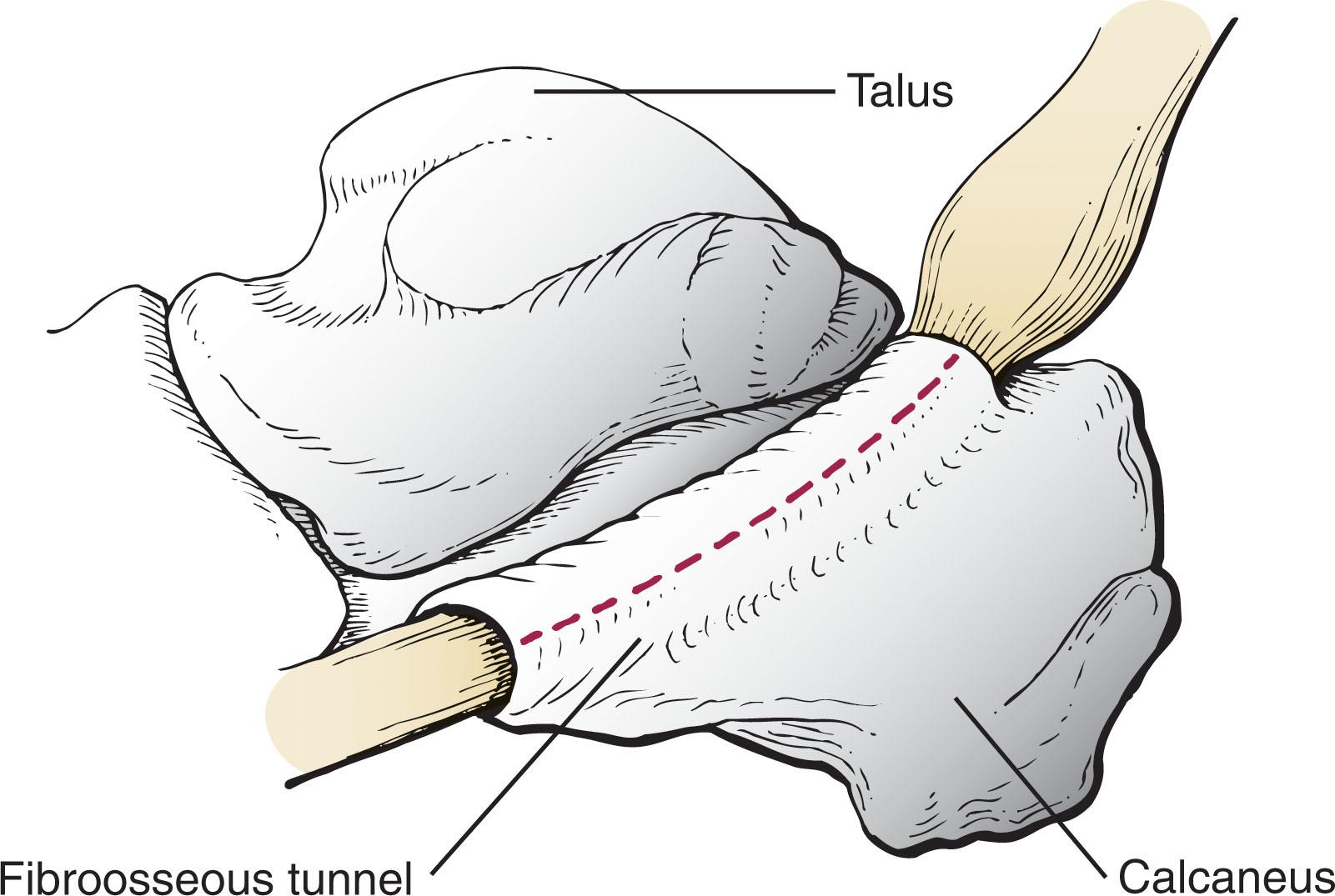
Another similar case is that of a professional dancer who had a history of triggering of the FHL tendon behind the ankle and suddenly developed a more acute pain associated with a catching or locking of the hallux, which precluded dance. On exploration, a flap tear of the FHL tendon was encountered in addition to the stenosis of the FHL tendon sheath. After release of the sheath and excision of the flap tear, the patient was able to return to Broadway as a principal dancer ( Fig. 28-40 ). Thus, the mechanical irritation of the tendon not only may be a source of pain but can also be a risk factor for rupture or tear. This has been observed by several authors, including Sammarco and Miller, who reported fusiform thickening of the FHL tendon with rupture of the central fibers. Kolettis et al reported stenosis of the tendon sheath, synovial hypertrophy, adhesions, mucoid degeneration, tendon nodularity, and several cases of partial FHL tendon tears. Several partial ruptures have also been reported. These can result from forced extension and against a contracted FHL muscle. Thickening or hypertrophy of the FHL tendon and the presence of a flexor digitorum accessorius longus can lead to constriction in the fibroosseous tunnel with subsequent tenosynovitis.
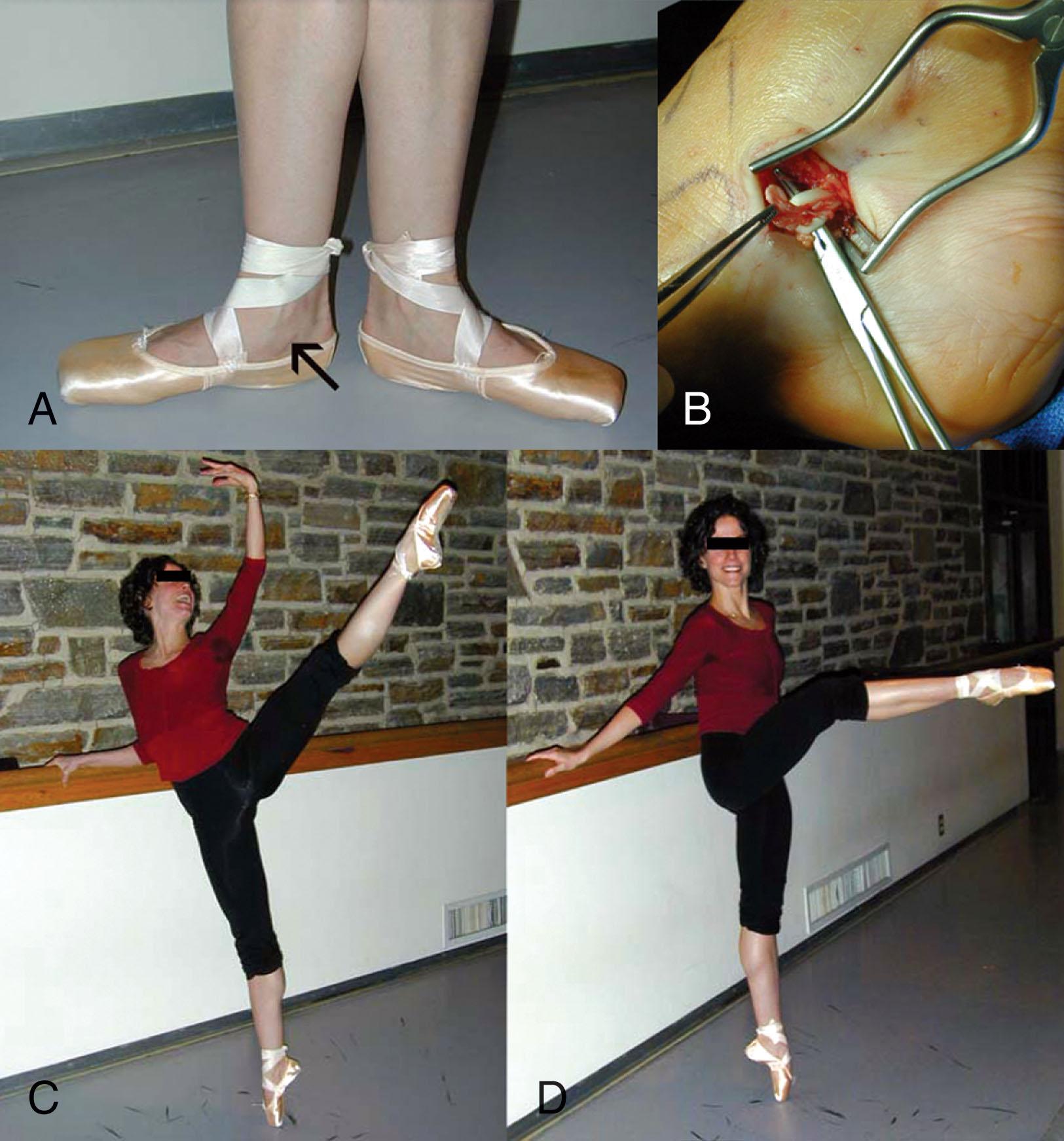
Entrapment or scarring of the FHL tendon can also occur after distal tibial, ankle, or calcaneus fractures with a different presentation and prognosis that is important to recognize. Patients complain of inability to roll through the forefoot and often a lack of dorsiflexion flexibility at the ankle as well. In these cases, the deformity increases with dorsiflexion and decreases with plantar flexion of the ankle. This checkrein deformity has treatment implications. If the tendon is adherent to the local bone or soft tissues, it is amenable to release. If the tendon is adherent and the muscle belly is fibrosed or bound down to the posterior tibia, then release is less productive, and muscle belly excision or tendon transection is necessary. Most of the time with these injuries, there is not enough function of the FHL that lengthening the tendon in the arch of the foot distal to the master knot of Henry is advised. In these cases, the muscle is functional, but the fibrosis that has occurred proximally is thought to be too great to relieve with a release ( Fig. 28-41 ).
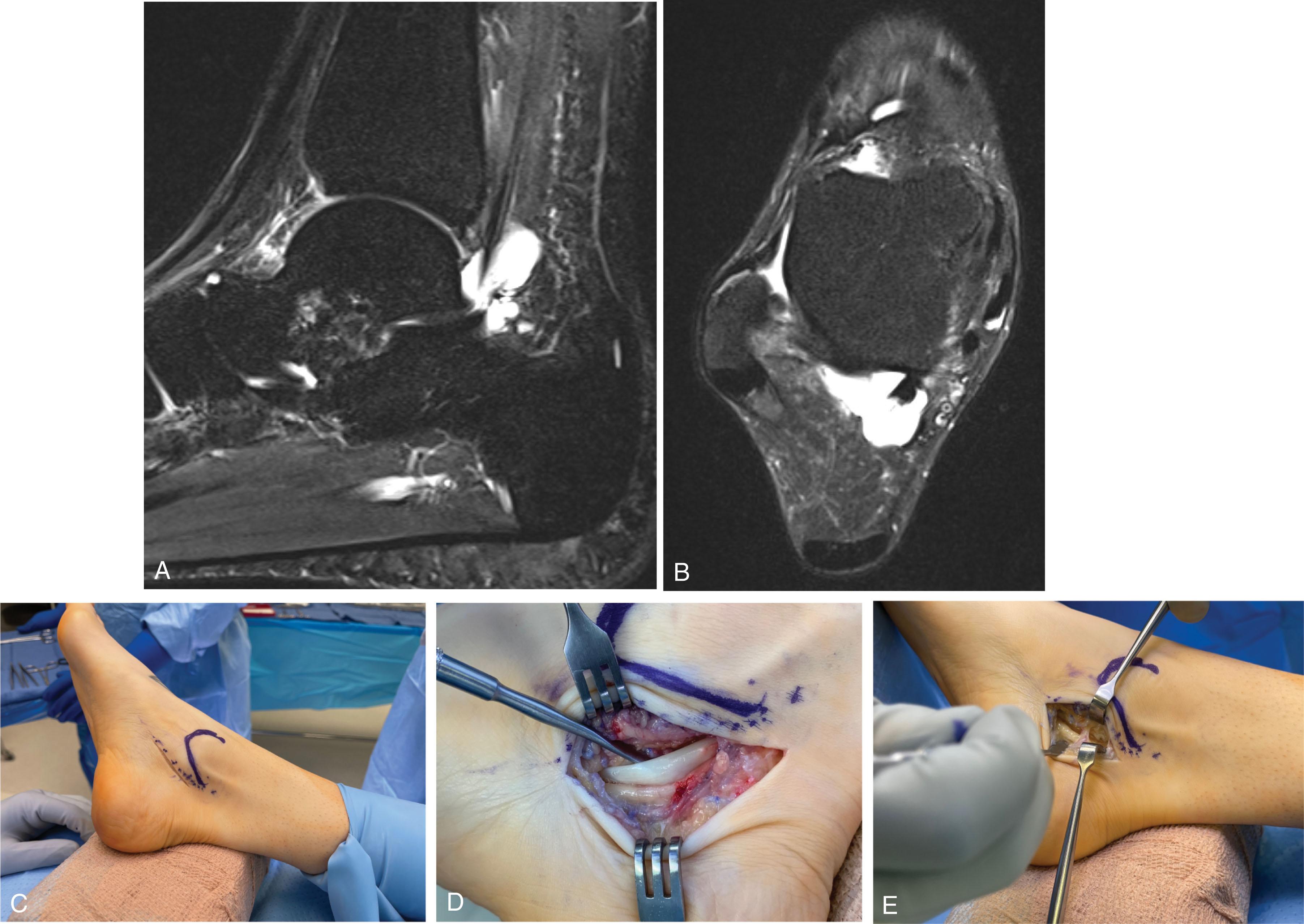
In addition to the mechanical factors, the tendon can develop pathologic processes associated with inflammatory arthropathy (rheumatoid arthritis, reactive arthritis, infection, gout, ulcerative colitis). Baan et al reported an 18% incidence of rupture of the flexor hallucis longus tendon in patients (11/60 patients) with long-term rheumatoid arthritis. Reduced first MTP joint motion and pes planus were noted in the study group with a ruptured tendon.
Other reported pathologic conditions include calcific myonecrosis, giant cell tumor of the FHL tendon sheath ( Fig. 28-42 ), osteochondromatosis of the flexor hallucis longus ( Fig. 28-43 ), trauma, and degenerative tendinoses of the FHL tendon ( Fig. 28-44 ). Pigmented villonodular synovitis of the anterior ankle may also be associated with an FHL tendon rupture ( Fig. 28-45 ).
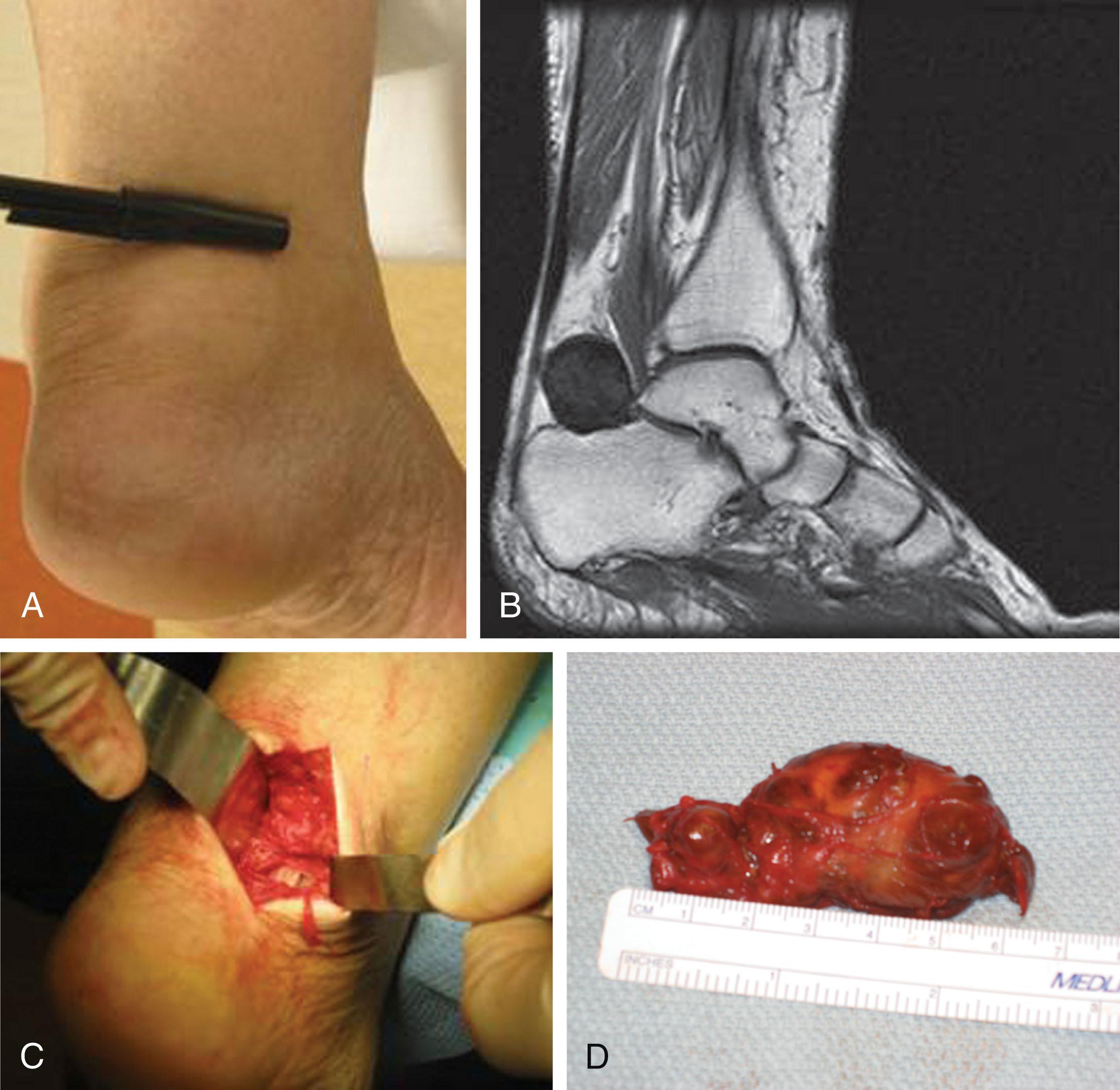
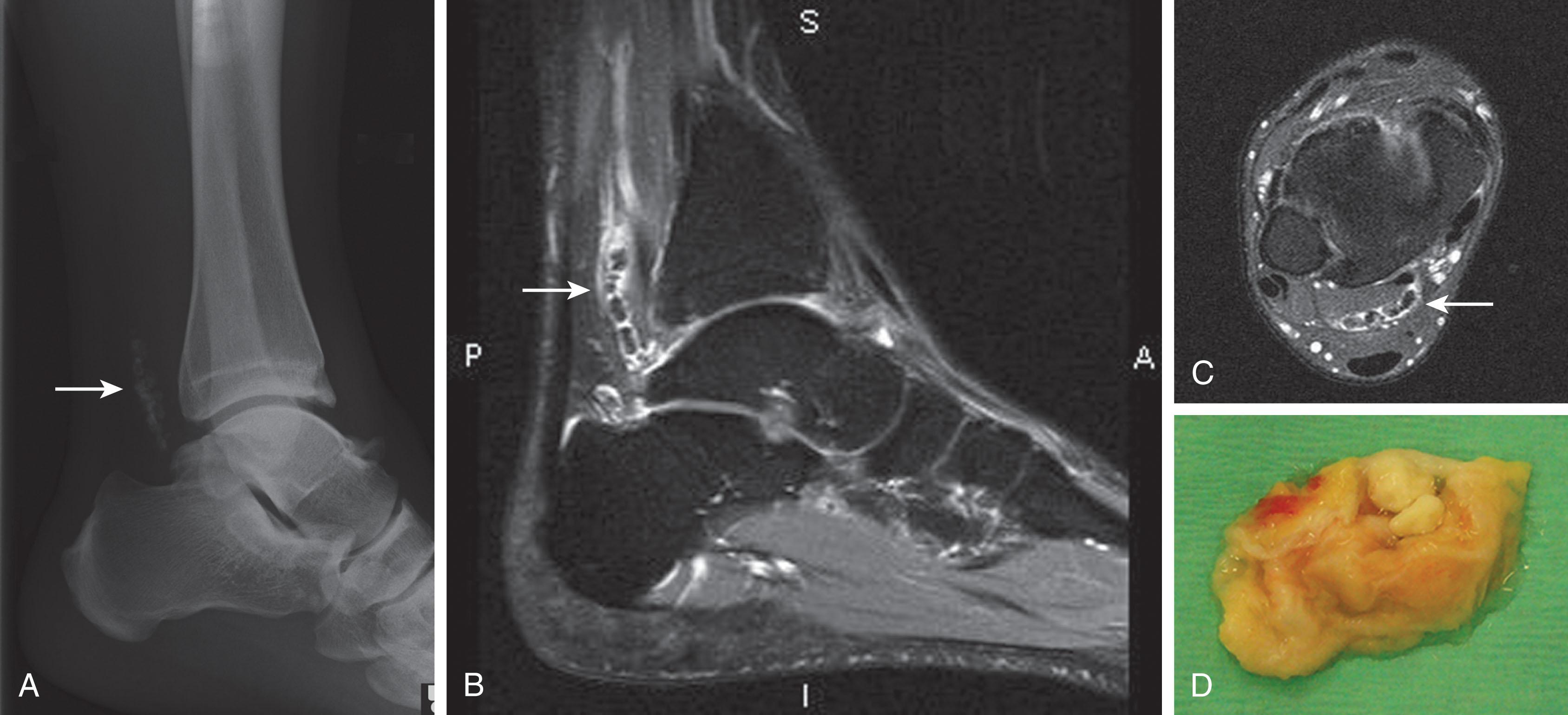
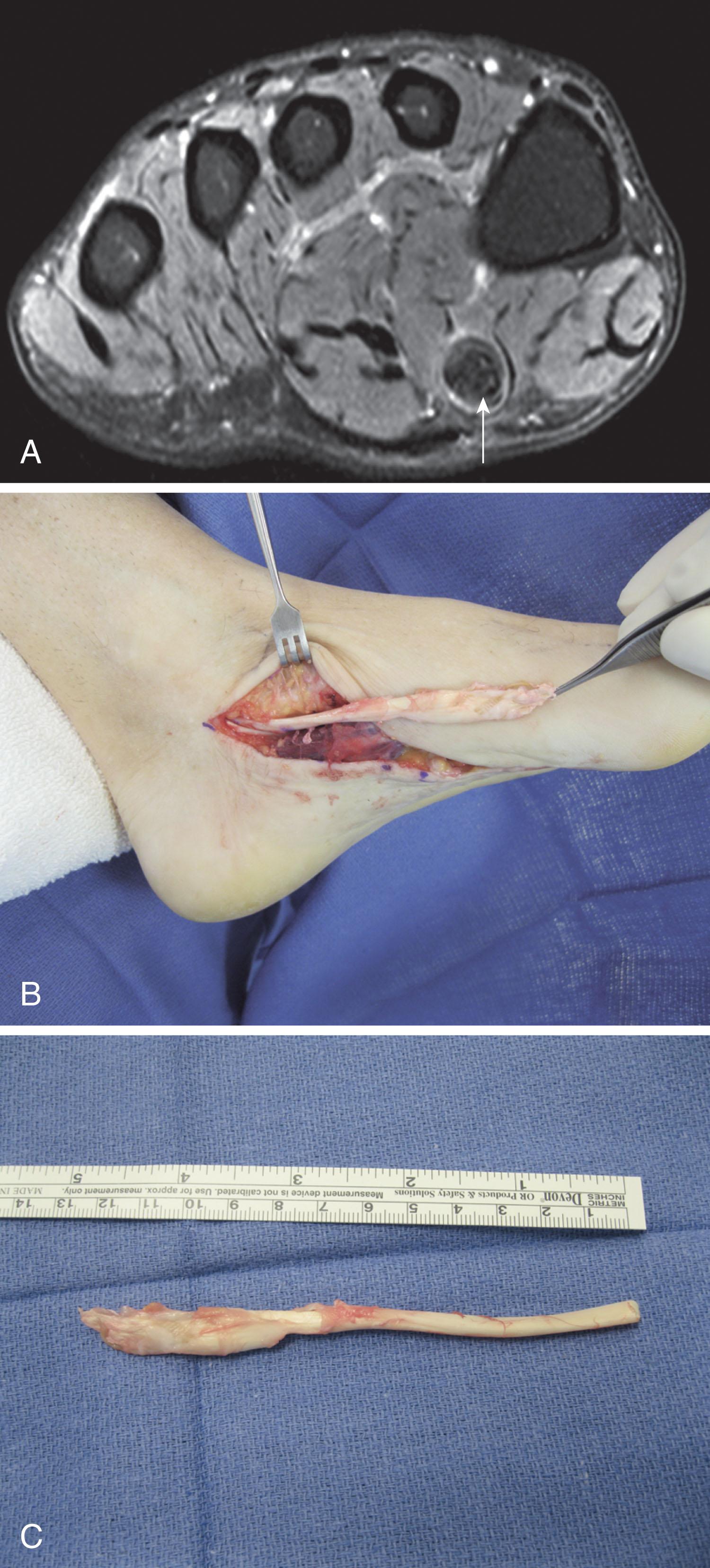
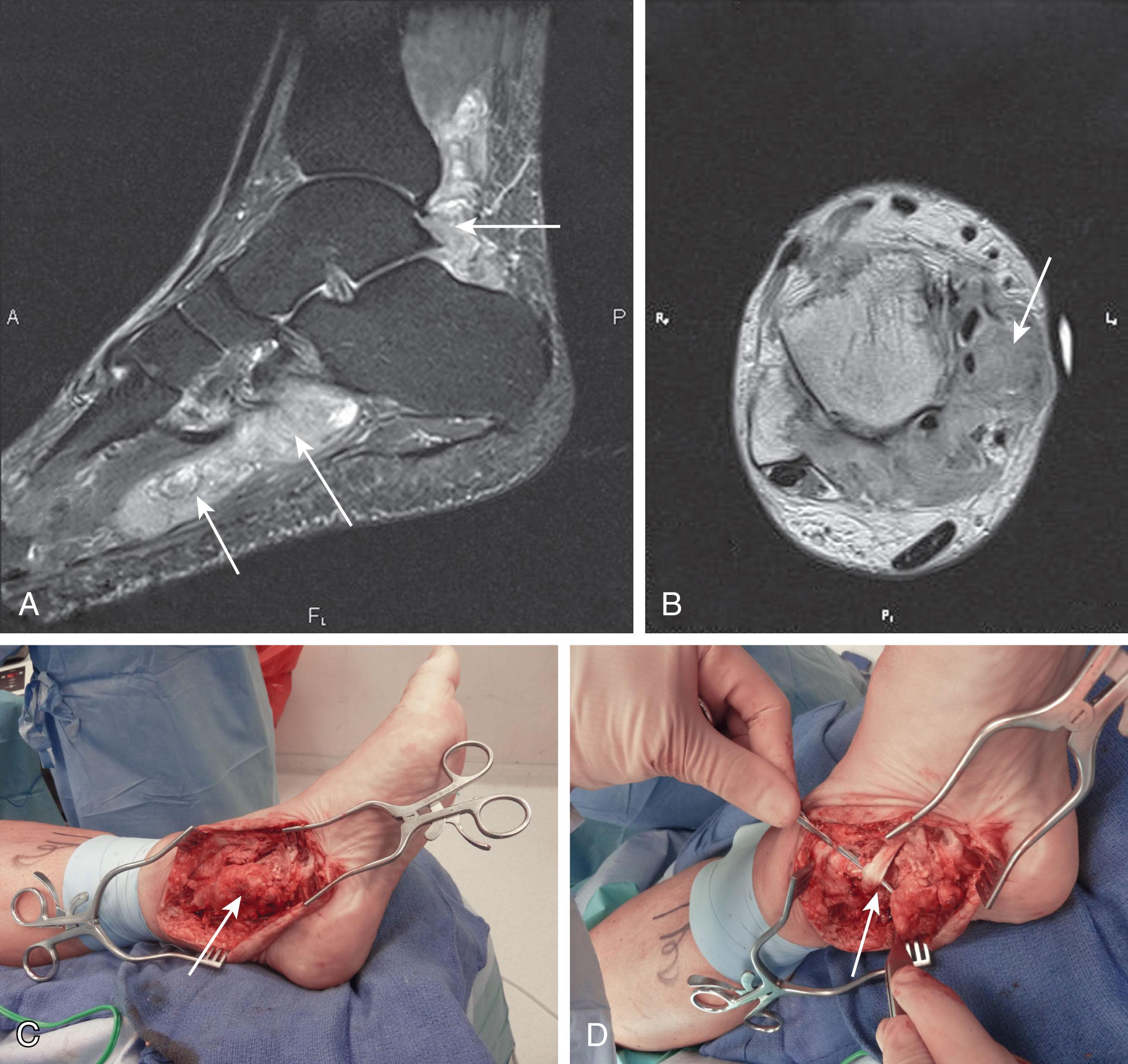
Patients often complain of a pain in the area of stenosis, a catching sensation, and some weakness during running, cutting, jumping, squatting, pushing off, or rising on the ball of the foot. Pain along the posteromedial aspect of the ankle or subtalar joint with these mechanical stressors is often noted. Some report an audible pop or a tearing sensation in association with the onset of acute pain. In ballerinas, an en pointe position can exacerbate symptoms. Also, the dancers note that when non–weight bearing and just repetitively pointing (plantar flexing the ankle and toes) and relaxing the foot and ankle they experience pain, clicking, popping, and a triggering of the hallux. Crepitus is often present on physical examination, but triggering is less common. Dancers may lose the ability to stand en pointe.
On examination, the FHL tendon sheath often feels thickened. Examination often reveals no active flexion of the IP joint with the hallux held in extension. There may be pain on palpation, depending on the area of disease. The pain may be localized to the posteromedial ankle, in the midfoot beneath the knot of Henry, or distally in the area of the FHL tendon insertion. Pain typically occurs with active plantar flexion of the hallux against resistance. With a partial tendon rupture, the patient can have swelling, ecchymosis, and pain with prolonged walking or running. Passive flexion and extension is typically painless. Active flexion may be absent or weak, depending on the degree of stenosis or the presence of a partial rupture. The patient can develop a mild flexion tenodesis of the MTP joint with passive ankle dorsiflexion. When the condition is severe, crepitation and triggering may be noted. If a nodule becomes incarcerated in the fibroosseous tunnel, the toe remains locked in extension.
Kolettis et al reported on 13 female ballet dancers who had chronic symptoms of FHL tenosynovitis on the medial aspect of the ankle. The major symptoms were pain and tenderness over the medial aspect of the subtalar joint at an average of 6 months before surgery. All patients had lost the ability to stand en pointe.
When flexor hallucis longus tenosynovitis manifests with pain in the posterior ankle, distinguishing between posterior ankle impingement and FHL tendinitis can be challenging. Because the two structures are close to each other, and these conditions can coexist in dancers, careful attention to diagnostic features is warranted. Both conditions can manifest with pain induced by active plantar flexion of the foot and ankle, but the trigonal or posterior ankle impingement usually occurs with passive full plantar flexion of the ankle, whereas FHL tendinitis does not. Dorsiflexion of the great toe while in the fully plantar-flexed position does not usually induce symptoms in impingement conditions but can in FHL tendinitis. The point of maximum tenderness in posterior impingement is usually posterolateral, whereas it is usually posteromedial with FHL tendinitis.
The Tomassen sign is another helpful diagnostic finding for FHL stenosis. With the ankle in dorsiflexion, MTP joint dorsiflexion is lost because of the tightness of the FHL tendon and a low-lying muscle belly as it courses through the fibroosseous tunnel.
Lateral radiographs of the ankle taken in neutral and full plantar flexion may show abutment of the os trigonum between the tibia and the talus and calcaneus or subluxation of the talus and tibiocalcaneal abutment in cases of posterior impingement but will be missing in FHL tenosynovitis.
Although Trepman et al and others have noted the usefulness of MRI in diagnosing FHL tenosynovitis and tears ( Fig. 28-46 ), Beauperthuy observed that an MRI was negative in three patients with longitudinal FHL tears. In Sammarco's series, only eight patients had MRI evaluations before surgery, but clinical correlation was found to be an important factor in interpreting the MRI. Oloff and Schulhofer reported that some patients with flexor hallucis longus tendinitis also had plantar fasciitis and tarsal tunnel syndrome. In their series, they found that MRI proved valuable in establishing the correct primary diagnosis in their series.
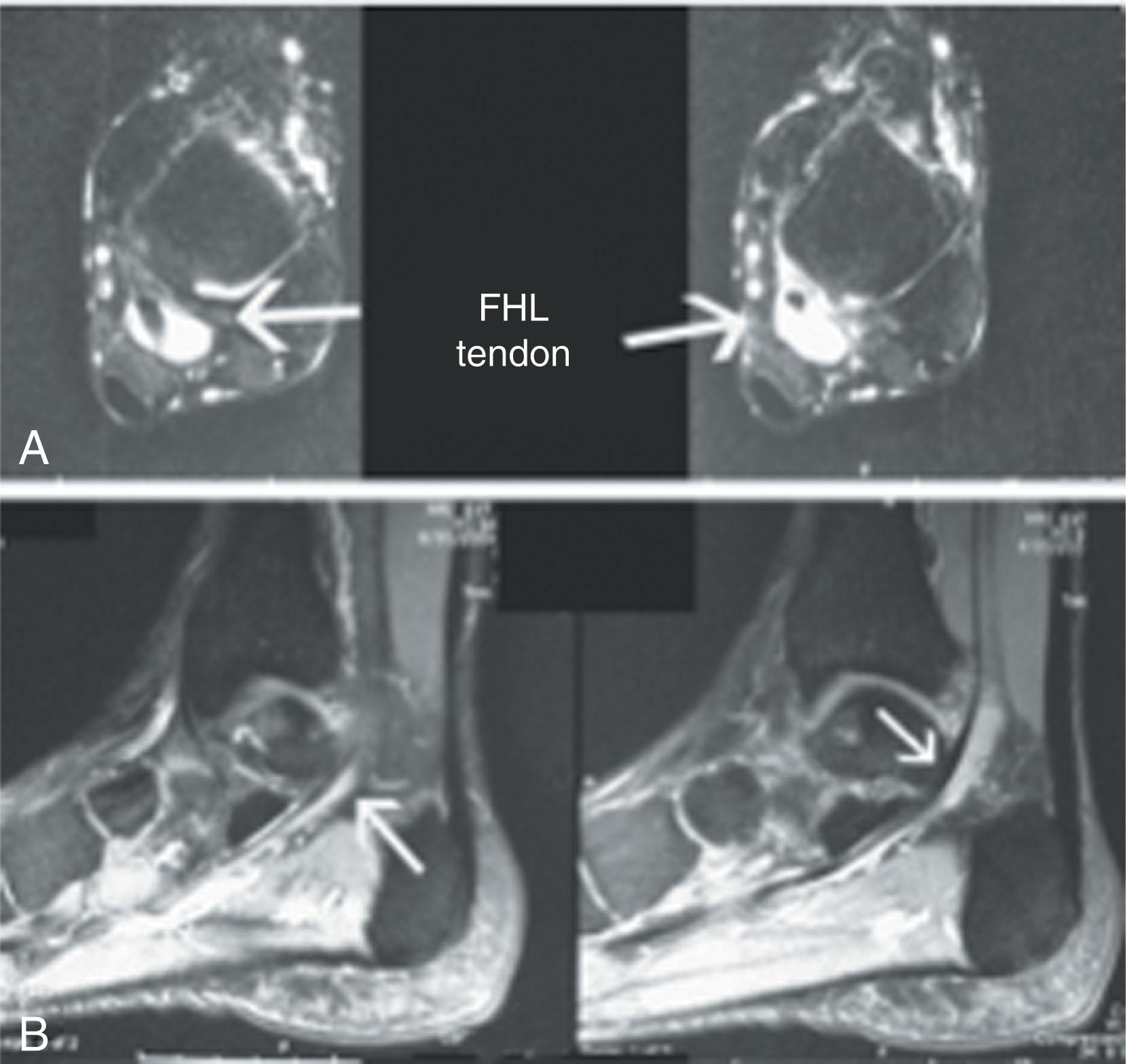
Dynamic ultrasound may be useful to identify pathology within the FHL tendon as well as triggering or snapping of the tendon in the stenotic sheath.
Nonsurgical treatment includes restricted activity, change in dancing and training technique, physical therapy, nonsteroidal antiinflammatory drugs (NSAIDs), ice and contrast baths, whirlpool, and orthotics. Immobilization does diminish symptoms. Occasionally, a corticosteroid injection into the tendon sheath is used judiciously and may be paired with immobilization, to avoid iatrogenic tendon rupture. An injection under fluoroscopic or ultrasound guidance is often advantageous to ensure the location of the needle and steroid ( Fig. 28-47 ). In cases where conservative treatment has failed or if the symptoms recur, a corticosteroid injection can often give dramatic relief of symptoms. Kolettis et al reported a risk of weakening or rupture of the FHL tendon after a steroid injection. Care must be taken to avoid an intratendinous injection, and Reinhertz stressed that steroid injections are not routinely recommended because they can contribute to spontaneous rupture.
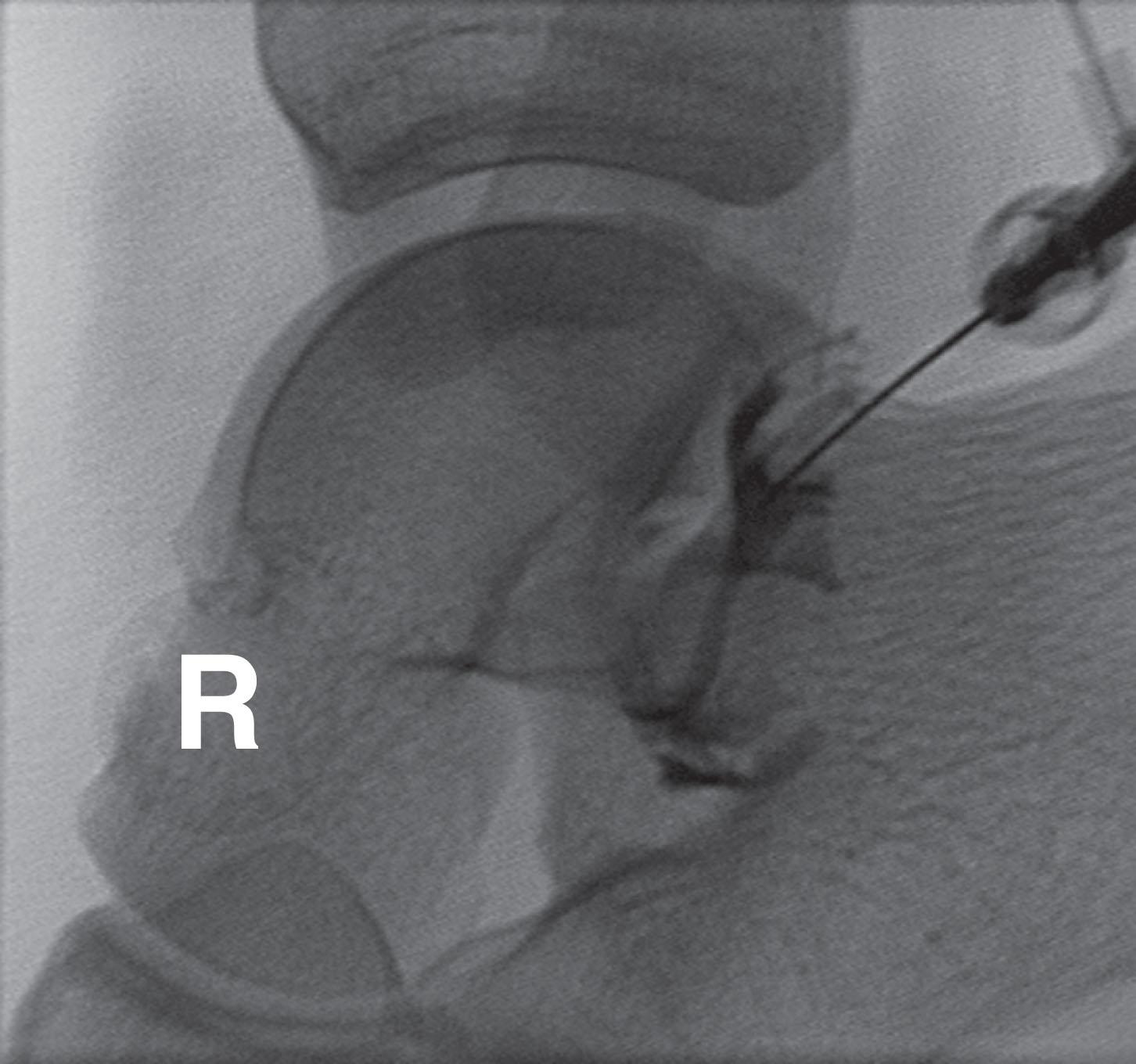
Surgery is indicated with the failure of conservative therapy ( Fig. 28-48 ). During surgery, the sheath can be three to four times thicker than normal according to Lynch and Pupp. Degenerative changes within the tendon at the time of surgical exploration are typically characterized by yellowing, calcification, or degenerative tears. The pathologic tendon sheath is incised in a stepwise process. If the tendon continues to catch or if the thickness is more than 1 or 2 mm wider, the thickened area of the tendon is resected. Very rarely, new pulleys in the retinacular area are needed to stabilize the tendon. A partial FHL tendon tear is repaired or resected, or a nodular area is contoured if necessary.
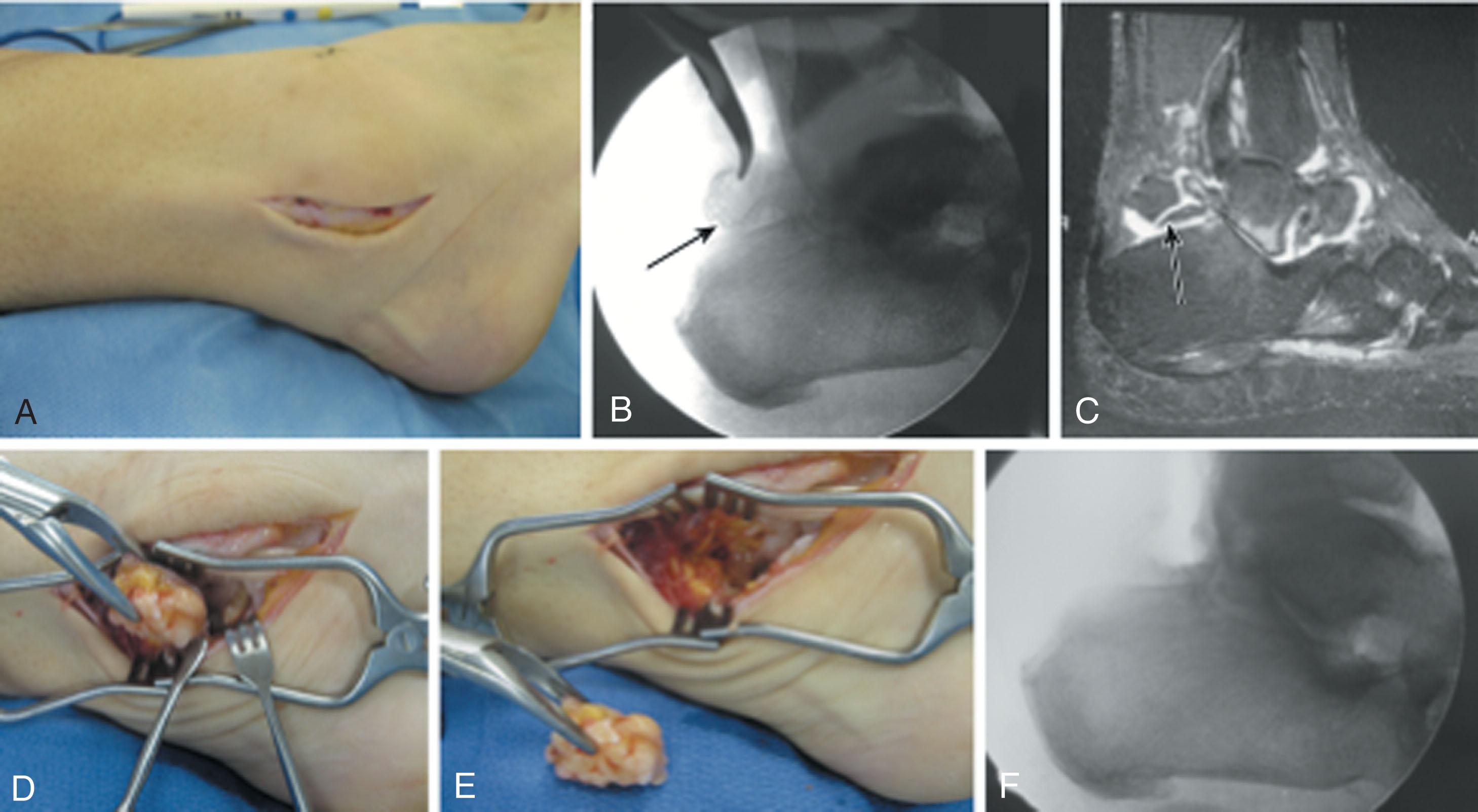
If an os trigonum is present or if there is a large trigonal process, resection is considered if there was preoperative posterior impingement symptoms or if there is persistent catching after releasing. In the case of excision of an os trigonum as well, there are alternatives for surgical exposure. A posterior debridement and os trigonum excision can be performed from a medial or lateral approach ( ). The lateral approach is favored in the presence of isolated posterior impingement without a history of FHL tenosynovitis. A medial approach is favored with the combined presence of both FHL tenosyovitis and posterior impingement. Hamilton has favored a medial approach with exposure of the neurovascular bundle, unless there is a clear-cut case of merely a symptomatic os trigonum.
An alternative to open release is posterior ankle arthroscopy in the prone position ( and ). Removing the os trigonum arthroscopically results in less tissue disruption, though an adequate release of the FHL during this approach requires experience with posterior ankle arthroscopy. Keeling and Guyton reported in a cadaveric anatomic study that access to the FHL sheath during posterior arthroscopy is limited. Corte-Real et al reported on the use of posteromedial and posterolateral portals to perform endoscopic debridement of FHL tendinitis in 27 patients at mean follow-up of 32 months. A total of 81% of patients returned to their initial level of work and sports. They noted a relatively high complication rate of 18% with most related to wound problems. See Chapter 39 for details of posterior ankle arthroscopy.
The technique is as follows.
With the patient in a supine position, a pneumatic tourniquet may or may not be used for hemostasis. A 3- to 5-cm curvilinear incision is made posterior to the medial malleolus and directed toward the navicular.
The neurovascular bundle is retracted, revealing the FHL in its fibroosseous sheath. Alternatively, the FDL tendon sheath can be opened, and the dissection directed to the bone with retraction of the FDL tendon posteriorly with the neurovascular bundle. The deep aspect of the sheath is then released to gain exposure to the FHL tendon.
The retinaculum is released proximally to the level of the sustentaculum tali, and the tendon is inspected.
A tenosynovectomy is performed. Any nodules are excised. Longitudinal tears are repaired.
With a tear that extends into the midarch, Boruta and Beauperthuy recommend releasing the knot of Henry to debride and repair a longitudinal tear. The interconnecting tendon between the FHL and FDL is excised.
Any prominent distal muscle fibers are excised.
The hypertrophic tenosynovial tissue is debrided, and if a longitudinal tear is present, it is repaired primarily. The hallux is then flexed and extended to demonstrate excursion of the tendon. The FHL is released until the retinaculum no longer prohibits its gliding motion. If the surgery is done under local anesthetic with intravenous sedation, it is useful to have the patient aggressively flex and extend the ankle and toes while the ankle is palpated for persistent crepitance.
The tendon sheath is not closed, but the distal soft tissue is approximated. The skin is closed in an interrupted fashion (see Fig. 28-41 ).
The technique is as follows.
With the patient in a lateral decubitus or prone position, a pneumatic tourniquet may be applied and used to achieve hemostasis.
A curvilinear incision is made just posterior to the posterior border of the fibula. The fatty tissue that contains the sural nerve and vascular structures are reflected posteriorly as a unit as the dissection is performed directly over the peroneal retinaculum. The retinaculum is incised just behind the peroneal tendon sheath. Care is taken to identify and protect the sural nerve (see Fig. 28-48A–C ).
The dissection is deepened posteriorly and medially to the peroneal tendons in the interval between the FHL tendon medially and the peroneal tendons laterally.
The posterior ankle capsule is incised, and the os trigonum is exposed on the superior aspect of the calcaneus just lateral to the tendon of the flexor hallucis longus (see Fig. 28-48D ). It is useful to place two small Hohman retractors. One is placed over the dorsal aspect of the os trigonum and the other just posterior. A small-toothed laminar spreader can then be inserted to further facilitate exposure.
The os trigonum is excised by a circumferential dissection that releases numerous fibrous attachments to the surrounding tissue. Any dissection medially must be performed judiciously because of the presence of the neurovascular bundle. Using a curet placed deep to the medial aspect of the fragment to lift and elevate the bone away from dense medial soft tissue attachments can minimize inadvertently leaving a small avulsed fragment behind. Attention should also be directed to identify visually, radiographically, and by palpation any loose bodies or sharp bone fragments around the os trigonum or adjacent to the flexor tendon sheath.
After removal of the os trigoum, the ankle is maximally dorsiflexed and plantar flexed to ensure there is no residual impingement between the calcaneus and the tibia (see Fig. 28-48E ). Intraoperative fluoroscopy of the ankle in both plantar flexion and dorsiflexion is helpful. Several oblique angles for fluoroscopy (10–20 degrees internally and externally) can sometimes reveal a small retained fragment or bony prominence.
A layered closure is then performed with absorbable sutures. The ankle is splinted for 1 to 2 weeks after surgery to ensure adequate soft tissue healing (see Fig. 28-48F ).
The technique is as follows.
With the patient in a supine position, a pneumatic tourniquet may be used to create a bloodless field.
A curvilinear incision is centered over the neurovascular bundle just posterior to the medial malleolus, beginning just above the upper border of the os calcis and continuing to a point just inferior to the tip of the medial malleolus. The incision is deepened through the fascia and laciniate ligament, with care taken to protect the neurovascular bundle ( Fig. 28-49A ).
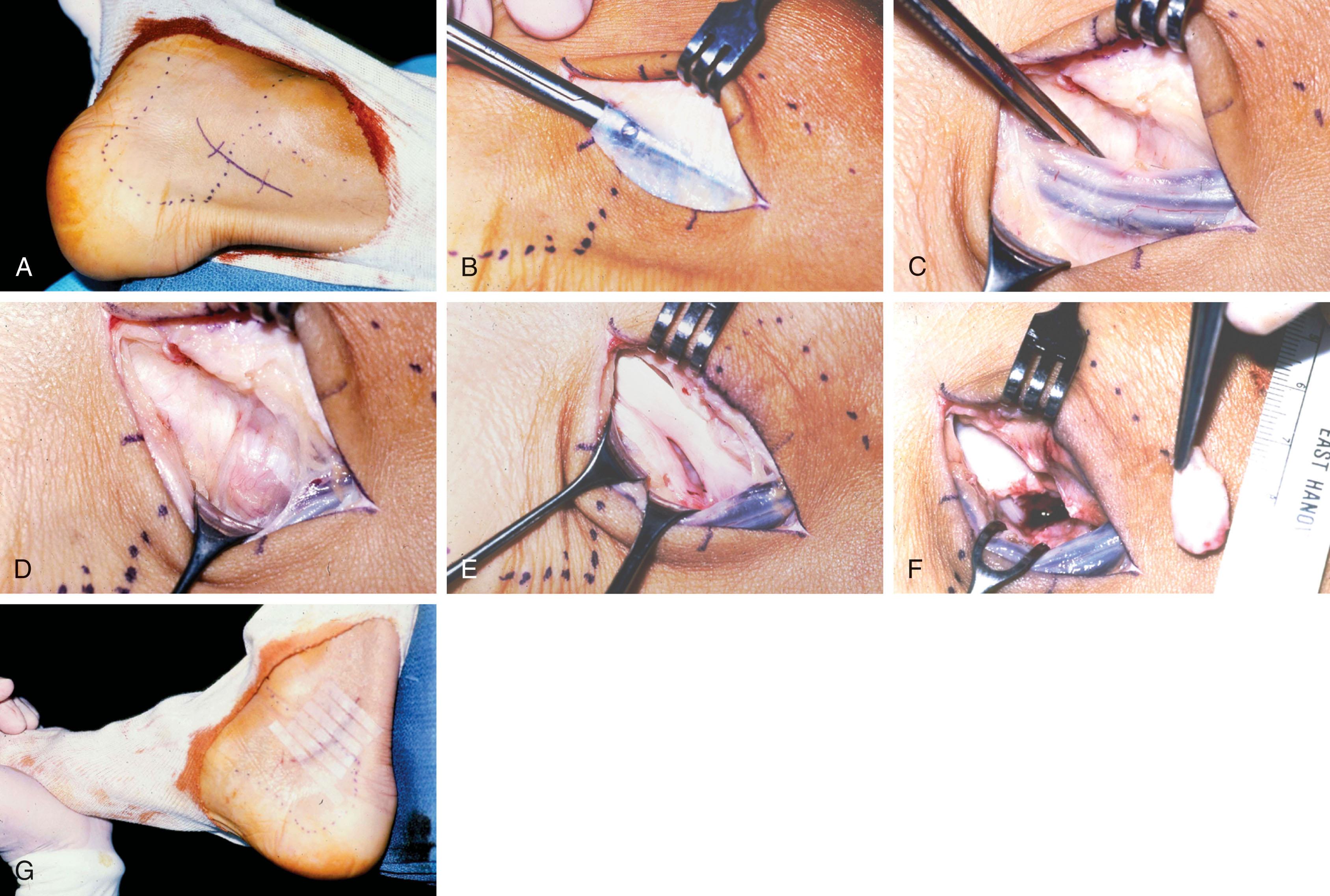
The surgeon then must choose whether to dissect anterior or posterior to the neurovascular bundle. Posteriorly, the sensory branches to the calcaneus are encountered. The anterior exposure, in general, is preferable, taking the entire posterior tibial nerve and branches posterior. Different branching patterns of the nerve occur in this area, and the nerve should be carefully exposed and protected with blunt retractors or vessel loops ( Fig. 28-49B and C ). Alternatively, the FDL tendon sheath can be opened and the dissection kept on the tibia and talus with retraction of the FDL tendon posteriorly with the neurovascular bundle. The deep aspect of the sheath is then released to gain exposure to the FHL tendon.
The tendon of the flexor hallucis longus is exposed ( Fig. 28-49D ), and a tenolysis is performed ( Fig. 28-49E ). The sheath can be quite thickened in this area but thins as it courses beneath the sustentaculum tali.
The tendon should be inspected for fibrillation, tears, and loose bodies within the sheath. If present, tears should be carefully excised or repaired.
Next, the freed tendon can be retracted posteriorly along with the entire neurovascular bundle. The os trigonum can now be visualized on the lateral aspect of the tunnel of the FHL.
Once the os trigonum is identified, it can be resected with a circumferential dissection, staying right on the bone as it is excised. Once the os trigonum has been removed, the posterior ankle joint is inspected for loose bodies or remaining bone fragments. In some cases, a large prominent articular facet on the superior surface of the os calcis remains (this previously articulated with the os trigonum). When present, it should be resected using a thin osteotome or chisel ( Fig. 28-49F ).
The wound is closed in layers with absorbable sutures while holding the ankle in the neutral position ( Fig. 28-49G ). The tunnel of the FHL tendon should not be closed. A well-padded posterior plaster splint or below-knee cast is applied. The patient remains non–weight bearing postoperatively.
The foot and ankle are enclosed in a soft dressing and a below-knee splint or cast for 7 to 14 days, and the patient remains non–weight bearing. Then the splint or cast is removed and physical therapy is initiated, including strengthening exercises, range-of-motion activities, and full weight bearing. The use of a protective boot for ambulation for another 6 weeks is helpful to prevent reinjury.
Results of treatment of FHL tenosynovitis are confined to small case series, often with mixed indications and treatments. Generally favorable results are reported for surgical release, debridement, tendon repair when indicated, and os trigonum excision when impingement coexists. Routinely good and excellent results have been reported after surgical exploration, tenosynovectomy, and repair of the longitudinal degenerative tears of the FHL tendon, when present. A series of 14 patients that underwent extensive release and tenosynovectomy of the FHL for tenosynovitis at 1 year reported AOFAS ankle hindfoot score improved from 62 ± 11 to 90 ± 9 and visual analog pain score was improved from 4.0 ± 0.8 to 0.4 ± 0.5 at the final follow-up. Results of arthroscopic techniques have also been reported in small case series.
Hamilton et al reported their results of surgically treating posterior ankle pain in dancers, with an average follow-up of 7 years. Thirty-seven dancers underwent 41 operations: 26 operations for tendinitis and posterior impingement, nine for isolated tendinitis, and six for isolated posterior impingement syndrome. Thirty ankles had a good or excellent result, six had a fair result, and four had a poor result. The results were good or excellent for 28 of the 34 ankles in professional dancers, compared with only two of the six ankles in amateur dancers. This discrepancy can reflect the higher expectations and a poorer ability to compensate in the amateur population.
Sammarco and Cooper reported on FHL tendon injuries in dancers and nondancers. Thirty-one cases of flexor hallucis longus injuries in 26 patients were treated over a 16-year period. The two groups were compared with regard to age, activity, duration of symptoms, operative findings, histopathology, and postoperative time to resumption of full activities. These patients required surgery for unsuccessful nonoperative treatment. In the dancers, 71% of patients had a partial longitudinal tear of the flexor hallucis longus compared with 30% in nondancers. Isolated tenosynovitis occurred in only 21% of the dancers but in 53% of the nondancers. Dancers tended to have symptoms for a longer period before seeking treatment than did nondancers. Surgical intervention for the tenosynovitis and tendon tears yielded good or excellent results in 14 of 15 dancers and 9 of 11 nondancers.
Oloff and Schulhofer reported on a cohort of patients with FHL tendinitis. In their retrospective series of 19 consecutive cases, they reported that the condition occurred in primarily nonathletic, male, and middle-aged patients. The mean symptom duration was 20 months, with frequent previous misdiagnosis. They found overlapping signs and symptoms of flexor hallucis longus tendinitis, plantar fasciitis, and tarsal tunnel syndrome. MRI and tenography proved valuable in establishing the correct primary diagnosis in their series. Flexor hallucis longus tenolysis was successful in each case, with a mean return to regular activity at 9 weeks.
Gould, who believed that trauma was a causative agent, reported three cases that responded to a lidocaine anesthetic injection that basically lysed adhesions.
With cases that have stenosis or synovitis at areas other than the ankle and subtalar joints, after attempted conservative treatment, consideration of a soft tissue release at the site of tendon constriction is warranted. Sanhudo described additional cases of distal stenosis at the sesamoid area.
Primary rupture of the FHL tendon has been described in individual case reports ( Fig. 28-50 ). Typically, these injuries occurred in association with athletics after running, dancing, tennis, diving, and soccer, although in one case a rupture occurred after prior first-ray surgery. Locations include distal ruptures and proximal ruptures at the level of the sustentaculum. Baan et al has reported a high rate of flexor hallucis longus ruptures in patients with long-standing rheumatoid arthritis. A rupture in the midarch just distal to the knot of Henry was reported in a marathon runner. Trepman et al reported a longitudinal tear of the FHL tendon. They performed a tenolysis, tenosynovectomy, and excision of the prominent distal muscle fibers.
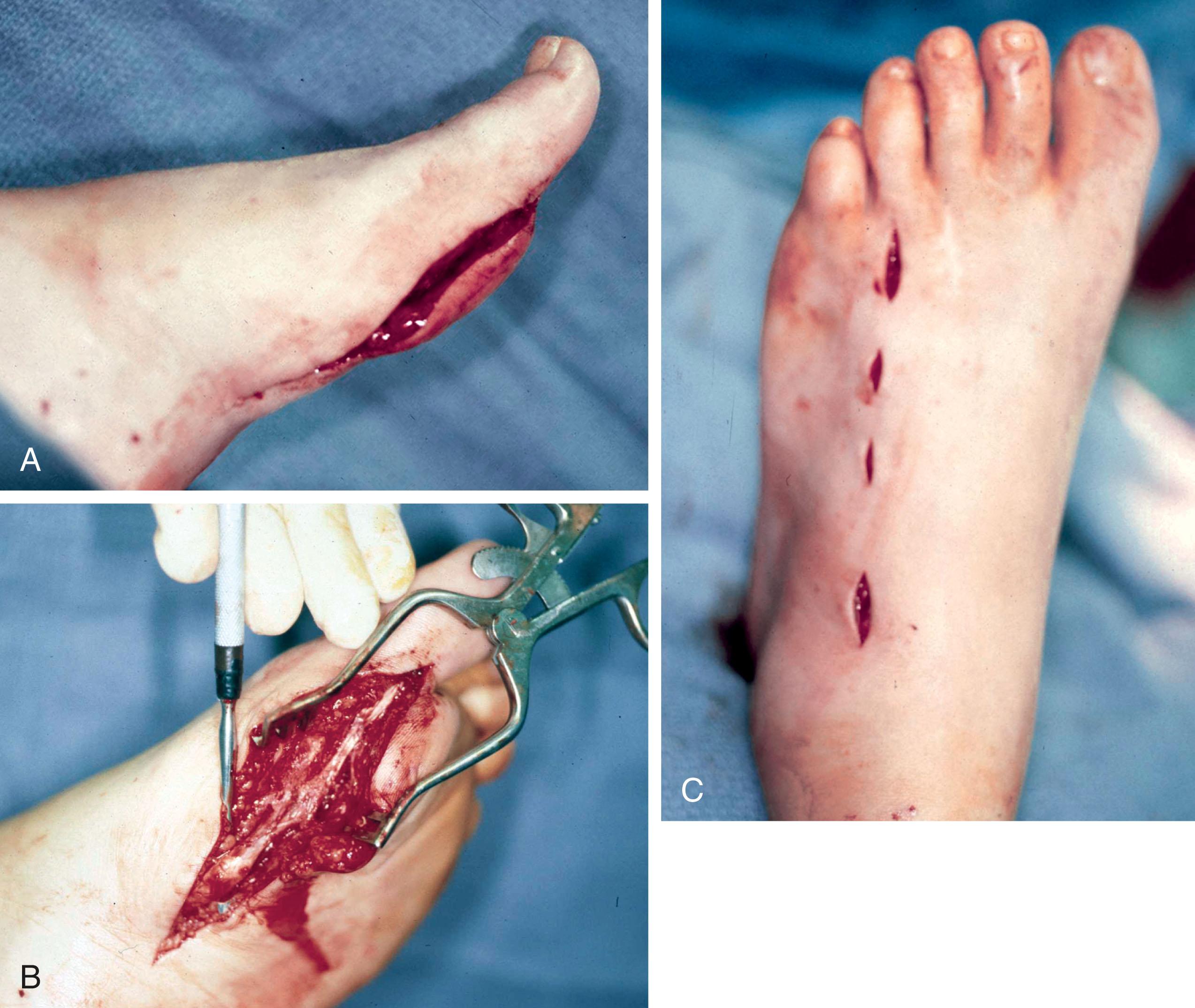
Although isolated spontaneous ruptures have been reported in the literature, the major reason for a loss of continuity is laceration of the tendon. Floyd et al and others reported on a total of 35 disruptions of the FHL tendon at varying locations along the course of the tendon.
Iatrogenic injury to the FHL tendon in zone 1 can occur with a phalangeal osteotomy (Akin procedure); careful retraction is necessary to avoid injury to either the FHL or EHL tendons with this procedure ( Fig. 28-51 ). Intraoperative transection of the FHL can also happen inadvertently during harvest of the FDL tendon for a posterior tibial tendon reconstruction procedure performed through a medial infranavicular approach. The tendon slip that connects the FDL to the FHL tendon tethers the FHL as the FDL is drawn more medially to permit its sectioning. Because the FDL is cut at the depths of the exposure, it is possible to be unaware that the FHL tendon is inadvertently being transected simultaneously. Loss of resting tone of the hallux is noted when this occurs. While flexing the hallux and performing further distal sharp dissection through the fibrous arcade of the FHB, the distal end of the FHL should be identified for repair ( Fig. 28-52 ). FHL injury can also occur with posterior ankle arthroscopic procedures.


The site of FHL disruption can be divided into zones ( Box 28-2 ). A disruption in zone 3 leads to proximal retraction of the tendon while injuries in zones 1 and 2 are not characterized by retraction of the proximal segment because of the fibrous slip connecting the FHL and FDL ( Fig. 28-53 ). With zone 1 injuries, a laceration leaves the tendon edges in proximity in a fairly subcutaneous region; however, the tendon is surrounded by a tendon sheath, and fibrous scarring is common. In zone 2, although the FHL is located in the deep arch of the foot, retraction is uncommon. Zone 2 injuries are characterized by a lesser degree of postoperative adhesions.
Zone 1: Distal to the sesamoids in the area just proximal to the FHL insertion
Zone 2: Between the sesamoids and the knot of Henry
Zone 3: Proximal to the knot of Henry
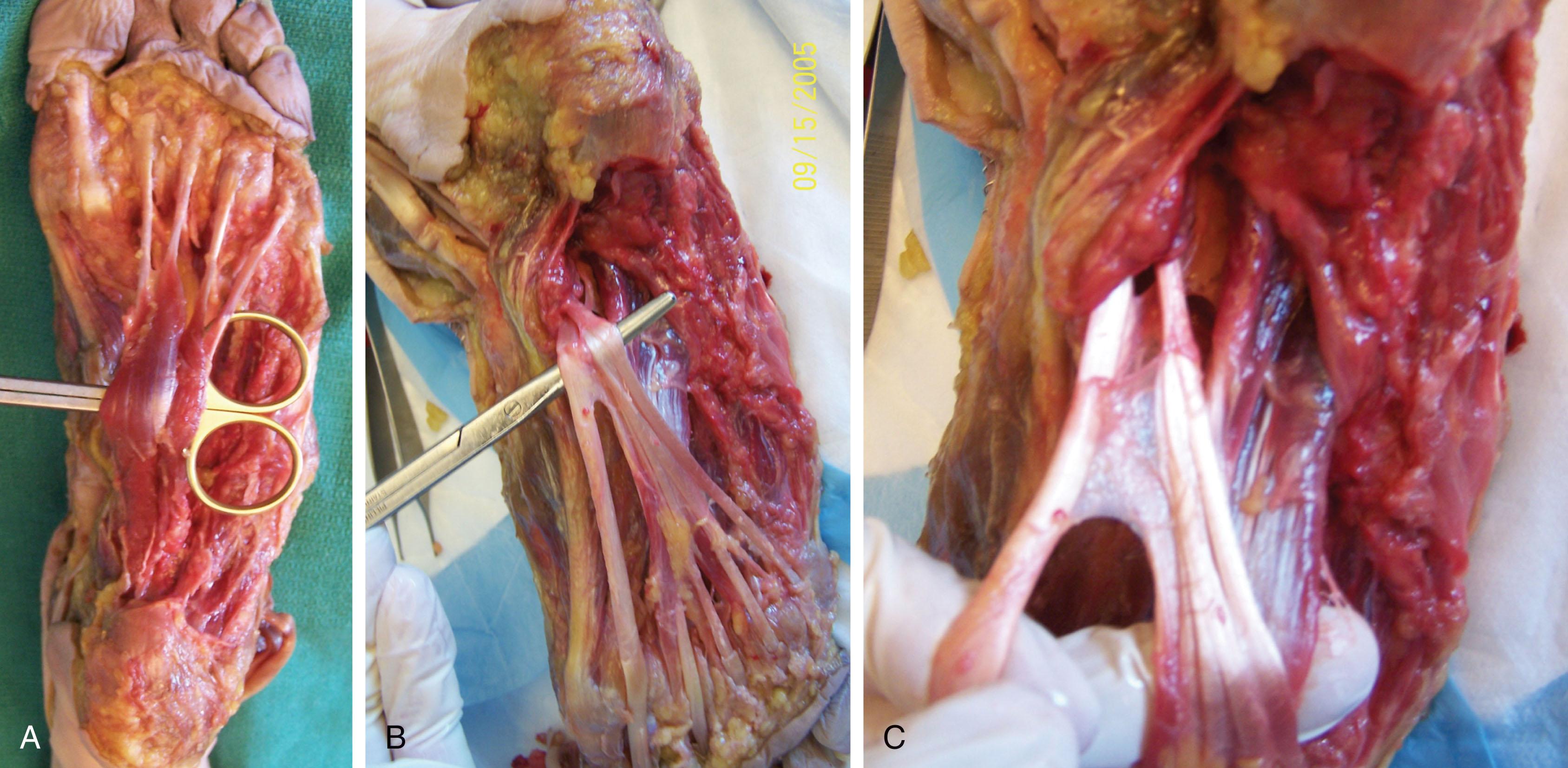
On the plantar aspect of the foot, the tendons and neurovascular structures are vulnerable to penetrating injuries. Frenette and Jackson reported a high incidence of nerve disruption after lacerations of the FHL. The first common digital nerve and proper digital nerve course along the medial and lateral aspect of the FHL tendon in a superficial area and are vulnerable to injury along with laceration of the FHL. The authors noted that in 75% of injuries in which a laceration was distal to the origin of the FHB, the proper or common digital nerve was lacerated as well. Wicks et al reported that 60% of feet in their series demonstrated nerve injury. Frenette and Jackson reported that 80% of injuries in their series resulted from stepping on glass while barefoot.
After penetrating injury, a patient might note subjective loss of push-off power and a feeling of giving way. A prodromal period followed by a sudden snap can herald an attritional FHL tendon rupture. The recognition of spontaneous dorsiflexion of the toe and discomfort with pressure of the hallux against the top of the toe box may be coupled with an inability to flex the tip of the toe. A patient might give a history of forced dorsiflexion against resistance or of being involved in a repetitive activity, such as rising on the ball of the foot or running, cutting, and jumping. Rupture of the FHL tendon can also be associated with systemic disease, trauma, and athletic or dance activity. In patients with a spontaneous rupture, a popping or tearing sensation may be associated with the disruption.
Knowledge of position of the tendon rupture is important in planning a surgical reconstruction either in the medial plantar arch or at the level of the ankle. The location of the rupture can be at the MTJ, in the tendinous portion, or distally at the level of the insertion. With penetrating trauma, the location of the laceration will be apparent. With an attritional tear, careful physical examination may be required to determine the site of injury.
On physical examination, normal active extension of the hallux IP joint is present, but typically, no active plantar flexion is possible. Passive flexion and extension of the hallux is typically painless. Active flexion at the MTP joint denotes function of the FHB. Occasionally, simultaneous rupture of the FHL and FHB tendons can occur. This should be evaluated by examining for flexion of the MTP and IP joints. Further assessment of the plantar plate with attempted dorsal drawer or translation of the proximal phalanx relative to the metatarsal head should be performed. A side-by-side comparison facilitates this evaluation. After rupture, swelling and tenderness on the plantar aspect of the hallux and tenderness at the MTP joint and sesamoid region can denote a distal rupture. Pain and swelling in the posteromedial aspect of the ankle can develop with a proximal FHL tendon rupture. If a rupture occurs distal to the knot of Henry, active flexion of the hallux IP joint is typically absent.
The fibrous slip connecting the FHL and FDL tendons prevents retraction of the proximal tendon into the arch or calf. When the rupture occurs proximal to this fibrous slip attachment, action of the FDL tendon may be transmitted through the fibrous slip to the distal portion of the FHL. Thus there may be weak but apparent active flexion of the hallux. On the other hand, this allows retraction of the proximal segment.
Routine anteroposterior (AP) and lateral radiographs usually do not aid in the diagnosis of an FHL tendon disruption. MRI has been advocated in the patient with weakness, pain, or dysfunction when a diagnosis is not clear or when the level of retraction of the proximal segment is unknown ( Figs. 28-54–28-56 ).
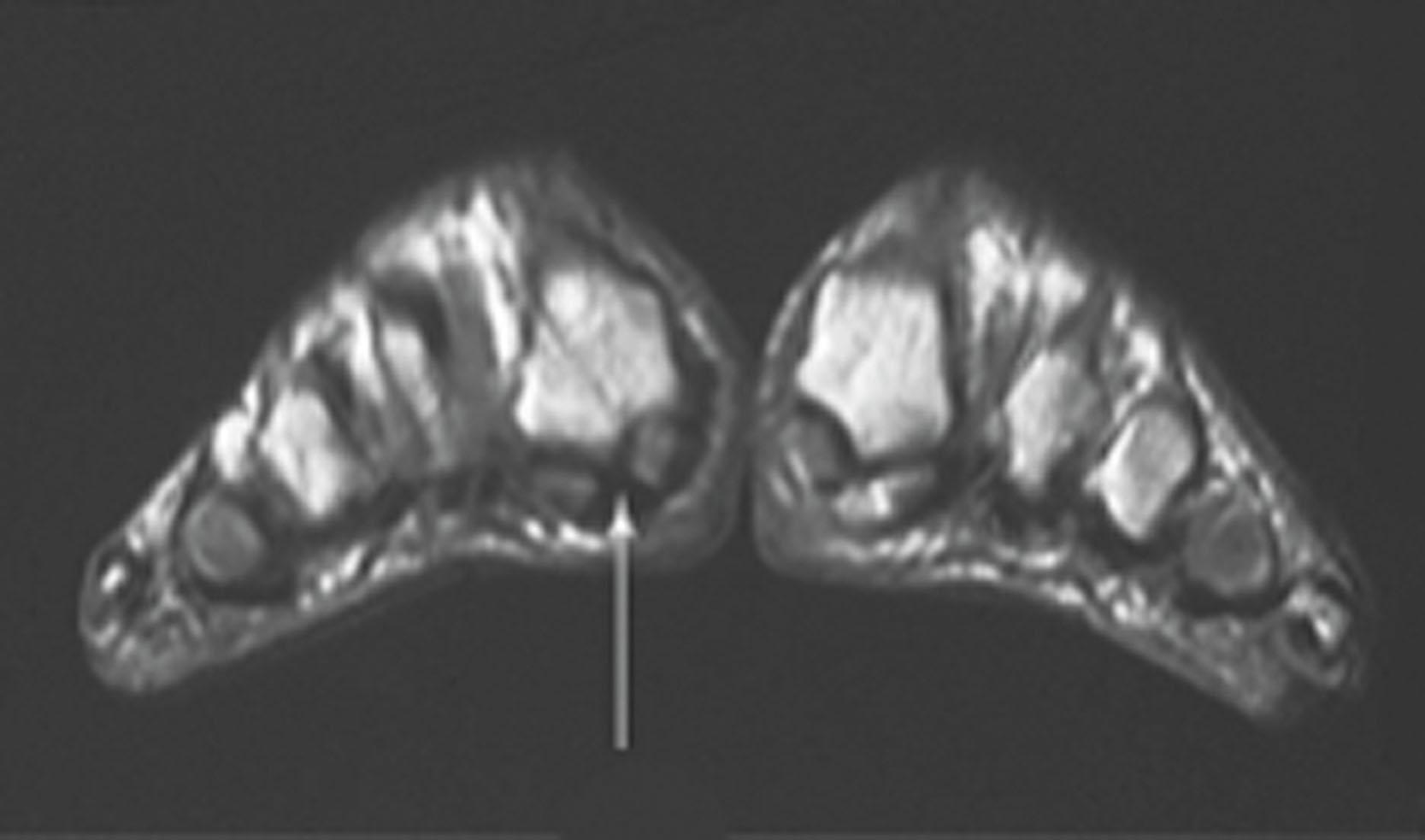
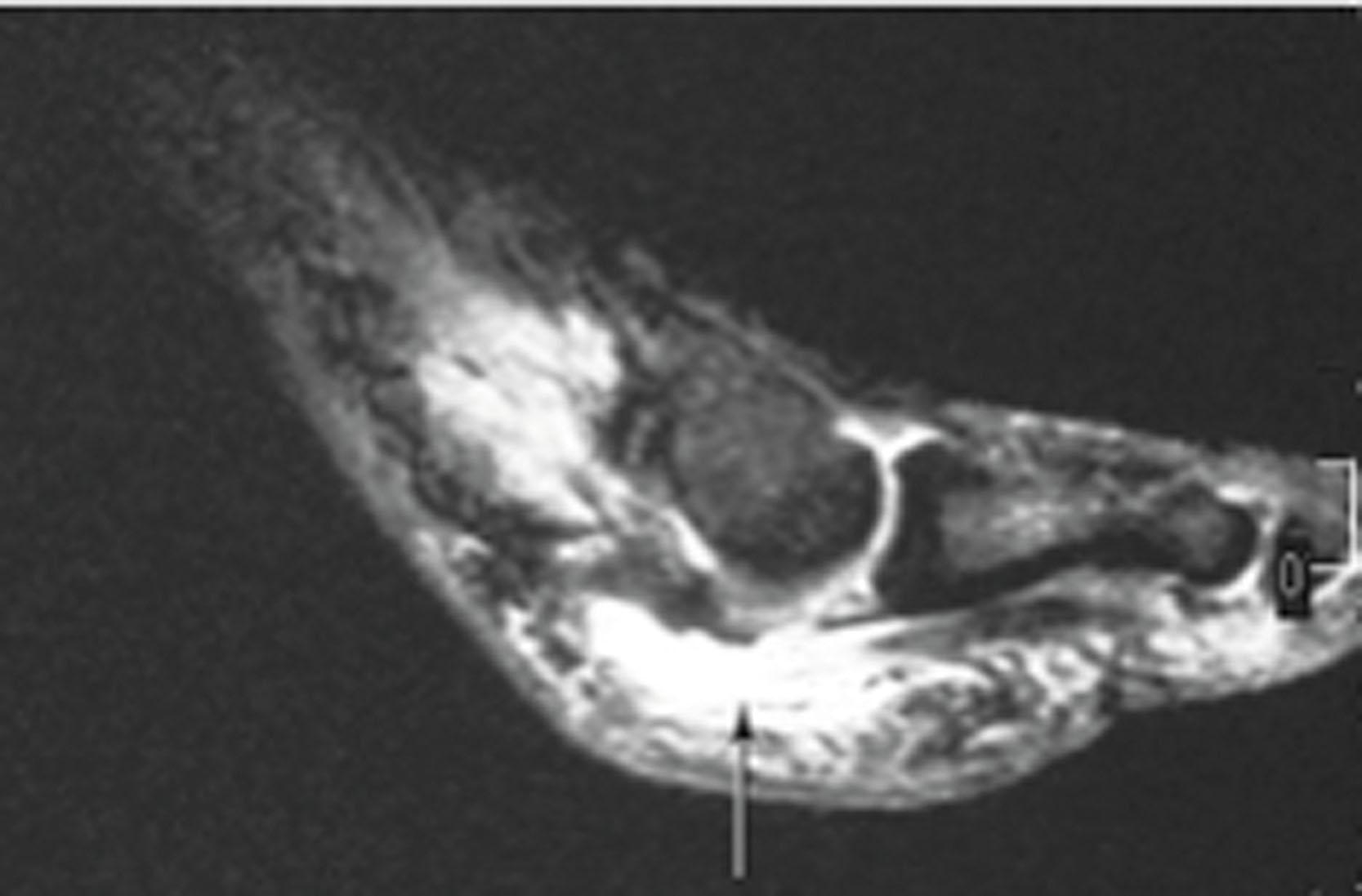

Yancey, in a survey of 88 foot and ankle surgeons, reported that 80% to 93% thought a primary repair of a disrupted FHL tendon was important, whereas only half thought the other lesser-toe flexor tendons were important to repair. Krackow observed that the strength of push-off may be improved after repair, and if the patient's physical and athletic activities require high performance, repair should be considered.
Frenette and Jackson recommended repair only if the tendon ends were easily found within the depths of the laceration. They noted that the distal FHL tendon can be tenodesed to the FHB tendon. However, disruption of both the FHL and the FHB tendons has a poor prognosis that can eventually lead to hyperextension of the hallux. Rasmussen and Thyssen repaired the FHL tendon after a distal rupture but observed minimal IP joint motion. They concluded that repair of the FHL tendon did not seem to be “essential in achieving good functional results in cases of rupture or laceration.”
An untreated FHL tendon laceration can lead to a cock-up deformity of the hallux. Thompson et al stated that hyperextension of the great toe was an indication for surgical intervention. The options are either primary repair for a distal rupture with acute open or closed trauma or tenodesis of the FHL and FDL tendons distal and proximal to the sustentaculum tali with a more proximal rupture. They further stated that although a tendon graft might be possible, it seemed “unnecessarily complex.” When a rupture is at or adjacent to the fibroosseous tunnel, a primary repair is often unsuccessful. In these cases, a tendon transfer using the FDL tendon to the second toe should be considered, particularly in active or athletic patients.
Become a Clinical Tree membership for Full access and enjoy Unlimited articles
If you are a member. Log in here